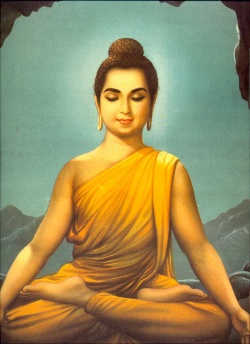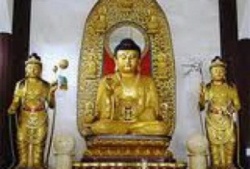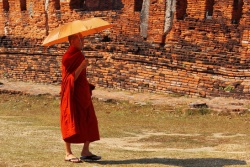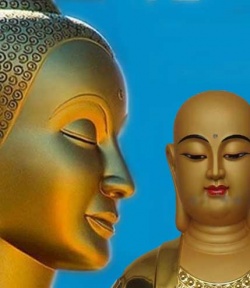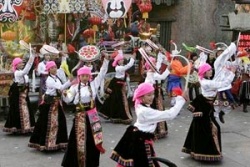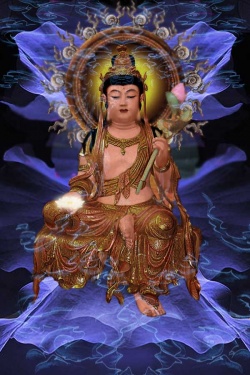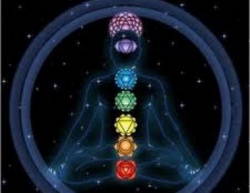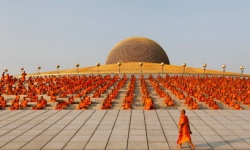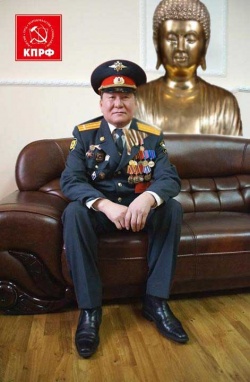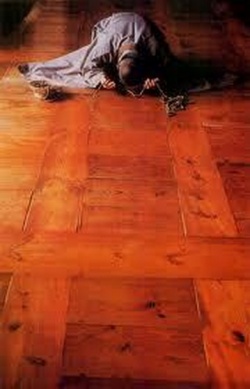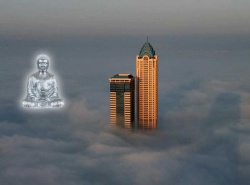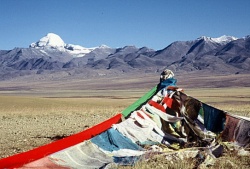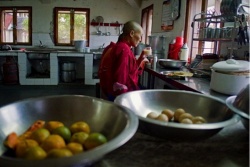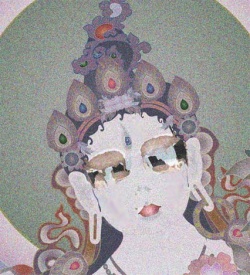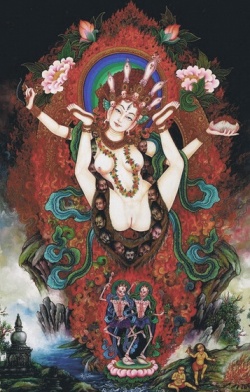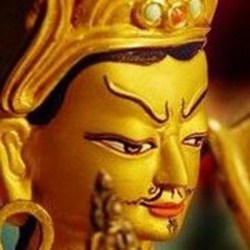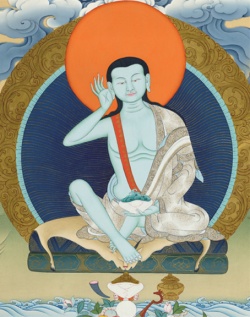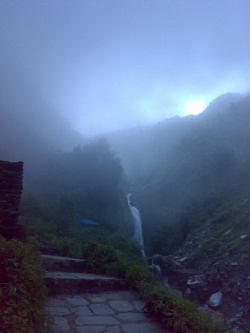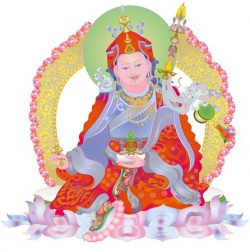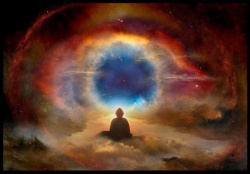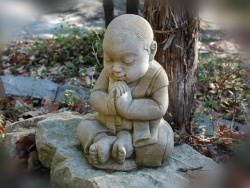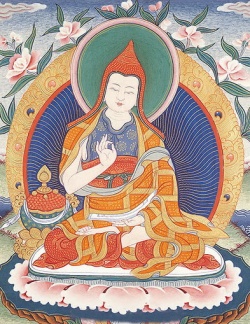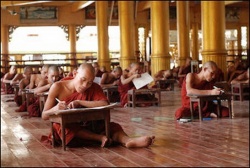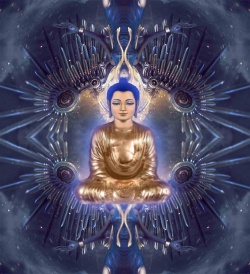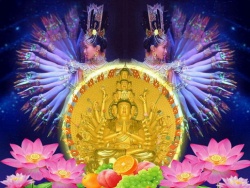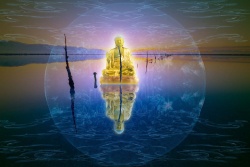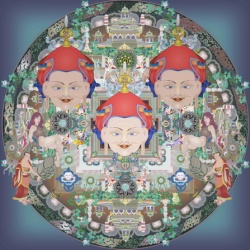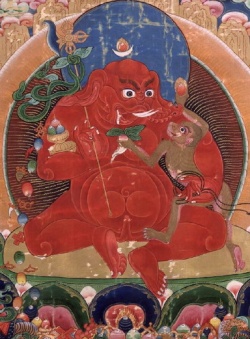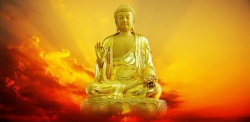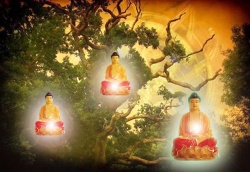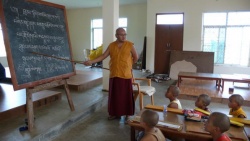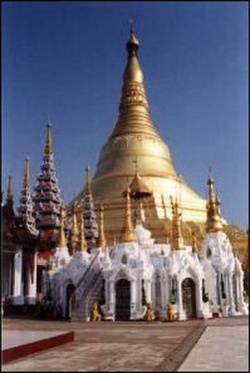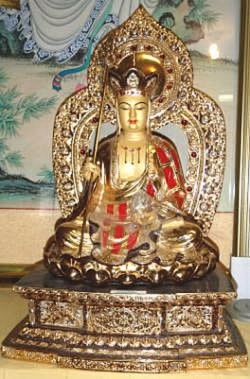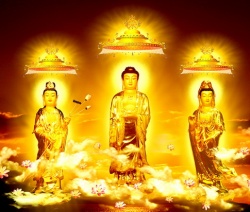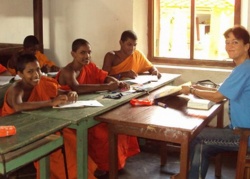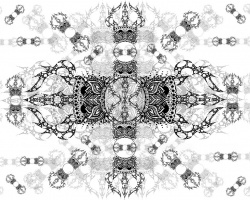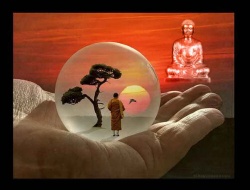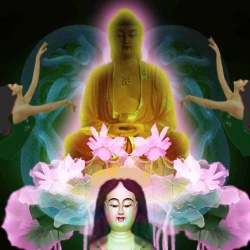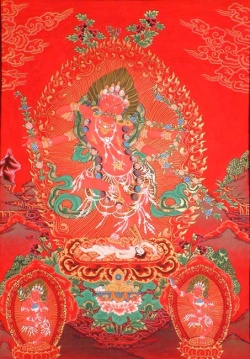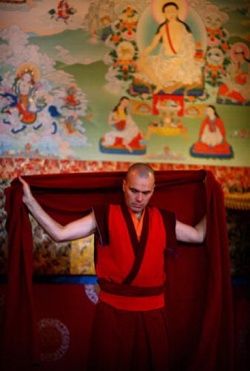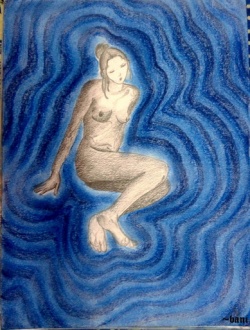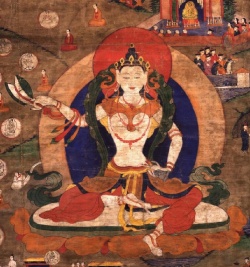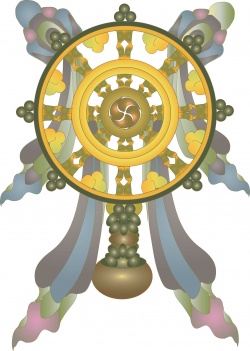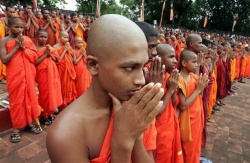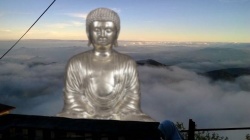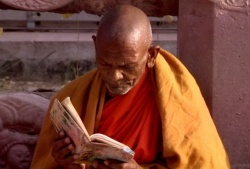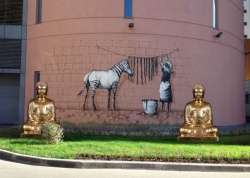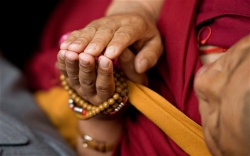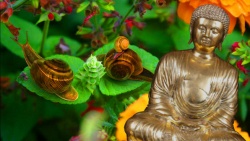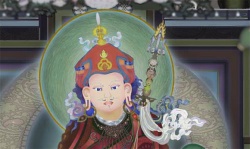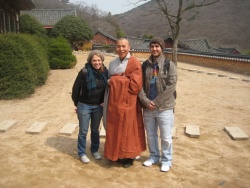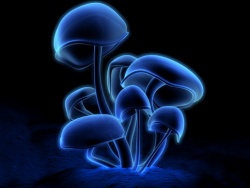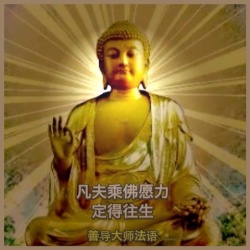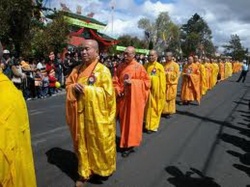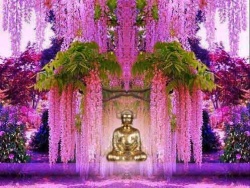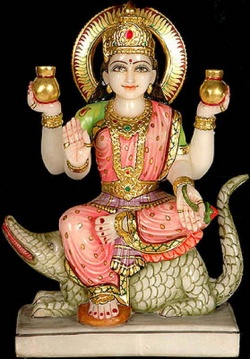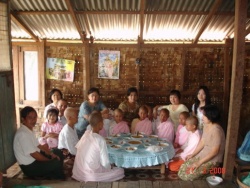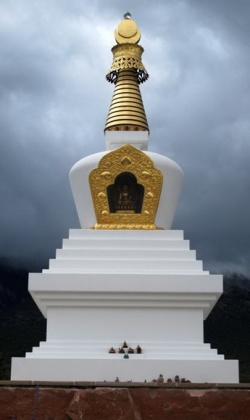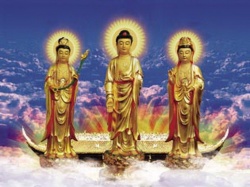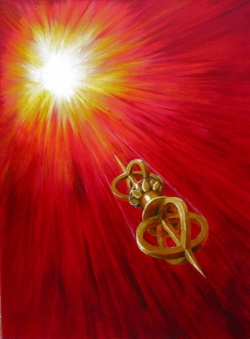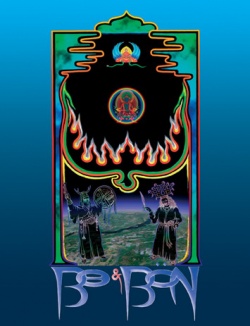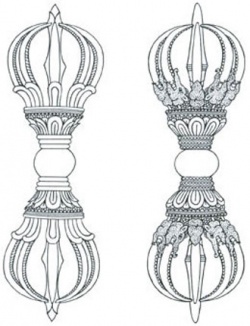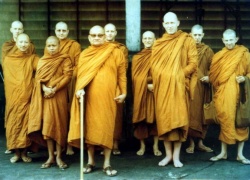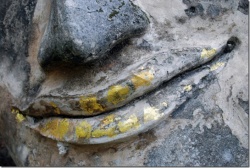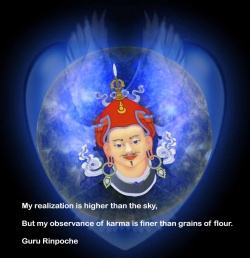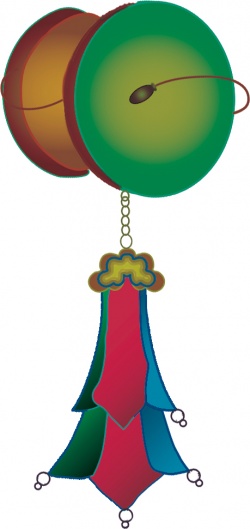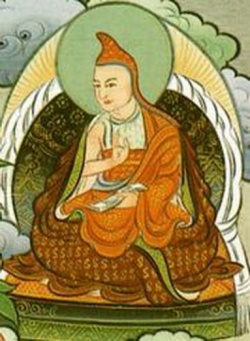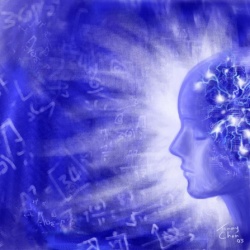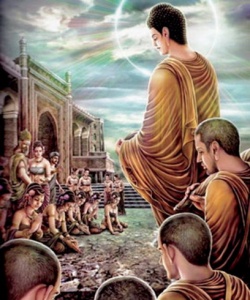Difference between revisions of "Gautama"
(Created page with "thumb|250px| Gautama - Buddha's family name, or last name. His first name was Siddhartha. {{R}} [http://uwacadweb.uwyo.edu/religionet/er/buddhism/BGLOSS...") |
m (Text replacement - "]]]" to "]])") |
||
| (12 intermediate revisions by 2 users not shown) | |||
| Line 1: | Line 1: | ||
| − | [[File:Buddha11.jpg|thumb|250px|]] | + | [[File:Buddha11.jpg|thumb|250px|]]<nomobile>{{DisplayImages|3517|1219|4106|3247|4384|1180|1928|3759|2459|3743|244|2937|1001|1198|111|3510|4000|280|3374|231|1294|191|1323|2401|4339|1273|4450|1251|309|368|200|4161|3322|2777|3463|1777|1190|3337|3608|3841|4245|1861|2244|54|590|1666|2273|4056|2548|327|3724|3312|1999|2657|176|2345|4399|4016|2316|3876|228|2868|3469|1708|3605|623|3606|2203|1350|4426|373|1625|1909|1046|1092}}</nomobile> |
| − | Gautama - Buddha's family name, or last name. His first name was Siddhartha. | + | |
| + | |||
| + | |||
| + | |||
| + | |||
| + | <poem> | ||
| + | [[Gautama]] - [[Buddha]]'s [[family]] [[name]], or last [[name]]. His first [[name]] was [[Siddhartha]]. | ||
| + | |||
| + | No comprehensive account of [[Gotama Buddha]] is as yet possible. The details given in this article are those generally accepted by [[orthodox]] [[Theravādins]] and contained in their [[books]], chiefly the [[Pāli]] Commentaries, more especially the [[Nidānakathā]] of the [[Jātaka]] and the [[Buddhavamsa]] Commentary. | ||
| + | |||
| + | Biographical details are also found in [[Mahā Vagga]] and the [[Culla]] [[Vagga]] of the [[Vinaya Pitaka]], the [[Buddhavamsa]] and in various scattered passages of the [[Nikayas]] of the [[Sutta Pitaka]]. References to these are given where considered useful. Controversy [[exists]] with regard to many of the matters mentioned; for [[discussion]] of the varying [[views]] regarding these, reference should be made to the works of [[Oldenberg]], [[Wikipedia:Thomas William Rhys Davids|Rhys Davids]] (both [[Professor]] and Mrs. [[Wikipedia:Thomas William Rhys Davids|Rhys Davids]]), Kern, E. J. Thomas and other [[scholars]]. Further particulars of persons and places mentioned can be obtained by reference to the articles under the respective names. | ||
| + | |||
| + | He was a [[Sākiyan]] (the [[Sākiyans]] were evidently [[subjects]] of the [[Kosala]] [[king]]; the [[Buddha]] calls himself a [[Kosalan]], M.ii.124), son of [[Suddhodana]] (all [[Pāli]] Commentaries and [[Sanskrit]] works represent the [[Buddha]] as the son of a [[king]], descendant of a long line of famous {{Wiki|ancestors}}), chief [[ruler]] of [[Kapilavatthu]], and of [[Mahā]] [[Māyā]], [[Suddhodana’s]] chief [[consort]], and he belonged to the [[Gotama-gotta]]. Before his {{Wiki|conception}} he was in the [[Tusita heaven]], waiting for the due time for his [[birth]] in his last [[existence]]. Then, having made the “five investigations” (pañcavilolcanāni) (see [[Buddha]]), he took leave of his companions and descended to [[earth]]. (According to the [[Lalitavistara]] he appointed the [[Bodhisatta]] [[Maitreya]] as [[king]] of [[Tusita]] in his place). Many wondrous and marvellous events attended his {{Wiki|conception}} and [[birth]]. (Given in the [[Acchariyabbhutadhamma Sutta]], M.iii.118f; also D.ii.12f. A more detailed account is found in J. i.47ff; both the Lai. and the Mtu.ii.14ff differ as to the details given here of the {{Wiki|conception}} and the [[birth]]). | ||
| + | |||
| + | The {{Wiki|conception}} takes place on the [[full-moon day]] of [[Āsālha]], with the [[moon]] in [[Uttarāsālha]], and [[Maya]] has no relations with her husband. She has a marvellous [[dream]] in which the [[Bodhisatta]], as a [[white elephant]], enters her [[womb]] through her side. When the [[dream]] is mentioned to the [[brahmins]], they foretell the [[birth]] of a son who will be either a [[universal monarch]] or a [[Buddha]]. An {{Wiki|earthquake}} takes place and [[thirty-two signs]] appear, presaging the [[birth]] of a [[great being]]. The first of these [[signs]] is a [[boundless]], great {{Wiki|light}}, flooding every corner of the ten thousand [[worlds]]; everyone beholds its glory, even the fires in all [[hells]] being [[extinguished]]. Ten months after the {{Wiki|conception}}, in the month of [[Visākha]], [[Māyā]] wishes to visit her [[parents]] in [[Devadaha]]. On the way thither from [[Kapilavatthu]] she passes the beautiful [[Lumbini grove]], in which she [[desires]] to wander; she goes to a great sāla-tree and seizes a branch in her hand; labour [[pains]] start immediately, and, when the courtiers retire, having drawn a curtain round her, even while [[standing]], she is delivered of the child. It is the day of the [[full moon]] of [[Visākha]]; four [[Mahābrahmas]] receive the babe in a golden net, and streams of [[water]] descend from the sky to wash him. The boy stands on the [[earth]], takes seven steps north-wards and utters his lion-roar, “I am the chief in the [[world]].” On the same day seven other [[beings]] were born: the [[Bodhi-tree]], [[Rāhula’s]] mother ([[Rāhulamātā]], his {{Wiki|future}} wife), the four Treasure-Troves (described at DA.i.284), his [[elephant]], his [[horse]] [[Kanthaka]], his charioteer [[Channa]], and [[Kāludāyī]]. The babe is escorted back to [[Kapilavatthu]] on the day of his [[birth]] and his mother [[dies]] seven days later. | ||
| + | |||
| + | The isi [[Asita]] (or [[Kāladevala]]), [[meditating]] in the [[Himālaya]], learns from the [[Tāvatimsa]] [[gods]] of the [[birth]] of the [[Buddha]], visits [[Suddhodana]] the same day and sees the boy, whom they both {{Wiki|worship}}. [[Asita]] weeps for [[sorrow]] that he will not live to see the boy’s [[Buddhahood]], but he instructs his nephew Nālaka (v.l. [[Naradatta]]) to prepare himself for that great day. On the fifth day after the [[birth]] is the {{Wiki|ceremony}} of name-giving. One hundred and eight [[brahmins]] are invited to the {{Wiki|festival}} at the palace; eight of them - {{Wiki|Rāma}}, [[Dhaja]], [[Lakkhana]], Manti, [[Kondañña]], [[Bhoja]], [[Suyāma]] and [[Sudatta]] - are interpreters of [[bodily]] marks, and all except [[Kondañña]] [[prophesy]] two possibilities for the boy; but [[Kondañña]], the youngest, says, quite decisively, that he will be a [[Buddha]]. The [[name]] given to the boy at this {{Wiki|ceremony}} is not actually mentioned, but from other passages it is inferred that it was [[Siddhattha]] (q.v.). | ||
| + | |||
| + | Among other incidents recounted of the [[Buddha’s]] boyhood is that of his [[attaining]] the [[first jhāna]] under a [[jambu-tree]]. One day he is taken to the [[state]] {{Wiki|ploughing}} of the [[king]] where [[Suddhodana]] himself, with his golden plough, ploughs with the {{Wiki|farmers}}. The nurses, attracted by the festivities, leave the child under a [[jambu-tree]]. They return to find him seated, cross-legged, in a [[trance]], the shadow of the [[tree]] remaining still, in order to {{Wiki|protect}} him. The [[king]] is informed and, for the second time, does reverence to his son. J. i.57f; MA.i.466f; the incident is alluded to in the [[Mahā Saccaka Sutta]] (M.i.246); the corresponding incident recounted in Mtu. (ii.45f.) takes place in a park, and the, details differ completely. The [[Lai]]. has two versions, one in prose and one in verse and both resemble the Mtu.; but in these the [[Buddha]] is represented as being much older. The Divy (391) and the [[Tibetan]] versions (e.g., Rockhill, p.22) put the incident very much later in the [[Buddha’s]] [[life]]. Other incidents are given in Lai. and Mtu. | ||
| + | |||
| + | The [[Bodhisatta]] is reported to have lived in the household for twenty-nine years a [[life]] of great {{Wiki|luxury}} and excessive ease, surrounded by all imaginable comforts. He owns three {{Wiki|palaces}} - [[Ramma]], [[Suramma]] and [[Subha]] - for the three seasons. Mention is made of his luxurious [[life]] in A.i.145; also in M.i.504; further details are given in AA.i.378f.; J. i.58. See also Mtu.ii.115; cf. Vin.i.15; D.ii.21. | ||
| + | |||
| + | When the [[Bodhisatta]] is sixteen years old, [[Suddhodana]] sends messengers to the [[Sākyans]] asking that his son be allowed to seek a wife from among their daughters; but the [[Sākyans]] are reluctant to send them, for, they say, though the young man is hand-some, he [[knows]] no [[art]]; how, then, can he support a wife? When this is reported to the {{Wiki|prince}}, he summons an assembly of the [[Sākyans]] and performs various feats, chief of these being twelve feats with a [[bow]] which needs the strength of one thousand men. (The feats with the [[bow]] are described in the [[Sarabhanga Jātaka]], J. v.129f ). The [[Sākyans]] are so impressed that each sends him a daughter, the total number so sent being forty thousand. The [[Bodhisatta]] appoints as his chief wife the daughter of [[Suppabuddha]], who, later, comes to be called [[Rāhulamātā]]. She is known under various names: [[Bhaddakaccā]] (or [[Kaccānā]]), [[Yasodharā]]. [[Bimbā]], [[Bimbasundarī]] and [[Gopā]]. For a [[discussion]] see [[Rāhulamātā]]. | ||
| + | |||
| + | According to the generally accepted account, [[Gotama]] is twenty-nine when the incidents occur which lead to final [[renunciation]]. Following the {{Wiki|prophecy}} of the eight [[brahmins]], his father had taken every precaution that his son should see no sign of [[old age]], [[sickness]] or [[death]]. But the [[gods]] decide that the time is come for the [[Enlightenment]], and instil into [[Gotama’s]] [[heart]] a [[desire]] to go into the park. On the way, the [[gods]] put before him a man showing [[signs]] of extreme age, and the [[Bodhisatta]] returns, filled with [[desire]] for [[renunciation]]. The [[king]], {{Wiki|learning}} this, surrounds him with even greater attractions, but on two other days [[Gotama]] goes to the park and the [[gods]] put before him a sick man and a corpse. (According to some accounts, e.g. that of the Dīghabhānakas, the four {{Wiki|omens}} were all seen on the same day, J. i.59) | ||
| + | |||
| + | On the [[full-moon day]] of [[Āsālha]], the day appointed for the [[Great Renunciation]], [[Gotama]] sees a [[monk]] and hears from his charioteer praise of the [[ascetic]] [[life]]. [[Feeling]] very [[happy]], he goes to the park to enjoy himself. [[Sakka]] sends [[Vissakamma]] himself to bathe and adorn him, and as [[Gotama]] returns to the city in all his majesty, he receives news of the [[birth]] of his son. Foreseeing in this news a bond, he decides to call the babe [[Rāhula]] (q.v.). [[Kisā Gotamī]] (q.v.) sees [[Gotama]] on the way to the palace and, filled with longing for him, sings to him a song containing the [[word]] [[nibbuta]]. The significance of the [[word]] (=[[extinguished]], at [[peace]]) thrills him, and he sends to [[Kisā]] his priceless {{Wiki|gold}} necklace which she, however, accepts as a token of [[love]]. [[Gotama]] enters the palace and sleeps. He wakes in the middle of the night to find his {{Wiki|female}} musicians [[sleeping]] in attitudes which fill him with {{Wiki|disgust}} and with loathing for the [[worldly life]], and he decides to leave it. (In some versions the [[Renunciation]] takes place seven days after the [[birth]] of [[Rāhula]], J. i.62). He orders [[Channa]] to saddle [[Kanthaka]], and enters his wife’s room for a last look at her and their son. | ||
| + | |||
| + | He leaves the city on his [[horse]] [[Kanthaka]], with [[Channa]] [[clinging]] to its tail. The [[devas]] muffle the [[sound]] of the [[horse’s]] hoofs and of his neighing and open the city gates for [[Gotama]] to pass. [[Māra]] appears before [[Gotama]] and seeks to stay him with a promise that he shall be [[universal monarch]] within seven days. On his offer being refused, [[Māra]] threatens to shadow him always. Outside the city, at the spot where later was erected the Kanthakanivattana-cetiya, [[Gotama]] turns his [[horse]] round to take a last look at [[Kapilavatthu]]. It is said that the [[earth]] actually turned, to make it easy for him to do so. Then, accompanied by the [[gods]], he rides thirty leagues through [[three kingdoms]] - those of the [[Sākyans]], the [[Koliyans]] and the {{Wiki|Mallas}} - and his [[horse]] crosses the [[river]] [[Anomā]] in one leap. On the other side, he gives all his ornaments to [[Channa]], and with his sword cuts off [[hair]] and beard, throwing them up into the [[air]], where [[Sakka]] takes them and enshrines them in the Cūlāmani-cetiya in [[Tāvatimsa]]. The [[Brahmā Ghatikāra]] offers [[Gotama]] the [[eight requisites]] of a [[monk]], which he accepts and adopts. He then sends [[Channa]] and [[Kanthaka]] back to his father, but [[Kanthaka]], broken-hearted, [[dies]] on the spot and is [[reborn]] as Kanthaka-devaputta. | ||
| + | |||
| + | The account given here is taken mainly from the [[Nidānakathā]] (J.i.59ff) and evidently [[embodies]] later [[tradition]]; cp. D.ii.21ff. From passages found in the [[Pitakas]] (e.g., A.i.145; M.i.163, 240; M.ii.212f.) it would appear that the events leading up to the [[Renunciation]] were not so dramatic as given here, the process being more [[gradual]]. I do not, however, agree with Thomas (op. cit., 58) that, according to these accounts, the [[Bodhisatta]] left the [[world]] when “quite a boy.” I think the [[word]] dahara is used merely to indicate “the prime of youth,” and not necessarily “boyhood.” The description of the [[Renunciation]] in the Lal. is very much more elaborate and adds numerous incidents, no account of which is found in the [[Pāli]]. | ||
| + | |||
| + | From [[Anomā]] the [[Bodhisatta]] goes to the mango-grove of [[Anupiya]], and after spending seven days there walks to [[Rājagaha]] (a distance of thirty leagues) in one day, and there starts his [[alms rounds]]. Bimbisāra’s men, noticing him, report the {{Wiki|matter}} to the [[king]], who sends messengers to enquire who this [[ascetic]] is. The men follow [[Gotama]] to the foot of the [[Pandavapabbata]], where he eats his meal, and they then go and report to the [[king]]. [[Bimbisāra]] visits [[Gotama]], and, [[pleased]] with his hearing, offers him the {{Wiki|sovereignty}}. On {{Wiki|learning}} the [[nature]] of [[Gotama’s]] quest, he wins from him a promise to visit [[Rājagaha]] first after the [[Enlightenment]]. | ||
| + | |||
| + | This incident is also mentioned in the [[Pabbajjā Sutta]] (Sn.vv.405-24), but there it is the [[king]] who first sees [[Gotama]]. It is significant that, when asked his [[Wikipedia:Identity (social science)|identity]], [[Gotama]] does not say he is a king’s son. The [[Pali]] version of tile [[sutta]] contains nothing of [[Gotama’s]] promise to visit [[Rājagaha]], but the Mtu. version (ii.198-200), which places the visit later, has two verses, one of which contains the request and the other the [[acceptance]]; and the SnA. (ii.385f.), too, mentions the promise and tells that [[Bimbisāra]] was informed of the {{Wiki|prophecy}} concerning [[Gotama]]. There is another version of the Mtu. (ii.117-20) which says that [[Gotama]] went straight to [[Vaisāli]] after leaving home, joining Ālāra, and later visited [[Uddaka]] at [[Rājagaha]]. Here no mention is made of [[Bimbisāra]]. We are told in the Mhv. (ii.25ff) that [[Bimbisāra]] and [[Gotama]] ([[Siddhattha]]) had been playmates, [[Bimbisāra]] being the younger by five years. Bimbisāra’s father (Bhātī) and [[Suddhodana]] were friends. | ||
| + | |||
| + | Journeying from [[Rājagaha]], [[Gotama]] in due | ||
| + | course becomes a [[disciple]] of [[Ālāra-Kālāma]]. Having learnt and practised all that [[ālāra]] has to teach, he finds it unsatisfying and joins [[Uddaka-Rāmaputta]]; but [[Uddaka’s]] [[doctrine]] leaves him still unconvinced and he abandons it. He then goes to [[Senānīgāma]] in [[Uruvelā]] and there, during six years, practises all manner of severe austerities, such as no man had previously undertaken. Once he falls fainting and a [[deva]] informs [[Suddhodana]] that [[Gotama]] is [[dead]]. But [[Suddhodana]], relying on the {{Wiki|prophecy}} of [[Kāladevala]], refuses to believe the news. [[Gotama’s]] mother, now born as a [[devaputta]] in [[Tāvatimsa]], comes to him to encourage him. At [[Uruvelā]], the [[Pañcavaggiya]] [[monks]] are his companions, but now, having realised the folly of extreme [[asceticism]], he decides to abandon it, and starts again to take normal [[food]]; thereupon the [[Pañcavaggiyas]], disappointed, leave him and go to [[Isipatana]]. | ||
| + | |||
| + | J.i.66f. The [[Therīgāthā]] Commentary | ||
| + | (p.2) mentions another [[teacher]] of [[Gotama]], named [[Bhaggava]], whom [[Gotama]] visited | ||
| + | before [[Ālāra]]. Lal. (330 [264]) contains a very elaborate account of [[Gotama’s]] | ||
| + | visits to [[teachers]]; he goes first to two [[brahmin]] women, Sākī and [[Padmā]], then | ||
| + | to [[Raivata]] and Rajaka, son of [[Trimandika]], and finally (as far as this [[chapter]] | ||
| + | is concerned) to [[Ālāra]] at [[Vaisāli]]. A poem containing an account of the meeting | ||
| + | of [[Gotama]] with [[Bimbisāra]] is inserted into this account. The next [[chapter]] tells | ||
| + | of [[Uddaka]]. An account of [[Gotama’s]] visits to [[teachers]] and of the details of his | ||
| + | austerities is also given in the [[Mahā Saccaka Sutta]], already referred to | ||
| + | (M.i.240ff); the [[Mahā]] [[Sīhanāda Sutta]] (M.i.77ff) contains a long and detailed | ||
| + | account of his extreme asceticisms. See also M.i.163ff; ii.93f. | ||
| + | |||
| + | [[Gotama’s]] [[desire]] for normal [[food]] is satisfied by an [[offering]] brought by [[Sujātā]] to the [[Ajapāla]] [[banyan tree]] under which he is seated. She had made a [[vow]] to the [[tree]], and her wish having been granted, she takes her slave-girl, [[Punnā]], and goes to the [[tree]] prepared to fulfil her promise. They take [[Gotama]] to be the [[Tree-god]], come in [[person]] to accept her [[offering]] of [[milk-rice]]; the [[offering]] is made in a golden [[bowl]] and he takes it joyfully. Five [[dreams]] he had the night before convince [[Gotama]] that he will that day become the [[Buddha]]. (The [[dreams]] are, recounted in A.iii.240 and in Mtu.ii.136f). It is the [[full-moon day]] of [[Visākha]]; he bathes at [[Suppatittha]] in the [[Nerañjarā]], eats the [[food]] and launches the [[bowl]] up {{Wiki|stream}}, where it sinks to the abode of the [[Nāga king]], [[Kāla]] ([[Mahākāla]]). | ||
| + | |||
| + | [[Gotama]] spends the rest of the day in a [[sāla-grove]] and, in the evening, goes to the foot of the [[Bodhi-tree]], accompanied by various [[divinities]]; there the grass-cutter [[Sotthiya]] gives him eight handfuls of grass; these, after [[investigation]], [[Gotama]] spreads on the eastern side of the [[tree]], where it becomes a seat fourteen hands long, on which he sits cross-legged, determined not to rise before [[attaining]] [[Enlightenment]]. | ||
| + | |||
| + | J.i.69. The [[Pitakas]] know nothing of [[Sujātā’s]] [[offering]] or of [[Sotthiya’s]] [[gift]]. Lal. (334-7 [267-70]) mentions ten girls in all who provide him with [[food]] during his austerities. Divy (392) mentions two, [[Nandā]] and [[Nandabalā]]. | ||
| + | |||
| + | [[Māra]], [[lord of the world]] of [[passion]], is determined to prevent this fulfilment, and attacks [[Gotama]] with all the strength at his command. His {{Wiki|army}} extends twelve leagues to the front, right, and left of him, to the end of the [[Cakkavāla]] behind him, and nine leagues into the sky above him. [[Māra]] himself carries numerous [[weapons]] and rides the [[elephant]] [[Girimekhala]], one hundred and fifty leagues in height. At the [[sight]] of him all the [[divinities]] [[gathered]] at the [[Bodhi-tree]] to do honour to [[Gotama]] - the great [[Brahmā]], [[Sakka]], the [[Nāga-king]] [[Mahākāla]] - disappear in a flash, and [[Gotama]] is left alone with the ten [[pāramī]], long practised by him, as his sole [[protection]]. All [[Māra’s]] attempts to frighten him by means of storms and {{Wiki|terrifying}} apparitions fail, and, in the end, [[Māra]] hurls at him the [[Cakkāvudha]]. It remains as a {{Wiki|canopy}} poised over [[Gotama]]. The very [[earth]] bears {{Wiki|witness}} to [[Gotama’s]] fitness to be the [[Enlightened One]], and [[Girimekhala]] kneels before him. [[Māra]] is vanquished and flees headlong with his vast {{Wiki|army}}. The various [[divinities]] who had fled at the approach of [[Māra]] now return to [[Gotama]] and exult in his {{Wiki|triumph}}. | ||
| + | |||
| + | The whole story of the contest with [[Māra]] is, obviously, a [[mythological]] [[development]]. It is significant that in the [[Majjhima]] passages referred to earlier there is no mention of [[Māra]], of a {{Wiki|temptation}}, or even of a [[Bodhi-tree]]; but see D.ii.4 and Thomas (op. cit., n.1). According to the [[Kālingabodhi Jātaka]], which, very probably, [[embodies]] an old [[tradition]], the [[bodhi-tree]] was [[worshipped]] even in the [[Buddha’s]] [[life-time]]. The [[Māra]] legend is, however, to be found in the {{Wiki|Canonical}} [[Padhāna Sutta]] of the [[Sutta Nipāta]]. This perhaps contains the first suggestion of the legend. For a [[discussion]] see [[Māra]]. | ||
| + | |||
| + | [[Gotama]] spends that night in deep [[meditation]]. In the first watch he gains [[remembrance]] of his former [[existences]]; in the middle watch he attains the [[divine eye]] ([[dibbacakkhu]]); in the last watch he revolves in his [[mind]] the [[Chain of Causation]] ([[paticcasamuppāda]]). As he [[masters]] this, the [[earth]] trembles and, with the dawn, comes [[Enlightenment]]. He is now the supreme [[Buddha]], and he breaks forth into a paean of [[joy]] ([[udāna]]). | ||
| + | |||
| + | There is great [[doubt]] as to which were these [[Udāna]] verses. The [[Nidānakathā]] and the Commentaries generally quote two verses (153, 154) included in the [[Dhammapada]] collection ([[anekajāti samsāram]] etc.). The [[Vinaya]] (i.2) quotes three different verses (as does also DhsA.17), and says that one verse was repeated at the end of each watch, all the watches being occupied with [[meditation]] on the [[paticcasamuppāda]]. Mtu. (ii.286) gives a completely different [[Udāna]], and in another place (ii.416) mentions a different verse as the first [[Udāna]]. The [[Tibetan]] [[Vinaya]] is, again, quite different (Rockhill, p.33). For a [[discussion]] see Thomas, op. cit., 75ff. | ||
| + | |||
| + | For the first [[week]] the [[Buddha]] remains under the [[Bodhi-tree]], [[meditating]] on the [[Paticcasamuppāda]]; the second [[week]] he spends at the [[Ajapālanigrodha]], where the “Huhuhka” [[Brahmin]] accosts him ([[Mara]] now comes again and asks the [[Buddha]] to [[die]] at once; D.ii.112) and where [[Mara’s]] daughters, [[Tanhā]], [[Aratī]] and [[Rāgā]], appear before the [[Buddha]] and make a last attempt to shake his resolution (J.i.78; S. i.124; Lal.490 (378)); the third [[week]] he spends under the hood of the nāga-king [[Mucalinda]] (Vin.i.3); the fourth [[week]] is spent in [[meditation]] under the Rājāyatana [[tree]]*; at the end of this period takes place the [[conversion]] of [[Tapussa]] and [[Bhallika]]. They [[take refuge]] in the [[Buddha]] and the [[Dhamma]], though the [[Buddha]] does not give them any instruction. | ||
| + | |||
| + | *This is the [[Vinaya]] account | ||
| + | (Vin.i.1ff); but the [[Jātaka]] (i.77ff, extends this period to seven weeks, the | ||
| + | additional weeks being inserted between the first and second. The [[Buddha]] | ||
| + | spends one [[week]] each at the [[Animisa-cetiya]], the [[Ratanacankama]] and the | ||
| + | [[Ratanaghara]], and this last is where he [[thinks]] out the [[Abhidhamma Pitaka]]. | ||
| + | |||
| + | [[Doubts]] now assail the [[Buddha]] as to whether he shall proclaim to the [[world]] his [[doctrine]], so recondite, so hard to understand. The [[Brahma Sahampati]] (according to J. i.81, with the [[gods]] of the thousand [[worlds]], including [[Sakka]], [[Suyāma]], [[Santusita]], [[Sunimmita]], [[Vasavatti]], etc.) appears before him and assures him there are many prepared to listen to him and to profit by his [[teaching]], and so entreats him to teach the [[Dhamma]]. The [[Buddha]] accedes to his request and, after [[consideration]], decides to teach the [[Dhamma]] first to the [[Pañcavaggiyas]] at [[Isipatana]]. On the way to [[Benares]] he meets the [[ājīvaka]] [[Upaka]] and tells him that he (the [[Buddha]]) is [[Jina]]. | ||
| + | |||
| + | On his arrival at [[Isipatana]] the [[Pañcavaggiyas]] are, at first, reluctant to [[acknowledge]] his claim to be the [[Tathāgata]], but they let themselves be won over and, on the [[full-moon day]] of [[Āsālha]], the [[Buddha]] preaches to them the {{Wiki|sermon}} which came to be known as the [[Dhammacakkappavattana Sutta]]. (Vin.i.4ff; M.i.118ff; cp. D.ii.36ff. Regarding the claim of this [[sutta]] to be the [[Buddha’s]] [[first sermon]], see Thomas, op. cit., p.86; see also [[Pañcavaggiyā]]). At the end of the {{Wiki|sermon}} [[Kondañña]] becomes a [[sotāpanna]] and they all become [[monks]]. | ||
| + | |||
| + | This {{Wiki|sermon}} is followed five days later by the [[Anattalakkhana Sutta]], at the conclusion of which all five become [[arahants]]. The following day the [[Buddha]] meets [[Yasa]], whom he converts. [[Yasa’s]] father, who comes seeking him, is the first to take the threefold [[formula]] of [[Refuge]]. | ||
| + | |||
| + | |||
| + | [[Yasa]] becomes an [[arahant]] and is [[ordained]]. | ||
| + | |||
| + | |||
| + | The [[Buddha]] accepts a meal at his house, and Yasa’s mother and one of his former wives are the first two lay-women to become the [[Buddha’s disciples]]. Then four friends of [[Yasa]] and, afterwards, fifty more, enter the Order and become [[arahants]]. There are now sixty [[arahants]] besides the [[Buddha]], and they are sent in different [[directions]] to {{Wiki|preach}} the [[Dhamma]]. They return with many candidates for admission to the Order, and the [[Buddha]], who up till now had [[ordained]] men with the “ehi [[bhikkhu]]” [[formula]], now allows the [[monks]] themselves to perform the [[ceremony of ordination]] (Vin.i.15ff; J. i.81f). | ||
| + | |||
| + | |||
| + | After spending the [[rainy season]] at [[Benares]] (about this time [[Māra]] twice tries to tempt the [[Buddha]], once after he had sent the [[disciples]] out to {{Wiki|preach}} and once after the [[Retreat]], S. i.105, 111; Vin.i.21, 22), the [[Buddha]] returns to Senānigāma in [[Uruvela]], on the way converting and ordaining the thirty Bhaddavaggiyā. At [[Uruvela]], after a long and protracted exercise of [[magical powers]], consisting in all of three thousand five hundred [[miracles]], the [[Buddha]] wins over the three [[Kassapa]] brothers, the Tebhātika Jatilā, with their thousand followers, and ordains them. They become [[arahants]] after listening to the [[Ādittapariyāya Sutta]] [[preached]] at [[Gayāsīsa]]; with these followers he visits [[Rājagaha]], where [[King]] [[Seniya]] [[Bimbisāra]] comes to see him at the [[Latthivanuyyāna]]. The following day the [[Buddha]] and the [[monks]] visit the palace, preceded by [[Sakka]] disguised as a youth and singing the praises of the [[Buddha]]. After the meal, the [[king]] gifts [[Veluvana]] to the [[Buddha]] and the Order. The [[Buddha]] stays for two months at [[Rājagaha]] (BuA.4), and it is during this time that [[Sāriputta]] and [[Moggallāna]] join the Order, through the instrumentality of [[Assaji]] (Vin.i.23ff). It was probably during this year, at the beginning of the [[rainy season]], that the [[Buddha]] visited [[Vesāli]] at the request of the [[Licchavis]], conveyed through [[Mahāli]]. The city was [[suffering]] from pestilence and famine. The [[Buddha]] went, [[preached]] the [[Ratana Sutta]] and dispelled all dangers (DhA.iii.436ff). | ||
| + | |||
| + | |||
| + | The number of converts now rapidly increases and the [[people]] of [[Magadha]], alarmed by the prospect of childlessness, widow-hood, etc., blame the [[Buddha]] and his [[monks]]. The [[Buddha]], however, refutes their charges (Vin.i.42f). | ||
| + | |||
| + | |||
| + | The account of the first twenty years of | ||
| + | the [[Buddha’s ministry]] is summarised from various sources, chiefly from Thomas’s admirable account in his [[Life]] and Legend of the [[Buddha]] (pp.97ff). The necessary references are to be found under the names mentioned. | ||
| + | |||
| + | On the [[full-moon day]] of [[Phagguna]] (February-March) the [[Buddha]], accompanied by twenty thousand [[monks]], sets out for [[Kapilavatthu]] at the express request of his father, conveyed through [[Kāludāyī]]. (This visit is not mentioned in the [[Canon]]; but see Thag.527-36; AA.i.107, 167; J.i.87; DhA.i.96f; ThagA.i.997ff). | ||
| + | |||
| + | By slow stages he arrives at the city, where he stays at the [[Nigrodhārāma]], and, in order to convince his proud kinsmen of his power, performs the [[Yamakapātihārjya]] and then relates the [[Vessantara Jātaka]]. The next day, receiving no invitation to a meal, the [[Buddha]] begs in the streets of the city; this deeply grieves [[Suddhodana]], but later, {{Wiki|learning}} that it is the {{Wiki|custom}} of all [[Buddhas]], he becomes a [[sotāpanna]] and conducts the [[Buddha]] and his [[monks]] to meal at the palace. There all the women of the palace, excepting only [[Rāhulamātā]], come and do reverence to the [[Buddha]]. [[Mahā Pajāpatī]] becomes a [[sotāpanna]] and [[Suddhodana]] a [[sakadāgāmi]]. The [[Buddha]] visits [[Rāhulamātā]] in her [[own]] apartments and utters her praises in the [[Candakinnara Jātaka]]. The following day the [[Buddha]] persuades his half-brother, [[Nanda]], to come to the [[monastery]], where he ordains him and, on the seventh day, he does the same with [[Rāhula]]. This is too great a blow for [[Suddhodana]], and at his request the [[Buddha]] {{Wiki|rules}} that no [[person]] shall be [[ordained]] without the consent of his [[parents]]. The next day the [[Buddha]] preaches to [[Suddhodana]], who becomes an [[anāgāmī]]. During the [[Buddha’s]] visit to [[Kapilavatthu]], eighty thousand [[Sākyans]] join the Order, one from each [[family]]. With these he returns to [[Rājagaha]], stopping on the way at [[Anupiya]], where [[Anuruddha]], [[Bhaddiya]], [[Ananda]], [[Bhagu]], [[Kimbila]] and [[Devadatta]], together with their barber, [[Upāli]], visit him and seek [[ordination]]. | ||
| + | |||
| + | On his return to [[Rājagaha]] the [[Buddha]] resides in the [[Sītavana]]. (J.i.92, the story is also told in the [[Vinaya]] ii.154, but no date is indicated). There [[Sudatta]], later known as [[Anāthapindika]], visits him, is converted, and invites him to [[Sāvatthi]]. The [[Buddha]] accepts the invitation and journeys through [[Vesāli]] to [[Sāvatthi]], there to pass the [[rainy season]]. (Vin.ii.158; but see BuA.3, where the [[Buddha]] is mentioned as having spent the [[vassa]] in [[Rājagaha]]). [[Anāthapindika]] gifts [[Jetavana]], provided with every necessity, for the residence of the [[Buddha]] and his [[monks]]. Probably to this period belongs the [[conversion]] of [[Migāra]], father-in-law of [[Visākhā]], and the construction, by [[Visākhā]], of the [[Pubbārāma]] at [[Sāvatthi]]. The [[vassa]] of the fourth year the [[Buddha]] spends at [[Veluvana]], where he converts [[Uggasena]]. (DhA.iv.59f). In the fifth year [[Suddhodana]] [[dies]], having realised [[arahant-ship]], and the [[Buddha]] flies through the [[air]], from the [[Kūtāgārasālā]] in [[Vesāli]] where he was staying, to {{Wiki|preach}} to his father on his death-bed. According to one account it is at this time that the quarrel breaks out between the [[Sākyans]] and the [[Koliyans]] regarding the irrigation of the [[river]] [[Rohinī]]. (AA.i.186; SnA.i.357; ThigA.141; details of the quarrel are given in J. v.412ff). The [[Buddha]] persuades them to make [[peace]], and takes up his abode in the [[Nigrodhārāma]]. [[Mahā Pajāpatī Gotamī]], with other [[Sākiyan]] women, visits him there and asks that women may be allowed to join the Order. Three times the request is made, three times refused, the [[Buddha]] then returning to [[Vesāli]]. The women cut off their [[hair]], don [[yellow]] [[robes]] and follow him thither. [[Ananda]] intercedes on their behalf and their request is granted. (Vin.ii.253ff; A.iv.274f.; for details see [[Mahā]] [[Pajāpati]]). | ||
| + | |||
| + | In the sixth year the [[Buddha]] again | ||
| + | performs the [[Yamakapātihāriya]], this time at the foot of the [[Gandamba tree]] in [[Sāvatthi]]. Prior to this, the [[Buddha]] had forbidden any display of [[magic]] [[powers]], but makes an exception in his [[own]] case (DhA.iii.199f.; J. iv.265, etc.). | ||
| + | |||
| + | He spends the [[vassa]] at [[Mankulapabbata]]. | ||
| + | After the performance of the [[miracle]] he follows the {{Wiki|custom}} of all [[Buddhas]] and ascends to [[Tāvatimsa]] in three strides to {{Wiki|preach}} the [[Abhidhamma]] to his mother who is born there as a [[deva]], and there he keeps the seventh [[vassa]]. The multitude, [[gathered]] at [[Sāvatthi]] at the [[Yamakapātihāriya]], refuse to go away until they have seen him. For three months, therefore, [[Moggallāna]] expounds to them the [[Dhamma]], while [[Culla]] [[Anāthapindika]] provides them with [[food]]. During the preaching of the [[Abhidhamma]], [[Sāriputta]] visits the [[Buddha]] daily and learns from him all that has been recited the previous day. At the end of the [[vassa]], the [[Buddha]] descends a jewelled staircase and comes to [[earth]] at [[Sankassa]], thirty leagues from [[Sāvatthi]]. (For details see Devorohana). It was about this time, when the [[Buddha’s]] [[fame]] was at its height, that the notorious Ciñcā-mānavikā was persuaded by members of some {{Wiki|hostile}} [[sect]] to bring a vile accusation against the [[Buddha]]. A similar story, told in connection with a paribbājikā named [[Sundarī]], probably refers to a later date. | ||
| + | |||
| + | The eighth year the [[Buddha]] spends in the country of the [[Bhaggas]] and there, while residing in [[Bhesakalāvana]] near [[Sumsumāragiri]], he meets [[Nakulapitā]] and his wife, who had been his [[parents]] in five hundred former [[births]] (A.A.i.217). | ||
| + | |||
| + | The same is told of another old couple in [[Sāketa]]. See the [[Sāketa Jātaka]]. The [[Buddha]] evidently stayed again at Sumsumāragiri many years later. It was during his second visit that Bodhirājakumāra (q.v.) invited him to a meal at his new palace in order that the [[Buddha]] might [[consecrate]] the building by his presence. | ||
| + | |||
| + | In the ninth year the [[Buddha]] is at [[Kosambī]]. While on a visit to the [[Kuru]] country he is [[offered]] in [[marriage]] Māgandiyā, the beautiful daughter of the [[brahmin]] [[Māgandiyā]]. The refusal of the offer, accompanied by insulting remarks about [[physical]] [[beauty]], arouses the [[enmity]] of Māgandiyā who, thenceforward, cherishes [[hatred]] against the [[Buddha]]. | ||
| + | |||
| + | Sn., pp.163ff; SnA.ii.542ff; DhA.i.199ff | ||
| + | Thomas (op. cit., 109) assigns the Māgandiyā incident to the ninth year. I am not sure if this is correct, for the Commentaries say the [[Buddha]] was then living at [[Sāvatthi]]. | ||
| + | |||
| + | In the tenth year there arises among the [[monks]] at [[Kosambī]] a [[schism]] which threatens the very [[existence]] of the Order. The [[Buddha]], failing in his attempts to reconcile the disputants, retires in {{Wiki|disgust}} to the [[Pārileyyaka]] {{Wiki|forest}}, passing on his way through [[Bālakalonakāragāma]] and [[Pācīnavamsadāya]]. In the {{Wiki|forest}} he is protected and waited upon by a friendly [[elephant]] who has left the herd. The [[Buddha]] spends the [[rainy season]] there and returns to [[Sāvatthi]]. By this time the [[Kosambī]] [[monks]] have recovered their [[senses]] and ask the [[Buddha’s]] pardon. This is granted and the dispute settled. (Vin.i.337ff; J. iii.486f; DhA.i.44ff; but see Ud.iv.5; s.v. [[Pārileyyaka]]). | ||
| + | |||
| + | In the eleventh year the [[Buddha]] resides at the [[brahmin]] village of [[Ekanālā]] and converts [[Kasi-Bhāradvāja]] (Sn., p.12f.; S.i.172f). The twelfth year he spends at [[Verañjā]], keeping the [[vassa]] there at the request of the [[brahmin]] [[Verañja]]. But [[Verañja]] forgets his obligations; there is a famine, and five hundred horse-merchants supply the [[monks]] with [[food]]. [[Moggallāna’s]] offer to obtain [[food]] by means of [[magic power]] is discouraged (Vin.iii.1ff; J. iii.494f; DhA.ii.153). The thirteenth [[Retreat]] is kept at Cālikapabbata, where [[Meghiya]] is the [[Buddha’s]] personal attendant (A.iv.354; Ud.iv.1). The fourteenth year is spent at [[Sāvatthi]], and there [[Rāhula]] receives the [[upasampadā]] [[ordination]]. | ||
| + | |||
| + | In the fifteenth year the [[Buddha]] revisits [[Kapilavatthu]], and there his father-in-law, [[Suppabuddha]], in a drunken fit, refuses to let the [[Buddha]] pass through the streets. Seven days later he is swallowed up by the [[earth]] at the foot of his palace (DhA.iii.44). | ||
| + | |||
| + | The chief event of the sixteenth year, which the [[Buddha]] spent at [[Ālavī]], is the [[conversion]] of the [[yakkha]] [[Ālavaka]]. In the seventeenth year the [[Buddha]] is back at [[Sāvatthi]], but he visits [[Ālavī]] again out of [[compassion]] for a poor farmer who becomes a [[sotāpanna]] after hearing him {{Wiki|preach}} (DhA.iii.262ff). He spends the [[rainy season]] at [[Rājagaha]]. In the next year he again comes to [[Ālavī]] from [[Jetavana]] for the sake of a poor weaver’s daughter. She had heard him {{Wiki|preach}}, three years earlier, on the desirability of [[meditating]] upon [[death]]. She alone gave heed to his admonition and, when the [[Buddha]] [[knows]] of her imminent [[death]], he journeys thirty leagues to {{Wiki|preach}} to her and establish her in the [[sotāpattiphala]] (DhA.iii.170ff). | ||
| + | |||
| + | The [[Retreat]] of this year and also that of the nineteenth are spent at [[Cālikapabbata]]. In the twentieth year takes place the miraculous [[conversion]] of the robber [[Angulimāla]]. He becomes an [[arahant]] and [[dies]] shortly after. It is in the same year that [[Ananda]] is appointed [[permanent]] attendant on the [[Buddha]], a position which he holds to the end of the [[Buddha’s]] [[life]], twenty-five years later (For details see [[Ananda]]). The twentieth [[Retreat]] is spent at [[Rājagaha]]. | ||
| + | |||
| + | With our {{Wiki|present}} [[knowledge]] it is impossible to evolve any kind of {{Wiki|chronology}} for the remaining twenty-five years of the [[Buddha’s]] [[life]]. The Commentaries [[state]] that they were spent at [[Sāvatthi]] in the [[monasteries]] of [[Jetavana]] and [[Pubbārāma]]. (E.g., BuA.3; SnA. p.336f, says that when the [[Buddha]] was at [[Sāvatthi]], he spent the day at the Migāramātupāsāda in the [[Pubbārāma]], and the night at [[Jetavana]] or [[vice versa]]). | ||
| + | |||
| + | This, probably, only implies that the [[Retreats]] were kept there and that they were made the head quarters of the [[Buddha]]. From there, during the dry season, he went every year on tour in various districts. Among the places visited by him during these tours are the following: | ||
| + | |||
| + | Aggālavacetiya, [[Anotatta]], [[Andhakavinda]], | ||
| + | [[Ambapālivana]], Ambalatthikā, Ambasandā, [[Assapura]], Āpana, [[Icchānangala]], [[Ukkatthā]] | ||
| + | (Subhagavana), Ukkācelā, [[Ugganagara]], [[Ujuññā]] (Kannakatthaka [[deer-park]]), [[Uttara]] | ||
| + | in [[Koliya]], Uttarakā, [[Uttarakuru]], Uruvelakappa, {{Wiki|Ulumpa}}, Ekanālā, [[Opasāda]], | ||
| + | Kakkarapatta, [[Kajangalā]] ([[Mukheluvana]]), Kammāssadhamma, [[Kalandakanivāpa]] (near | ||
| + | [[Benares]]), Kimbilā, Kītāgiri, Kundadhānavana (near Kundakoli), [[Kesaputta]], | ||
| + | Kotigāma, [[Kosambī]] ([[Ghositārāma]] and [[Badarikārāma]]), Khānumata, {{Wiki|Khomadussa}}, | ||
| + | [[Gosingasālavana]], Candalakappa, [[Campā]] ([[Gaggarā]]), Cātuma, [[Cetiyagiri]] in [[Vesāli]], | ||
| + | Jīvakambavana (in [[Rājagaha]]), Tapodārāma, Tindukkhānu ([[paribbājakārāma]]), | ||
| + | [[Todeyya]], Thullakotthita, [[Dakkhināgiri]], Dandakappa, [[Devadaha]], [[Desaka]] in the | ||
| + | [[Sumbha]] country, Nagaraka, [[Nagaravinda]], [[Nādikā]] ([[Giñjakāvasatha]]), [[Nālandā]] (Pāvārika | ||
| + | mango-grove), Nālakapāna (Palāsavana), Pankadhā, Pañcasalā, Pātikārāma, {{Wiki|Beluva}}, | ||
| + | the [[Brahma world]], Bhaddavatī, [[Bhaddiya]] ([[Jātiyāvana]]), Bhaganagara (Anandacetiya), | ||
| + | Maninālakacetiya, Mana-sākata, Mātulā, [[Mithilā]] ([[Makhādeva]] mango-grove), | ||
| + | Medatalumpa, Moranivāpa, Rammaka’s [[hermitage]], [[Latthivana]], [[Videha]], | ||
| + | Vedhañña-ambavana, [[Venāgapura]], [[Verañjā]], Veludvāra, [[Vesāli]] (also various | ||
| + | [[shrines]] there, Udenacetiya, Gotamacetiya, Cāpalacetiya, Bahuputta-kacetiya, | ||
| + | Sattambacetiya, Sārandadacetiya), {{Wiki|Sakkara}}, Sajjanela, Salalāgāraka in | ||
| + | [[Sāvatthi]], [[Sāketa]] ([[Añjanavana]]), Sāmagāma, Sālavatikā, [[Sālā]], Simsapāvana, | ||
| + | Silāvatī, [[Sītavana]], Sūkarakhatalena, [[Setavyā]], [[Hatthigāma]], Halidavassana and | ||
| + | the region of the [[Himālaya]]. | ||
| + | |||
| + | There is a more or less continuous account of the last year of the [[Buddha’s]] [[life]]. This is contained in three [[suttas]]: the [[Mahā]] [[Parinibbāna]], the [[Mahā]] [[Sudassana]] and the [[Janavasabha]]. These are not separate [[discourses]] but are intimately connected with each other. The only event prior to the incidents recounted in these [[suttas]], which can be fixed with any {{Wiki|certainty}}, is the [[death]] of the [[Buddha’s]] pious {{Wiki|patron}} and supporter, [[Bimbisāra]], which took place eight years before the [[Buddha’s]] [[Parinibbāna]] (Mhv.ii.32). It was at this time that [[Devadatta]] tried to obtain for himself a post of supremacy in the Order, and, failing in this [[effort]], became the open enemy of the [[Buddha]]. [[Devadatta’s]] [[desire]] to deprive the [[Buddha]] of the [[leadership]] of the [[Sangha]] seems to have been [[conceived]] by him, according to the [[Vinaya]] account (Vin.ii.184), almost immediately after he joined the Order, and the [[Buddha]] was warned of this by the [[devaputta]] [[Kakudha]]. This account lends point to the statement contained especially in the Northern [[books]], that even in their lay [[life]] [[Devadatta]] had always been [[Gotama’s]] rival. | ||
| + | |||
| + | Enlisting the support of [[Ajātasattu]], he | ||
| + | tried in many ways to kill the [[Buddha]]. {{Wiki|Royal}} archers were bribed to shoot the [[Buddha]], but they were won over by his [[personality]] and confessed their {{Wiki|intentions}}. Then [[Devadatta]] hurled a great rock down [[Gijjhakūta]] on to the [[Buddha]] as he was walking in the shade of the hill; the hurtling rock was stopped by two peaks, but splinters struck the [[Buddha’s]] foot and [[caused]] {{Wiki|blood}} to flow; he [[suffered]] great [[pain]] and had to be taken to the [[Maddakucchi]] [[garden]], where his injuries were dressed by the [[physician]] [[Jīvaka]] (S.i.27). The [[monks]] wished to provide a guard, but the [[Buddha]] reminded them that no man had the power to deprive a [[Tathāgata]] of his [[life]]. | ||
| + | |||
| + | [[Devadatta]] next bribed the {{Wiki|royal}} [[elephant]] | ||
| + | keepers to let loose a fierce [[elephant]], [[Nālāgiri]], {{Wiki|intoxicated}} with toddy, on the road along which the [[Buddha]] would go, begging for [[alms]]. The [[Buddha]] was warned of this but disregarded the warning, and when the [[elephant]] appeared, [[Ananda]], against the strict orders of the [[Buddha]], threw himself in its [[path]], and only by an exercise of iddhi-power, including the folding up of the [[earth]], could the [[Buddha]] come ahead of him. As the [[elephant]] approached, the [[Buddha]] addressed it, pervading it with his [[boundless]] [[love]], until it became quite gentle. (This incident, with great [[wealth]] of detail, is related in several places - e.g., in J.v.333ff). | ||
| + | |||
| + | These attempts to encompass the [[Buddha’s death]] having failed, [[Devadatta]], with three others, decides to create a [[schism]] in the Order and asks the [[Buddha]] that five {{Wiki|rules}} should be laid down, whereby the [[monks]] would be compelled to lead a far more [[austere]] [[life]] than hitherto. When this request is refused, [[Devadatta]] persuades five hundred recently [[ordained]] [[monks]] to leave [[Vesāli]] with him and take up their residence at [[Gayāsīsa]], where he would set up an organisation similar to that of the [[Buddha]]. But, at the [[Buddha’s]] request, [[Sāriputta]] and [[Moggallāna]] visit the renegade [[monks]]; [[Sāriputta]] preaches to them and they are persuaded to return. When [[Devadatta]] discovers this, he vomits [[hot]] {{Wiki|blood}} and lies ill for nine months. When his end approaches, he wishes to see the [[Buddha]], but he [[dies]] on the way to [[Jetavana]] - whither he is being conveyed in a litter - and is born in [[Avīci]]. | ||
| + | |||
| + | From [[Gijjhakūta]], near [[Rājagaha]], the | ||
| + | [[Buddha]] starts on his last journey. Just before his departure he is visited by Vassākāra, and the talk is of the [[Vajjians]]; the [[Buddha]] preaches to Vassākāra and the [[monks]] on the [[conditions]] that lead to [[prosperity]]. The [[Buddha]] proceeds with a large concourse of [[monks]] to Ambalatthikā and thence to [[Nālandā]], where [[Sāriputta]] utters his lion-roar (sīhanāda) regarding his [[faith]] in the [[Buddha]]. The [[Buddha]] then goes to Pātaligāma, where he talks to the villagers on the [[evil]] {{Wiki|consequences}} of immorality and the advantages of [[morality]]. He utters a {{Wiki|prophecy}} regarding the {{Wiki|future}} greatness of [[Pātaliputta]] and then, leaving by the [[Gotamadvāra]], he crosses the [[river]] [[Ganges]] at [[Gotamatittha]]. He proceeds to Kotigāma and thence to Ñātika, where he gives to [[Ananda]] the [[formula]] of the [[Dhammādāsa]], whereby the [[rebirth]] of [[disciples]] could be ascertained. From Ñātika he goes to [[Vesāli]], staying in the park of the {{Wiki|courtesan}} [[Ambapāli]]. The following day he accepts a meal from [[Ambapāli]], refusing a similar offer from the [[Licchavis]]; [[Ambapāli]] makes a [[gift]] of her park to the [[Buddha]] and his [[monks]]. The [[Buddha]] journeys on to {{Wiki|Beluva}}, where he spends the [[rainy season]], his [[monks]] remaining in [[Vesāli]]. At {{Wiki|Beluva}} he falls dangerously ill but, with great [[determination]], fights against his [[sickness]]. He tells [[Ananda]] that his [[mission]] is finished, that when he is [[dead]] the Order must maintain itself, taking the [[Dhamma]] alone as its [[refuge]], and he concludes by propounding the [[four subjects]] of [[mindfulness]] (D.ii.100). The next day he begs in [[Vesāli]] and, with [[Ananda]], visits the Cāpāla-cetiya. There he gives to [[Ananda]] the opportunity of asking him to live until the end of the [[kappa]], but [[Ananda]] fails to take the hint. Soon afterwards [[Māra]] visits the [[Buddha]] and obtains the assurance that the [[Buddha’s]] [[nibbāna]] will take place in three months. There is an {{Wiki|earthquake}}, and, in answer to [[Ananda’s]] questions, the [[Buddha]] explains to him the eight [[causes]] of earthquakes. This is followed by lists of the eight assemblies, the eight stages of [[mastery]] and the eight stages of [[release]]. The [[Buddha]] then repeats to [[Ananda]] his [[conversation]] with [[Māra]], and [[Ananda]] now makes his request to the [[Buddha]] to prolong his [[life]], but is told that it is now too late; several opportunities he has had, of which he has failed to avail himself. The [[monks]] are assembled in [[Vesāli]], in the Service Hall, and the [[Buddha]] exhorts them to practise the [[doctrines]] he has [[taught]], in order that the [[religious]] [[life]] may last long. He then announces his impending [[death]]. | ||
| + | |||
| + | According to the Commentaries (e.g., | ||
| + | DA.ii.549), after the [[rainy season]] spent at {{Wiki|Beluva}}, the [[Buddha]] goes back to [[Jetavana]], where he is visited by [[Sāriputta]], who is preparing for his [[own]] [[Parinibbāna]] at Nālakagāma. From [[Jetavana]] the [[Buddha]] went to [[Rājagaha]], where Mahā-Moggallāna [[died]]. Thence he proceeded to Ukkācelā, where he spoke in praise of the two chief [[disciples]]. From Ukkācelā he proceeded to [[Vesāli]] and thence to Bhandagāma. [[Rāhula]], too, predeceased the [[Buddha]] (DA.ii.549). | ||
| + | |||
| + | The next day, returning from [[Vesāli]], he | ||
| + | looks round at the city for the last time and goes on to Bhandagāma; there he preaches on the four things the [[comprehension]] of which destroys rebirth-noble conduct, earnestness in [[meditation]], [[wisdom]] and freedom. | ||
| + | |||
| + | He then passes through the villages of | ||
| + | [[Hatthigāma]], Ambagāma and Jambugama, and stays at Bhoganagara at the Ananda-cetiya. There he addresses the [[monks]] on the Four Great Authorities (Mahāpadesā), by reference to which the true [[doctrine]] may be determined (Cf. A.ii.167ff). From Bhoganagara the [[Buddha]] goes to [[Pāvā]] and stays in the mango-grove of [[Cunda]], the smith. [[Cunda]] serves him with a meal which includes [[sūkaramaddava]]. (There is much dispute concerning this [[word]]. See Thomas, op. cit., 149, n.3). The [[Buddha]] alone partakes of the [[sūkaramaddava]], the remains being [[Wikipedia:burial|buried]]. This is the [[Buddha’s]] last meal; sharp [[sickness]] arises in him, with flow of {{Wiki|blood}} and [[violent]], deadly [[pains]], but the [[Buddha]] controls them and sets out for [[Kusinārā]]. On the way he has to sit down at the foot of a [[tree]]. [[Ananda]] fetches him [[water]] to drink from the {{Wiki|stream}} [[Kakutthā]], over which five hundred carts had just passed; but, through the power of the [[Buddha]], the [[water]] is quite clear. Here the [[Buddha]] is visited by Pukkusa, the Mallan, who is converted and presents the [[Buddha]] with a pair of gold-coloured [[robes]]. The [[Buddha]] puts them on and [[Ananda]] notices the marvellous [[brightness]] and clearness of the [[Buddha’s body]]. The [[Buddha]] tells him that the [[body]] of a [[Buddha]] takes on this hue on the night before his [[Enlightenment]] and on the night of his passing away, and that he will [[die]] that night at [[Kusinārā]]. He goes to the Kākutthā, bathes and drinks there and rests in a mango-grove. There he instructs [[Ananda]] that steps must be taken to dispel any [[remorse]] that [[Cunda]] may [[feel]] regarding the meal he gave to the [[Buddha]]. | ||
| + | |||
| + | From [[Kakutthā]] the [[Buddha]] crosses the | ||
| + | [[Hiraññavatī]] to the Upavattana sāla-grove in [[Kusinārā]]. There [[Ananda]] prepares for him a bed with the head to the [[north]]. All the [[trees]] break forth into blossom and [[flowers]] cover the [[body]] of the [[Buddha]]. [[Divine]] mandārava-flowers and [[sandalwood]] powder fall from the sky, and [[divine]] [[music]] and singing [[sound]] through the [[air]]. But the [[Buddha]] says that the greater honour to him would be to follow his teachings. | ||
| + | |||
| + | The [[gods]] of the ten [[thousand world systems]] assemble to pay their last homage to the [[Buddha]], and [[Upavāna]], who stands fanning him, is asked to move away as he obstructs their view. | ||
| + | |||
| + | [[Ananda]] asks for instruction on several | ||
| + | points, including how the [[funeral]] [[rites]] should be performed; he then goes out and abandons himself to a fit of weeping; the [[Buddha]] sends for him, consoles him and speaks his praises. [[Ananda]] tries to persuade the [[Buddha]] not to [[die]] in a mud-and-wattle village, such as is [[Kusinārā]], but the [[Buddha]] tells him how it was once the mighty [[Kusāvatī]], capital of [[Mahāsudassana]]. | ||
| + | |||
| + | The {{Wiki|Mallas}} of Kusināra are informed that | ||
| + | the [[Buddha]] will pass away in the third watch of the night, and they come with their families to pay their respects. The [[ascetic]] [[Subhadda]] comes to see the [[Buddha]] and is refused admission by [[Ananda]], but the [[Buddha]], overhearing, calls him in and converts him. Several minor {{Wiki|rules}} of [[discipline]] are delivered, including the order for the excommunication of [[Channa]]. The [[Buddha]] finally asks the assembled [[monks]] to speak out any [[doubts]] they may have. All are [[silent]] and [[Ananda]] expresses his astonishment, but the [[Buddha]] tells him it is natural that the [[monks]] should have no [[doubts]]. Then, addressing the [[monks]] for the last time, he admonishes them in these words: “[[Decay]] is [[inherent]] in all component things; work out your {{Wiki|salvation}} with [[diligence]].” These were the [[Buddha’s]] last words. Passing backwards and forwards through various stages of [[trance]], he attains [[Parinibbāna]]. There is a great {{Wiki|earthquake}} and {{Wiki|terrifying}} [[thunder]], and the [[Brahmā Sahampati]], [[Sakka]] [[king of the gods]], [[Anuruddha]] and [[Ananda]] utter [[stanzas]], each proclaiming the [[feeling]] uppermost in his [[mind]]. It is the [[full-moon day]] of the month of [[Visākha]] and the [[Buddha]] is in his eightieth year. | ||
| + | |||
| + | The next day [[Ananda]] informs the {{Wiki|Mallas}} | ||
| + | of [[Kusinārā]] of the [[Buddha’s death]], and for seven days they hold a great celebration. On the seventh day, following [[Ananda’s]] instructions, they prepare the [[body]] for [[cremation]], taking it in procession by the eastern gate to the Makutabandhana [[shrine]], thus altering their proposed route, in order to satisfy the wishes of the [[gods]], as communicated to them by [[Anuruddha]]. The whole town is covered knee-deep with mandārava-flowers, which fall from the sky. When, however, four of the chief {{Wiki|Mallas}} try to {{Wiki|light}} the pyre, their attempt is unsuccessful and they must wait until [[Mahā Kassapa]], coming with a company of five hundred [[monks]], has saluted it. The Commentaries (e.g., DA.ii.603) add that [[Mahā Kassapa]] greatly [[desired]] that the [[Buddha’s]] feet should rest on his head when he [[worshipped]] the pyre. The wish was granted: the feet appeared through the pyre, and when [[Kassapa]] had [[worshipped]] them, the pyre closed together. The pyre burns completely away, leaving no cinders nor soot. Streams of [[water]] fall from the sky to extinguish it and the {{Wiki|Mallas}} pour on it scented [[water]]. They then place a fence of spears around it and continue their {{Wiki|celebrations}} for seven days. At the end of that period there appear several claimants for the [[Buddha’s]] [[relics]]: [[Ajātasattu]], the [[Licchavis]] of [[Vesāli]], the [[Sākiyans]] of [[Kapilavatthu]], the Bulis of Allakappa, the [[Koliyas]] of Rāmagāma, a [[brahmin]] of Vethadīpa and the {{Wiki|Mallas}} of [[Pāvā]]. But the {{Wiki|Mallas}} of [[Kusinārā]] refusing to share the [[relics]] with the others, there is [[danger]] of [[war]]. Then the [[brahmin]] [[Dona]] counsels [[concord]] and divides the [[relics]] into eight {{Wiki|equal}} parts for the eight claimants. [[Dona]] takes for himself the [[measuring]] vessel and the Moriyas of Pipphalivana, who arrive late, carry off the ashes. [[Thūpas]] were built over these remains and feasts held in honour of the [[Buddha]]. | ||
| + | |||
| + | S | ||
| + | |||
| + | The complete passing away. | ||
| + | |||
| + | |||
| + | |||
| + | The concluding passage of the | ||
| + | Mahā-Parinibbāna [[Sutta]] (D.ii.167) states that the [[Buddha’s]] [[relics]] were eight measures, seven of which were honoured in [[Jambudīpa]] and the remaining one in the [[Nāga]] [[realm]] in Rāmagāma. One tooth was in [[heaven]], one in [[Gandhāra]], a third in [[Kālinga]] (later taken to [[Ceylon]]), and a fourth in the [[Nāga world]]. [[Ajātasattu’s]] share was deposited in a [[thūpa]] and forgotten. It was later discovered by [[Asoka]] (with the help of [[Sakka]]) and distributed among his eighty-four thousand [[monasteries]]. [[Asoka]] also recorded the finding of all the other [[relics]] except those deposited in Rāmagāma. These were later deposited in the Mahācetiya at [[Anurādhapura]] (Mhv.Xxxi.17ff). Other [[relics]] are also mentioned, such as the [[Buddha’s]] collar-bone, his [[alms bowl]], etc. (Mhv.Xvii.9ff; Mhv.i.37, etc.). | ||
| + | |||
| + | It is said (E.g., DA.iii.899) that just | ||
| + | before the [[Buddha’s]] [[Sāsana]] disappears completely from the [[world]], all the [[relics]] will [[gather]] together at the Mahācetiya, and travelling from there to [[Nāgadīpa]] and the Ratanacetiya, assemble at the [[Mahābodhi]], together with the [[relics]] from other parts. There they will reform the [[Buddha’s]] golden hued [[body]], emitting the six-coloured [[Wikipedia:aura (paranormal)|aura]]. The [[body]] will then catch [[fire]] and completely disappear, amid the [[lamentations]] of the ten thousand [[world-systems]]. | ||
| + | |||
| + | The [[Ceylon]] Chronicles (Mhv.i.12ff; | ||
| + | Dpv.i.45ff; ii.1ff etc.) record that the [[Buddha]] visited the [[Island]] on three separate occasions. | ||
| + | |||
| + | (The [[Burmese]] claim that the [[Buddha]] | ||
| + | visited their land and went to the Lohitacandana [[Vihāra]], presented by the | ||
| + | brothers Mahāpunna and Cūlapunna of Vānijagāma (Ind. Antiq.xxii., and | ||
| + | Sās.36f.). | ||
| + | |||
| + | The first was while he was dwelling at | ||
| + | [[Uruvelā]], awaiting the [[moment]] for the [[conversion]] of the Tebhātika [[Jatilas]], in the ninth month after the [[Enlightenment]], on the [[full-moon day]] of [[Phussa]] (Dec. Jan.). He came to the [[Mahānāga]] [[garden]], and stood in the [[air]] over an assembly of [[yakkhas]] then being held. He struck {{Wiki|terror}} into their hearts and, at his suggestion, they left [[Ceylon]] and went in a [[body]] to Giridīpa, hard by. The [[Buddha]] gave a handful of his [[hair]] to the [[deva]] Mahāsumana of the Sumanakūta mountain, who built a [[thūpa]] which was later enlarged into the [[Mahiyangana]] [[Thūpa]]. The [[Buddha]] again visited [[Ceylon]] in the fifth year, on the [[new-moon]] day of [[Citta]] (March-April), to check an imminent {{Wiki|battle}} between two [[Nāga]] chiefs in [[Nāgadīpa]]; the combatants were [[Mahodara]] and [[Cūlodara]], uncle and nephew, and the [[object]] of the quarrel was a gem-set [[throne]]. The [[Buddha]] appeared before them, accompanied by the [[deva]] Samiddhi-Sumana, carrying a Rājayatana [[tree]] from [[Jetavana]], settled their quarrel and received, as a [[gift]], the [[throne]], the [[cause]] of the trouble. He left behind him both the [[throne]] and the Rājayatana [[tree]] for the {{Wiki|worship}} of the [[Nāgās]] and accepted an invitation from the [[Nāga king]], [[Maniakkhika]] of [[Kalyāni]], to pay another visit to [[Ceylon]]. Three years later [[Maniakkhika]] repeated the invitation and the [[Buddha]] came to [[Kalyāni]] with five hundred [[monks]], on the second day of [[Vesākha]]. Having [[preached]] to the [[Nāgas]], he went to Sumanakūta, on the summit of which mountain he left the imprint of his foot (Legend has it that other footprints were left by the [[Buddha]], on the bank of the [[river]] Nammadā, on the Saccabaddha mountain and in Yonakapura). He then stayed at Dīghavāpī and from there visited [[Mahāmeghavana]], where he [[consecrated]] various spots by [[virtue]] of his presence, and proceeded to the site of the later Silācetiya. From there he returned to [[Jetavana]]. | ||
| + | |||
| + | Very little [[information]] as to the | ||
| + | [[personality]] of the [[Buddha]] is available. We are told that he was golden-hued (E.g., Sp.iii.689), that his {{Wiki|voice}} had the eight qualities of the Brahmassāra (E.g., D.ii.211; M.ii.166f. It is said that while an [[ordinary person]] spoke one [[word]], [[Ananda]] could speak eight; but the [[Buddha]] could speak sixteen to the eight of [[Ananda]], MA.i.283) - fluency, intelligibility, sweetness, audibility, continuity, distinctness, depth and resonance - that he had a fascinating [[personality]] - he was described by his opponents as {{Wiki|seductive}} (E.g., M.i.269, 275) - that he was handsome, {{Wiki|perfect}} alike in complexion and stature and [[noble]] of presence (E.g., M.ii.167). He had a unique reputation as a [[teacher]] and trainer of the [[human]] [[heart]]. He was endowed with the [[thirty-two marks]] of the [[Mahāpurisa]]. (For details of these, see [[Buddha]]). There is a legend that [[Mahā Kassapa]], though slightly shorter, resembled the [[Buddha]] in [[appearance]]. | ||
| + | |||
| + | Attempts made, however, to measure the | ||
| + | [[Buddha]] always failed; two such attempts are generally mentioned - one by a [[brahmin]] of [[Rājagaha]] and the other by [[Rāhu]], chief of the [[Asuras]] (DA.i.284f). The [[Buddha]] had the [[physical]] strength of many millions of [[elephants]] (e.g., VibhA.397), but his strength quickly ebbed away after his last meal and he had to stop at twenty-five places while travelling three [[gāvutas]] from [[Pāvā]] to Kusināra (DA.ii.573). | ||
| + | |||
| + | Mention is often made of the [[Buddha’s]] | ||
| + | [[love]] of quiet and [[peace]], and even the {{Wiki|heretics}} respected his wishes in this {{Wiki|matter}}, silencing their discussions at his approach (E.g., D.i.178f; iii.39; even his [[disciples]] had a similar reputation, e.g., D.iii.37). Examples are given of the [[Buddha]] refusing to allow noisy [[monks]] to live near him. (E.g., M.i.456; see also M.ii.122, where a [[monk]] was jogged by his neighbour because he coughed when the [[Buddha]] was {{Wiki|speaking}}). He loved [[solitude]] and often spent long periods away from the haunts of men, allowing only one [[monk]] to bring him his meals. E.g., S. v.12, 320; but this very [[love]] of [[solitude]] was sometimes brought against him. By intercourse with whom does he attain to [[lucidity]] in [[wisdom]]? they asked. His [[insight]], they said, was ruined by his [[Wikipedia:Habit (psychology)|habit]] of [[seclusion]] (D.iii.38). | ||
| + | |||
| + | According to one account (A.i.181), it | ||
| + | was his practice to spend part of the day in [[seclusion]], but he was always ready to see anyone who urgently [[desired]] his [[spiritual]] counsel (E.g., A.iv.438). | ||
| + | |||
| + | In the [[Mahā Govinda]] [[Sutta]] (D.ii.222f ) | ||
| + | [[Sakka]] is represented as having uttered “eight true praises” of the [[Buddha]]. Perhaps the most predominant [[characteristics]] of the [[Buddha]] were his [[boundless]] [[love]] and his [[eagerness]] to help all who sought him. His fondness for children is seen in such stories as those of the two Sopākas, of Kumāra-Kassapa, of Cūla [[Panthaka]] and Dabba-Mallaputta and also of the novices [[Pandita]] and [[Sukha]]. His [[kindness]] to [[animals]] appears, for instance, in the introductory story of the Maccha [[Jātaka]] and his interference on behalf of Udena’s aged [[elephant]], Bhaddavatikā (q.v.). The [[Buddha]] was extremely devoted to his [[disciples]] and encouraged them in every way in their difficult [[life]]. The [[Theragāthā and the Therīgāthā]] are full of stories indicating that he watched, with great care, the [[spiritual]] growth and [[development]] of his [[disciples]], understood their problems and was ready with timely interference to help them to win their aims. Such incidents as those mentioned in the [[Bhaddāli Sutta]] (M.i.445), the introduction to the [[Tittha]] [[Jātaka]] and the Kañcakkhandha [[Jātaka]], seem to indicate that he took a personal and abiding [[interest]] in all who came under him. It was his unvarying {{Wiki|custom}} to greet with a [[smile]] all those who visited him, inquiring after their {{Wiki|welfare}} and thus putting them at their ease (Vin.i.313). When anyone sought permission to question him, he made no [[conditions]] as to the topic of [[discussion]]. This is called [[sabbaññupavārana]]. E.g., M.i.230. When the [[Buddha]] himself asked a question of any of his interrogators, they could not remain [[silent]], but were [[bound]] to answer; a [[yakkha]] called [[Vajirapāni]] was always {{Wiki|present}} to frighten those who did not wish to do so (e.g., M.i.231). | ||
| + | |||
| + | The [[Buddha]] was not over-anxious to get | ||
| + | converts, and when his visitors declared themselves his followers he would [[urge]] them to take time to consider the {{Wiki|matter}} - e.g., in the case of [[Acela Kassapa]] and Upāligahapati. | ||
| + | |||
| + | When he was staying in a [[monastery]], he | ||
| + | paid daily visits to the sick ward to talk to the inmates and to {{Wiki|comfort}} them (See, e.g., Kutāgārasālā). The [[charming]] story of Pūtigata-Tissa shows that he sometimes attended on the sick himself, thus setting an example to his followers. In return for his [[devotion]], his [[disciples]] adored him, but even among those who immediately surrounded him there were a few who refused to obey him implicitly - e.g., [[Lāludāyī]], the companions of [[Assaji]] and Punabbasuka, the Chabbaggiyas, the Sattarasavaggiyas and others, not to mention [[Devadatta]] and his associates. | ||
| + | |||
| + | The [[Buddha]] seems to have shown a special | ||
| + | regard for [[Sāriputta]], [[Ananda]] and [[Mahā Kassapa]] among the [[monks]], and for [[Anāthapindika]], [[Mallikā]], Visakhā, [[Bimbisāra]] and [[Wikipedia:Pasenadi|Pasenadi]] among the laity. He seems to have been secretly amused by the very [[human]] qualities of [[Wikipedia:Pasenadi|Pasenadi]] and by his failure to appreciate the real {{Wiki|superiority}} of [[Mallikā]], his wife. | ||
| + | |||
| + | The [[Buddha]] always declared that he was | ||
| + | among the [[happy]] ones of this [[earth]], that he was far [[happier]], for instance, than [[Bimbisāra]] (E.g., M.i.94), and he remained unmoved by [[opposition]] or abuse. E.g., in the case of the organised conspiracy of Māgandiyā (DhA.iv.1f.). | ||
| + | |||
| + | The [[Milindapañha]] (p.134) mentions | ||
| + | several [[illnesses]] of the [[Buddha]]: the injury to his foot has already been referred to; once when the humours of his [[body]] were disturbed [[Jīvaka]] administered a purge (Vin.i.279); on another occasion he [[suffered]] from some {{Wiki|stomach}} trouble which was cured by [[hot]] [[water]], or, according to some, by [[hot]] gruel (Vin.i.210f.; Thag.185). The [[Dhammapada]] Commentary (DhA.iv.232; ThagA.i.311f) mentions another disorder of the humours cured by [[hot]] [[water]] obtained from the [[brahmin]] Devahita, through [[Upavāna]]. The Commentaries mention that he [[suffered]], in his [[old age]], from [[constant]] backache, owing to the severe austerities practised by him during the six years preceding his [[Enlightenment]], and the unsuitable meals taken during that period were responsible for a dyspepsia which persisted throughout the rest of his [[life]] (SA.i.200), culminating in his last serious {{Wiki|illness}} of dysentery. MA.i.465; DA.iii.974; see also D.iii.209, when he was preaching to the {{Wiki|Mallas}} of [[Pāvā]]. | ||
| + | |||
| + | The [[Apadāna]] (Ap.i.299f) contains a set | ||
| + | of verses called Pubbakammapiloti; these verses mention certain acts done by the [[Buddha]] in the {{Wiki|past}}, which resulted in his having to [[suffer]] in various ways in his last [[birth]]. He was once a drunkard named Munāli and he abused the [[Pacceka Buddha]] Surabhi. On another occasion he was a learned [[brahmin]], [[teacher]] of five hundred pupils. One day, [[seeing]] the [[Pacceka Buddha]] Isigana, he spoke ill of him to his pupils, calling him “sensualist.” The result of this act was the calumny against him by [[Sundarikā]] in this [[life]]. | ||
| + | |||
| + | In another [[life]] he reviled a [[disciple]] of | ||
| + | a [[Buddha]], named [[Nanda]]; for this he [[suffered]] in [[hell]] for twelve thousand years and, in his last [[life]], was disgraced by [[Ciñcā]]. Once, [[greedy]] for [[wealth]], he killed his step-brothers, hurling them down a precipice; as a result, [[Devadatta]] attempted to kill him by hurling down a rock. Once, as a boy, while playing on the highway, he saw a [[Pacceka Buddha]] and threw a stone at him, and as a result, was shot at by [[Devadatta’s]] hired archers. In another [[life]] he was a mahout, and [[seeing]] a [[Pacceka Buddha]] on the road, drove his [[elephant]] against him; hence the attack by [[Nālāgiri]]. Once, as a [[king]], he sentenced seventy persons to [[death]], the reward for which he reaped when a splinter pierced his foot. Because once, as a fisherman’s son, he took [[delight]] in watching {{Wiki|fish}} being caught, he [[suffered]] from a grievous headache when [[Vidūdabha]] slaughtered the [[Sākiyans]]. In the time of [[Phussa Buddha]] he asked the [[monks]] to eat {{Wiki|barley}} instead of {{Wiki|rice}} and, as a result, had to eat {{Wiki|barley}} for three months at Verañja. (According to the [[Dhammapada]] Commentary [iii.257], the [[Buddha]] actually had to starve one day at Pañcasālā, because none of the inhabitants were willing to give him [[alms]].) Because he once killed a wrestler, he [[suffered]] from cramp in the back. Once, when a [[physician]], he [[caused]] discomfort to a {{Wiki|merchant}} by purging him, hence his last {{Wiki|illness}} of dysentery. As [[Jotipāla]], he spoke disparagingly of the [[Enlightenment]] of [[Kassapa Buddha]], and in consequence had to spend six years following various [[paths]] before becoming the [[Buddha]]. He was one of the most short-lived [[Buddhas]], but because of those six years his [[Sāsana]] will last longer (Sp.i.190f). | ||
| + | |||
| + | The [[Buddha]] was generally addressed by | ||
| + | his [[own]] [[disciples]] as [[Bhagavā]]. He spoke of himself as [[Tathāgata]], while non-Buddhists referred to him as [[Gotama]] or Mahāsamana. Other names used are [[Mahāmuni]], Sākyamuni, [[Jina]], [[Sakka]] (e.g., Sn.vs.345) and [[Brahma]] (Sn.vs.91; SnA.ii.418), also [[Yakkha]] (q.v.). | ||
| + | |||
| + | The [[Anguttara Nikāya]] (A.i.23ff) gives a | ||
| + | list of the [[Buddha’s]] most {{Wiki|eminent}} [[disciples]], both among members of the Order and among the laity. Each one in the list is mentioned as having possessed pre-eminence in some particular [[respect]]. | ||
| + | |||
| + | Among those who visited the [[Buddha]] for | ||
| + | [[discussion]] or had interviews with him or received instruction and guidance direct from him, the following may be included in addition to those already mentioned (this list does not pretend to be complete; some of the names have already been mentioned in this {{Wiki|monograph}} in various connections): | ||
| + | |||
| + | [[Ankura]], Aggidatta, [[Acela-Kassapa]], | ||
| + | [[Ajātasattu]], [[Ajita]] the [[Paribbājaka]], [[Ajita]] the [[Licchavi]] general, Attadattha, | ||
| + | Anitthigandhakumāra, Anurāddha, [[Anuruddha]], [[Annabhāra]], Abhaya-rājakumāra, | ||
| + | [[Abhayā]], Abhiñjaka, Abhibhūta, Abhirūpa-Nandā, [[Ambattha]], the [[monk]] [[Arittha]], | ||
| + | [[Ariya]] the fisherman, [[Asama]], Asibandhaputta, [[Assaji]], Assalāyana, Ākotaka, | ||
| + | Āmagandha, the [[yakkhas]] [[Ālavaka]] and Indaka, [[Ugga]] of [[Vesāli]], [[Ugga]] the [[minister]], | ||
| + | Uggata-Sarīra, Uggaha, Ujjaya, Unnābha, Uttara-devaputta, [[Uttara]] the [[Nāga king]], [[Uttara]], pupil of Pārasariya, [[Uttiya]], Udaya and Udāyi the [[brahmins]], | ||
| + | [[Uttara]], pupil of Brahmāyu, [[Uttarā]], daughter of [[Punna]], [[Uttarā]] the aged [[nun]], | ||
| + | [[Upavāna]], Upasālha, [[Upasena]], Upāligahapati, [[Ubbirī]], Eraka, Esakārī, [[Kakudha]], | ||
| + | [[Kandaraka]], [[Kapila]] the fisherman, [[Kappa]], Kappatakura, Kalārakkhattiya, [[Kassapa]] | ||
| + | the [[deva]], Kāna, Kānamātā, Kātiyāna, [[Kāpathika]], Kāmada, Kāranapāli, the [[Kālāmas]], | ||
| + | [[Kāligodhā]], [[Kimbila]], Kisāgotami, Kukkutamitta the {{Wiki|hunter}}, Kundadhāna, Kundaliya, | ||
| + | Kulla, Kūtadanta, Keniya the [[Jatila]], [[Kevaddha]], Kesi the [[horse]] trainer, | ||
| + | Kokanadā, the two daughters of Pajjuna, [[Kokālika]], [[Khadiravaniya-Revata]], Khānu-Kondañña, | ||
| + | [[Khema]] the [[deva]], [[Khemā]], Ganaka-Moggallāna, [[Gavampati]], Guttā, [[Gotama]] [[Thera]], | ||
| + | [[Cankī]], [[Candana]], Candābha, [[Candimā]] ([[Candimasa]]), Citta-Hatthasārīputta, [[Cunda]], | ||
| + | Cunda-Samanuddesa, [[Cundī]], Culla-Dhanuggaha, Culla-Subhaddhā, Chattapānī, | ||
| + | Janapada-Kalyāni-Nandā, [[Janavasabha]], [[Jantu]], Jambuka, [[Jambukhādaka]], [[Jānussoni]], | ||
| + | Jāliya, Jīvaka-Komārabhacca, Jenta, Jotikagahapati, Tāyana, [[Tālaputa]], Tikanna, | ||
| + | Timbaruka, [[Tissa]], cousin of the [[Buddha]], [[Tissa]], [[friend]] of [[Metteyya]], [[Tissa]] of | ||
| + | [[Roruva]], Tudu-brahmā, Thulla-Tissa, Dandapanī, Dāmalī, [[Dāsaka]], [[Dīgha]] the [[deva]], | ||
| + | Dīghajānu, Dīghata-passī, Dīghanakha, Dīghalatthi, [[Dīghāvu]], Dummukha, [[Dona]], | ||
| + | [[Dhammadinna]], [[Dhammārāma]], the Dhammika-upāsaka, [[Dhammika]] the [[brahmin]], [[Nanda]] | ||
| + | [[Thera]], [[Nanda]] the herdsman, [[Nandana]], Nandiya-paribbājaka, [[Nandiya]] the [[Sākiyan]], | ||
| + | [[Nandivisāla]], [[Nāgita]], Nālakatāpasa, Nālijangha, Nigamavāsi-Tissa, [[Nigrodha]], | ||
| + | [[Ninka]], Nīta, Nhātakamunī, Paccanīkasāta, [[Pañcasikha]], Pañcālacanda, Patācārā, | ||
| + | [[Wikipedia:Pasenadi|Pasenadi]], [[king]] of [[Kosala]], [[Pahārāda]] the [[asura]], Pātaliya, Pārāpariya, | ||
| + | Pingala-Kaccha, Pingiyānī, Pilinda-Vaccha, [[Pilotika]], [[Punna]], Punna-Koliyaputta, | ||
| + | Punna-Mantānīputta, Punnā, Punniya, [[Pessa]] the [[elephant]] trainer, [[Pokkharasāti]], | ||
| + | [[Potthapāda]], Pothila, [[Potaliya]], Phagguna, Baka-brahmā, Bahuputtikā, Bāvarī and | ||
| + | his sixteen [[disciples]], Bāhiya-Dārucīriya, Bāhuna, Bilālapādaka, Belatthakāni, | ||
| + | Bojjhā, Brahmāyu, [[Bhagu]], Bhaggava, [[Bhadda]], Bhaddā-Kundakakesī, [[Bhaddāli]], | ||
| + | [[Bhaddiya]] the [[Licchavi]], several Bhāra-dvājas ([[Akkosaka]]*, [[Aggika]]*, [[Asurinda]]*, | ||
| + | [[Ahimsaka]]*, [[Kāsi]]*, Jatā*, Navakammika*, [[Bilangika]]*, [[Suddhika]]*, Sundarika*), | ||
| + | [[Bhāradvāja]], husband of Dhanañjāni, [[Bhāradvāja]], [[friend]] of [[Vāsettha]], Bhuñjati, | ||
| + | Bhumiya, Bhesika the barber, Macchari-Kosiya, Manibhadda, [[Mandissa]], Mahā-kappina, | ||
| + | Mahā-Kassapa, Mahā-kotthita, Mahā-Cunda, Mahā-dhana, Mahā-nāma, | ||
| + | Mahā-Moggallāna, [[Mahāli]] (Otthaddha), the two Māgandiyas - one the [[brahmin]] and | ||
| + | one the [[paribbājaka]], [[Wikipedia:Magha (month)|Māgha]], Mānava-Gāmiya, Mānatthaddha, Mātuposaka, | ||
| + | [[Mālunkyaputta]], Miga-jāla, Migasira, [[Mendaka]] of [[Bhaddiya]], Moliya-Phagguna, | ||
| + | Moliya-Sīvaka, Yasoja, [[Ratthapāla]], Rādha, [[Rāhula]], Rāsiya, Rūpānandā, Roja the | ||
| + | [[Malla]], [[Rohinī]], Rohitassa, Lakuntaka-Bhaddiya, the [[goddess]] Lājā, [[Lomasakangiya]], | ||
| + | [[Lohicca]], [[Vakkali]], [[Vangisa]], Vajjiyamāhita, Vaddha the [[Licchavi]], Vaddhamāna, | ||
| + | [[Vappa]], Varadhara, [[Vassakāra]], Vārana, Vāsettha-upāsaka, [[Vāsettha]], [[friend]] of | ||
| + | [[Bhāradvāja]], [[Visākha]] Pañcalaputta, [[Visākhā]], Vīrā, Vekhanasa, Vendu, Vatambari, | ||
| + | [[Sakuludāyi]], [[Sakka]], [[Sankicca]], the two Sangāravas, [[Sangharakkhita]] (Bhāgineyya°), | ||
| + | [[Saccaka]], Sajjha, Satullapa-devas, [[Sanankumāra]], [[Santati]], Sandha, Sandhāna, | ||
| + | [[Samiddhi]], Sarabha, [[Sarabhanga]], [[Sātāgira]], Sātāli, [[Sāti]], Sānu, Sikhā-Moggallāna, | ||
| + | [[Sigāla]], [[Sirimā]], [[Siva]], Sīvali, Sīha the general, [[Sukhā]], [[Suciloma]], [[Sujātā]], | ||
| + | daughter-in-law of [[Anāthapindika]], [[Sudatta]], [[Sunakkhatta]], [[Sunīta]], | ||
| + | Sundara-Samudda, Sundarī-Nandā, the leper [[Suppabuddha]], Suppa-vāsā, [[Subha]] | ||
| + | [[Todeyyaputta]], the two [[nuns]] named [[Subhā]], [[Subhūti]], the {{Wiki|novice}} [[Sumana]], [[Sumanā]], | ||
| + | sister of [[Wikipedia:Pasenadi|Pasenadi]], [[Subrahmā]], Surādha, [[Suriya]], Susima, [[Seniya]], Seri, Sela, | ||
| + | Sona-Kutikanna, Sona-Kolivisa, [[Sonadanda]], [[Sonā]], the two Sopākas, [[Hatthaka]] | ||
| + | [[Ālavaka]], Hatthaka-devaputta and Hemavata. | ||
| + | |||
| + | 1. [[Buddha]] | ||
| + | |||
| + | A generic [[name]], an appellative - but not a proper [[name]] - given to one who has [[attained]] [[Enlightenment]] (na mātarā katam, na pitarā katam – vimokkhantikam etam buddhānam bhagavantānam bodhiyā mūle … [[paññatti]], MNid.458; Ps.i.174) a man {{Wiki|superior}} to all other [[beings]], [[human]] and [[divine]], by his [[knowledge]] of the [[Truth]] ([[Dhamma]]). | ||
| + | |||
| + | The texts mention two kinds of [[Buddha]]: viz., | ||
| + | |||
| + | [[Pacceka Buddhas]] - i.e., [[Buddhas]] who | ||
| + | also attain to [[complete Enlightenment]] but do not {{Wiki|preach}} the way of [[deliverance]] | ||
| + | to the [[world]]; and | ||
| + | [[Sammāsambuddhas]], who are | ||
| + | [[omniscient]] and are [[teachers]] of [[Nibbāna]] | ||
| + | ([[Satthāro]]). | ||
| + | |||
| + | The Commentaries, however (e.g., SA.i.20; AA.i.65) make mention of four classes of [[Buddha]]: | ||
| + | |||
| + | [[Sabaññu-Buddhā]] | ||
| + | [[Pacceka Buddhā]] | ||
| + | [[Catusacca Buddhā]] | ||
| + | [[Suta Buddhā]] | ||
| + | |||
| + | All [[arahants]] ([[khīnāsavā]]) are called [[Catusacca Buddhā]] and all learned men [[Bahussuta]] [[Buddhā]]. A [[Pacceka Buddha]] practises the [[ten perfections]] ([[pāramitā]]) for two [[asankheyyas]] and one hundred thousand [[kappas]], a Sabbañu [[Buddha]] practises it for one hundred thousand [[kappas]] and four or eight or sixteen [[asankheyyas]], as the case may be (see below). | ||
| + | |||
| + | Seven [[Sabbaññu Buddhas]] are mentioned in the earlier [[books]]; these are | ||
| + | |||
| + | [[Vīpassī]] | ||
| + | [[Sikhī]] | ||
| + | [[Vessabhū]] | ||
| + | [[Kakusandha]] | ||
| + | [[Konāgamana]] | ||
| + | [[Kassapa]] | ||
| + | [[Gotama]] | ||
| + | |||
| + | E.g., D.ii.5f.; S. ii.5f.; cp. Thag.491; J. ii.147; they are also mentioned at Vin.ii.110, in an old [[formula]] against {{Wiki|snake}} bites. Beal. (Catena, p. 159) says these are given in the {{Wiki|Chinese}} [[Pātimokkha]]. They are also found in the [[Sayambhū Purāna]] ([[Mitra]], Skt. [[Buddhist]] Lit. of [[Nepal]], p. 249). | ||
| + | |||
| + | This number is increased in the later [[books]]. The [[Buddhavamsa]] contains detailed particulars of twenty [[five Buddhas]], including the last, [[Gotama]], the first twenty four being those who prophesied [[Gotama’s]] [[appearance]] in the [[world]]. They are the predecessors of [[Vipassī]], etc., and are the following: | ||
| + | |||
| + | [[Dīpankara]], [[Kondañña]], [[Mangala]], [[Sumana]], [[Revata]], [[Sobhita]], [[Anomadassī]], [[Paduma]], | ||
| + | [[Nārada]], [[Padumuttara]], [[Sumedha]], [[Sujāta]], [[Piyadassī]], [[Atthadassī]], [[Dhammadassī]], | ||
| + | [[Siddhattha]], [[Tissa]] and [[Phussa]]. | ||
| + | |||
| + | The same poem, in its twenty seventh [[chapter]], mentions three other [[Buddhas]] - [[Tanhankara]], [[Medhankara]] and [[Saranankara]] - who appeared in the [[world]] before [[Dīpankara]]. | ||
| + | |||
| + | The [[Lalitavistara]] has a list of fifty four [[Buddhas]] and the [[Mahāvastu]] of more than a hundred. The [[Cakkavatti]] [[Sīhanāda Sutta]] (D.iii.75ff ) gives particulars of | ||
| + | [[Metteyya Buddha]] who will be born in the [[world]] during the {{Wiki|present}} [[kappa]]. The [[Anāgatavamsa]] gives a detailed account of | ||
| + | him. Some MSS. of that poem (J.P.T.S. 1886, p. 37) mention the names of ten [[future Buddhas]], all of whom met [[Gotama]] who prophesied about them. These are [[Metteyya]], [[Uttama]], {{Wiki|Rāma}}, [[Pasenadi Kosala]], [[Abhibhū]], [[Dīghasonī]], [[Sankacca]], [[Subha]], [[Todeyya]], [[Nālāgiripalaleyya]] (sic). | ||
| + | |||
| + | The [[Mahāpadāna Sutta]] (D.ii.5f ) which | ||
| + | mentions the seven [[Buddhas]] gives particulars of each under eleven heads ([[paricchedā]]) - | ||
| + | |||
| + | the [[kappa]] in which he is born, | ||
| + | his {{Wiki|social}} rank ([[jāti]]), | ||
| + | his [[family]] (gotta), | ||
| + | length of [[life]] at that epoch ([[āyu]]), | ||
| + | the [[tree]] under which he attains [[Enlightenment]] ([[bodhi]]), | ||
| + | the names of his two chief [[disciples]] ([[sāvakayuga]]), | ||
| + | the numbers {{Wiki|present}} at the assemblies of [[arahants]] held by him ([[sāvakasannipāta]]), | ||
| + | the [[name]] of his personal attendant ([[upatthākabhikkhu]]), | ||
| + | the names of his father and mother and of his birthplace. | ||
| + | |||
| + | The Commentary (DA.ii.422ff) adds to these other particulars - | ||
| + | |||
| + | the names of his son and his wife before his [[Renunciation]], | ||
| + | the conveyance ([[yāna]]) in which he leaves the [[world]], | ||
| + | the [[monastery]] in which his [[Gandhakuti]] was placed, | ||
| + | the amount of [[money]] paid for its purchase, | ||
| + | the site of the [[monastery]], and the [[name]] of his chief lay {{Wiki|patron}}. | ||
| + | |||
| + | In the case of [[Gotama]], the further fact is stated that on the day of his [[birth]] there appeared also in the [[world]] [[Rāhulamātā]], [[Ananda]], [[Kanthaka]], | ||
| + | [[Nidhikumbhi]] ([[Treasure]] Trove), the [[Mahābodhi]] | ||
| + | and [[Kāludāyī]]. | ||
| + | |||
| + | [[Gotama]] was [[conceived]] under the asterism ([[nakkhatta]]) of [[Uttarāsālha]], under which asterism he also made his [[Renunciation]] (DA.ii425), [[preached]] his [[first sermon]] and performed the [[Twin Miracle]]. Under the asterism of [[Visākha]] he was born, [[attained]] [[Enlightenment]] and [[died]]; under that of [[Wikipedia:Magha (month)|Māgha]] he held his first | ||
| + | assembly of [[arahants]] and decided to [[die]]; under [[Assayuja]] he descended from [[Tāvatimsa]]. | ||
| + | |||
| + | The [[Buddhavamsa]] Commentary says (BuA.2f) that in the [[Buddhavamsa]] particulars of each [[Buddha]] are given under twenty two heads, the additional heads being the details of the [[first sermon]], the numbers of those [[attaining]] [[realization]] of [[truth]] ([[abhisamaya]]) at each assembly, the names of the two chief women [[disciples]], the [[Wikipedia:aura (paranormal)|aura]] of the [[Buddha’s body]] ([[ramsi]]), the height of his [[body]], the [[name]] of the [[Bodhisatta]] (who was to become [[Gotama Buddha]]), the {{Wiki|prophecy}} concerning him, his [[exertions]] ([[padhāna]]) and the details of each [[Buddha’s death]]. The Commentary also says that mention must be made of the time each [[Buddha]] lived as a [[householder]], the names of the {{Wiki|palaces}} he occupied, the number of his [[dancing]] women, the names of his chief wife, and his son, his conveyance, his [[renunciation]], his [[practice of austerities]], his patrons and his [[monastery]]. | ||
| + | |||
| + | There are eight particulars in which the [[Buddhas]] differ from each other ([[atthavemattāni]]). These are length of [[life]] in the epoch in which each is born, the height of his [[body]], his {{Wiki|social}} rank (some are born as [[khattiyas]], others as [[brahmins]]), the length of his austerities, the [[Wikipedia:aura (paranormal)|aura]] of his [[body]] (thus, in the case of [[Mangala]], his [[Wikipedia:aura (paranormal)|aura]] spread throughout the ten [[thousand world systems]], while that of [[Gotama]] extended only one fathom; - but when he wishes, a [[Buddha]] can spread his [[Wikipedia:aura (paranormal)|aura]] at will, BuA.106); the conveyance in which he makes his [[renunciation]], the [[tree]] under which he attains [[Enlightenment]], and the size of the seat ([[pallanka]]) under the [[Bodhi tree]]. | ||
| + | |||
| + | |||
| + | |||
| + | Only the first five are mentioned in DA.ii.424; also at BuA.105; all eight are given at BuA.246f., which also gives details under each of the eight heads, regarding all the twenty [[five Buddhas]]. | ||
| + | |||
| + | In the case of all [[Buddhas]], there are four fixed spots ([[avijahitatthānāni]]). These are: | ||
| + | |||
| + | |||
| + | |||
| + | the site of the seat under the [[Bodhi tree]] (bodhipallanka), | ||
| + | the [[Deer Park]] at [[Isipatana]] where the | ||
| + | [[first sermon]] is [[preached]], | ||
| + | the spot where the [[Buddha]] first steps on the ground at [[Sankassa]] on his | ||
| + | descent from [[Tusita]] ([[Tāvatimsa]]?) | ||
| + | the spots marked by the four posts of the bed in the [[Buddha’s]] | ||
| + | [[Gandhakuti]] in [[Jetavana]]. | ||
| + | |||
| + | |||
| + | |||
| + | The [[monastery]] may vary in size; the site of the city in which it stands may also vary, but not the site of the bed. Sometimes it is to the [[east]] of the [[vihāra]], sometimes to the [[north]] (DA.ii.424; BuA.247). | ||
| + | |||
| + | |||
| + | |||
| + | Thirty facts are mentioned as being true of all [[Buddhas]] ([[samatimsavidhā dhammatā]]). | ||
| + | |||
| + | |||
| + | |||
| + | In his last [[life]] every [[Bodhisatta]] is [[conscious]] at the [[moment]] of his | ||
| + | {{Wiki|conception}}; | ||
| + | in his mother’s [[womb]] he remains cross legged with his face turned | ||
| + | outwards; | ||
| + | his mother gives [[birth]] to him in a [[standing posture]]; | ||
| + | the [[birth]] takes place in a {{Wiki|forest}} grove ([[araññe]]); | ||
| + | immediately after [[birth]] he takes seven steps to the [[north]] and roars the | ||
| + | “[[lion’s roar]]”; | ||
| + | he makes his [[renunciation]] after [[seeing]] the four {{Wiki|omens}} and after a son is | ||
| + | born to him; | ||
| + | he has to practise austerities for at least seven days after donning the | ||
| + | [[yellow robe]]; | ||
| + | he has a meal of milk {{Wiki|rice}} on the day of his [[Enlightenment]]; | ||
| + | he attains to [[omniscience]] seated on a carpet of grass; | ||
| + | he practises [[concentration]] in [[breathing]]; | ||
| + | he defeats [[Māra’s]] forces; | ||
| + | he attains to supreme [[perfection]] in all [[knowledge]] and [[virtue]] at the foot | ||
| + | of the [[Bodhi tree]]; | ||
| + | [[Mahā Brahmā]] requests him to {{Wiki|preach}} the [[Dhamma]]; | ||
| + | he preaches his [[first sermon]] in the [[Deer Park]] at | ||
| + | [[Isipatana]]; | ||
| + | |||
| + | |||
| + | he recites the [[Pātimokkha]] to the | ||
| + | [[fourfold assembly]] on the [[full moon]] day of [[Wikipedia:Magha (month)|Māgha]]; | ||
| + | he resides chiefly in [[Jetavana]], he | ||
| + | performs the [[Twin Miracle]] in [[Sāvatthi]]; | ||
| + | he preaches the [[Abhidhamma]] in [[Tāvatimsa]]; | ||
| + | he descends from there at the gate of [[Sankassa]]; | ||
| + | he constantly [[lives]] in the [[bliss]] of [[phalasamāpatti]]; | ||
| + | he investigates the possibility of converting others during two [[jhānas]]; | ||
| + | he lays down the [[precepts]] only when occasion arises for them; | ||
| + | he relates [[Jātakas]] when suitable occasions occur; | ||
| + | he recites the [[Buddhavamsa]] in the assembly | ||
| + | of his kinsmen; | ||
| + | he always greets courteously [[monks]] who visit him; | ||
| + | he never leaves the place where he has spent the [[rainy season]] without | ||
| + | bidding farewell to his hosts; | ||
| + | each day he has prescribed duties before and after his meal and during the | ||
| + | three watches of the night; | ||
| + | he eats a meal containing flesh ([[mamsarajabhojana]]) immediately before his | ||
| + | [[death]]; | ||
| + | and just before his [[death]] he enters into the twenty four crores and one | ||
| + | hundred thousand [[samāpattī]]. | ||
| + | |||
| + | |||
| + | |||
| + | There are also mentioned four dangers from which all [[Buddhas]] are immune: | ||
| + | |||
| + | |||
| + | |||
| + | no misfortune can befall the four requisites intended for a [[Buddha]]; | ||
| + | no one can encompass his [[death]]; | ||
| + | no injury can befall any of his thirty two | ||
| + | [[Mahāpurisalakkhanā]] or eighty [[anubyañjanā]]; | ||
| + | nothing can obstruct his [[Wikipedia:aura (paranormal)|aura]] (BuA.248). | ||
| + | |||
| + | A [[Buddha]] is born only in this [[Cakkavāla]] out | ||
| + | of the ten thousand [[Cakkavālas]] which constitute the [[jātikkhetta]] (AA.i.251; DA.iii.897). There can appear only one [[Buddha]] in the [[world]] at a time (D.ii.225; D.iii.114; the [[reasons]] for this are given in detail inMil. 236, and quoted in DA.iii.900f). No [[Buddha]] can arise until the [[sāsana]] of the previous [[Buddha]] has completely disappeared from the [[world]]. This happens only with the [[dhātuparinibbāna]] (see below). When a [[Bodhisatta]] takes {{Wiki|conception}} in his mother’s [[womb]] in his last [[life]], after leaving [[Tusita]], there is [[manifested]] throughout the [[world]] a wonderful radiance, and the ten [[thousand world systems]] tremble. | ||
| + | |||
| + | Similar earthquakes appear when he is born, when he attains [[Enlightenment]], when he preaches the [[first sermon]], when he decides to [[die]], when he finally does so (D.ii.108f.; cp. DA.iii.897). | ||
| + | |||
| + | |||
| + | |||
| + | The Mahāpādāna [[Sutta]] (D.ii.12-15) and | ||
| + | the [[Acchariya-bbhuta-dhamma Sutta]] | ||
| + | |||
| + | |||
| + | (M.iii.119-124) contain accounts of other [[miracles]], which attend the {{Wiki|conception}} and [[birth]] of a [[Buddha]]. Later [[books]] (e.g., J. i.) have greatly enlarged these accounts. They describe how the [[Bodhisatta]], having practised the thirty [[Pāramī]], and made the five great gifts ([[pañcamahāpariccāgā]]), and thus reached the pinnacle of the threefold [[cariyā]] - [[ñātattha-cariyā]], [[lokattha-cariyā]] and [[buddhi-cariyā]] - gives the seven [[mahādānā]], as in the case of [[Vessantara]], making the [[earth]] tremble seven | ||
| + | times, and is born after [[death]] in [[Tusita]]. | ||
| + | |||
| + | The [[Bodhisatta]], who later became [[Vipassī Buddha]], remained in [[Tusita]] during the whole permissible period - fifty seven crores and sixty seven thousand years. But most [[Bodhisattas]] leave [[Tusita]] before completing the full span of [[life]] there. Five [[signs]] appear to warn the [[devaputta]] that his end is near (see [[Deva]]); the [[gods]] of the ten thousand [[worlds]] [[gather]] round him, beseeching him to be born on [[earth]] that he may become the [[Buddha]]. The [[Bodhisatta]] thereupon makes the five investigations ([[pañcamahāvilokanāni]]). | ||
| + | |||
| + | Sometimes only one [[Buddha]] is born in a | ||
| + | [[kappa]], such a [[kappa]] being called [[Sārakappa]]; sometimes two, [[Mandakappa]]; sometimes three, [[Varakappa]]; sometimes four, [[Sāramandakappa]]; rarely five, [[Bhaddakappa]] (BuA.158f). No [[Buddha]] is born in the early period of a [[kappa]], when men live longer than one hundred thousand years and are thus not able to [[recognize]] the [[nature]] of [[old age]] and [[death]], and therefore not able to [[benefit]] by his preaching. When the [[life]] of man is too short, there is no time for exhortation and men are full of [[kilesa]]. | ||
| + | The suitable age for a [[Buddha]] is, therefore, when men live not less than one hundred years and not more than ten thousand. The [[Bodhisatta]] must first consider the continent and the country of [[birth]]. [[Buddhas]] are born only in [[Jambudīpa]], and there, too, only in the | ||
| + | [[Majjhimadesa]]. He must then consider the | ||
| + | [[family]]; [[Buddhas]] are born only in [[brahmin]] or [[khattiya]] families, whichever is more esteemed during that particular age. Then he must think of the mother: she must be [[wise]] and [[virtuous]]; and her [[life]] must be destined to end seven days after the [[Buddha’s birth]]. | ||
| + | |||
| + | Having made these decisions, the [[Bodhisatta]] goes to [[Nandanavana]] in [[Tusita]], and while wandering | ||
| + | about there “falls away” from [[Tusita]] and takes {{Wiki|conception}}. He is {{Wiki|aware}} of his [[death]] but unaware of his [[cuti-citta]] or dying [[thought]]. The Commentators seem to have differed as to whether there is [[awareness]] of {{Wiki|conception}}. When the [[Bodhisatta]] is [[conceived]], his mother has no further wish for {{Wiki|indulgence}} in {{Wiki|sexual}} [[pleasure]]. For seven days previously she observes the [[uposatha]] [[vows]], but there is no mention of a virgin [[birth]]; the [[birth]] might be called parthenogenetic (see Mil.123). | ||
| + | |||
| + | On the day of the actual {{Wiki|conception}}, the mother, having bathed in scented [[water]] after the celebration of the [[Asālha]] {{Wiki|festival}}, and having eaten choice [[food]], takes upon herself the [[uposatha]] | ||
| + | [[vows]] and retires to the adorned [[state]] bedchamber. As she sleeps, she [[dreams]] that the [[Four Regent Gods]] raise her with | ||
| + | her bed, and, having taken her to the [[Himālaya]], bathe her in Lake [[Anotatta]], robe her in [[divine]] [[clothes]], anoint | ||
| + | her with [[perfumes]] and deck her with [[heavenly]] [[flowers]] (according to the [[Nidānakathā]], J. i.50, it is their queens who do these things, re the [[Bodhisatta]] assuming the [[form]] of an [[elephant]], see Dial.ii.116n). Not far away is a [[silver mountain]] and on it a golden mansion. There they lay her with her head to the [[east]]. The [[Bodhisatta]], assuming the [[form]] of a [[white elephant]], enters her room, and after circling right [[wise]] three times round her bed, smites her right side with his trunk and enters her [[womb]]. She awakes and tells her husband of her [[dream]]. Soothsayers are consulted, and they [[prophesy]] the [[birth]] of a [[Cakka-vatti]] or of a [[Buddha]]. | ||
| + | |||
| + | The two [[Suttas]] mentioned above speak of the circumstances obtaining during the time spent by the child in his mother’s [[womb]]. It is said (DA.ii.437) that the [[Bodhisatta]] is born when his mother is in the last third of her middle age. This is in order that the [[birth]] may be easy for both mother and child. Various [[miracles]] attend the [[birth]] of the [[Bodhisatta]]. The Commentaries expound, at great length, the accounts of these [[miracles]] given in the [[Suttas]]. Immediately after [[birth]] the [[Bodhisatta]] stands firmly on his feet, and having taken seven strides to the [[north]], while a [[white canopy]], is held over his head, looks round and utters in [[fearless]] {{Wiki|voice}} the [[lion’s roar]]: “Aggo ‘ham asmi lokassa, jettho ‘ham asmi lokassa, settho ‘ham asmi lokassa, ayam antimā [[jāti]], [[natthi dāni punabbhavo]]” (D.ii.15). | ||
| + | |||
| + | To the later [[Buddhists]], not only these acts of the [[Bodhisatta]], but every item of the [[miracles]] accompanying his [[birth]], have their symbolical meaning. See, e.g., DA.ii.439; thus, [[standing]] on the [[earth]] means the [[attaining]] of the four [[iddhi-pādas]]; facing [[north]] implies the [[spiritual]] conquest of multitudes; the seven strides are the seven [[bojjhangas]]; the {{Wiki|canopy}} is the [[umbrella]] of {{Wiki|emancipation}}; looking round means unveiled [[knowledge]]; [[fearlessness]] denotes the irrevocable turning of the [[Wheel of the Law]]; the mention of the last [[birth]], the [[arahantship]] he will attain in this [[life]], etc. | ||
| + | |||
| + | There seems to have been a difference of opinion among the [[Elders]] of the [[Sangha]] as to what happened when the [[Bodhisatta]] took his seven strides northwards. Did he walk on the [[earth]] or travel through the [[air]]? Did [[people]] see him go? Was he clothed? Did he look an {{Wiki|infant}} or an adult? [[Tipitaka]] [[Culābhaya]], preaching on the first floor of the [[Lohapāsāda]], settled the question by suggesting a compromise: the [[Bodhisatta]] walked on [[earth]], but the onlookers felt he was travelling through the [[air]]; he was naked, but the onlookers felt he was gaily adorned; he was an {{Wiki|infant}}, but looked sixteen years old; and after his roar he reverted to infancy! (DA.ii.442) | ||
| + | |||
| + | After [[birth]], the [[Bodhisatta]] is presented to the soothsayers for their prognostications and they reassert that two courses alone are open to him either to be a [[Cakka-vatti]] or a [[Buddha]]. They also discover on his [[body]] the [[thirty two marks]] of the Great Man ([[Mahāpurisa]]) (These are given at D.ii.17 19; also M.ii.136f). The [[Bodhisatta]] has also the eighty secondary [[signs]] ([[asīti anubyañjana]]) such as {{Wiki|copper}} coloured [[nails]] glossy and prominent, sinews which are hidden and without knots, etc. (The list is found in Lal. 121 [106]). The [[Brahmāyu Sutta]] (for details see M.ii.137f) gives other particulars about [[Gotama]], which are evidently [[characteristic]] of all [[Buddhas]]. Thus, in walking he always starts with the right foot, his steps are neither too long nor too short, only his lower limbs move; when he gazes on anything, he turns right round to do so ([[nāgavilokana]]). When entering a house he never bends his [[body]] (Cp. DhA.ii.136); when sitting down, accepting [[water]] to wash his [[bowl]], eating, washing his hands after eating, or returning thanks, he sits with the greatest [[propriety]], [[dignity]] and thoroughness. When preaching, he neither flatters nor denounces his hearers but merely instructs them, [[rousing]], [[enlightening]] and heartening them (M.ii.139). His {{Wiki|voice}} possesses eight qualities: it is frank, clear, melodious, [[pleasant]], full, carrying, deep and resonant; it does not travel beyond his audience (for details concerning his {{Wiki|voice}} see DA.ii.452f.; and MA.ii.771f). A passage in the [[Anguttara]] (A.iv.308) says that a [[Buddha]] preaches in the eight assemblies - of [[nobles]], [[brahmins]], householders, recluses, [[devas]] of the | ||
| + | [[Cātummahārājika]] [[world]], and of [[Tāvatimsa]], | ||
| + | of [[Māras]] and of [[Brahmās]]. In these assemblies he becomes one of them and their [[language]] becomes his. | ||
| + | |||
| + | The typical career of a [[Buddha]] is illustrated in the [[life]] of [[Gotama]]. He renounces the [[world]] only after the [[birth]] of a son. This, the Commentary explains (DA.ii.422), is to prevent him from being taken for other than a [[human being]]. He sees the four {{Wiki|omens}} before his [[Renunciation]]: an old man, a sick man, a [[dead]] man, and a [[recluse]]. Some [[Buddhas]] see all four on the same day, others, like [[Vipassī]], at long intervals (DA.ii.457). On the night before the [[Enlightenment]], the [[Bodhisatta]] [[dreams]] five [[dreams]] (A.iii.240). After the [[Enlightenment]] the [[Buddha]] does not {{Wiki|preach}} till asked to do so by [[Mahā Brahmā]]. This is on order that the [[world]] may pay greater [[attention]] to the [[Buddha]] and his [[teaching]] (DA.ii.467). A [[Buddha]] generally travels from the [[Bodhi tree]] to [[Isipatana]] for his [[first sermon]], through the | ||
| + | [[air]], but [[Gotama]] went on foot because he wished to meet [[Upaka]] on the way (DA.ii.471). | ||
| + | |||
| + | The [[Buddha’s]] day is divided into periods, each of which has its {{Wiki|distinct}} duties (DA.i.45f; SnA.i.131f, etc.). He rises early, and having attended to his [[bodily]] functions, sits in [[solitude]] till the time arrives for the [[alms round]]. He then puts on his [[outer robe]] and goes for [[alms]], sometimes alone, sometimes with a large following of [[monks]]. When he wishes to go alone he keeps the door of his cell shut, which sign is understood by the [[monks]] (Ibid., 271). Occasionally he goes long distances for [[alms]], travelling through the [[air]], and then only [[khīnāsavā]] are allowed to accompany him (ThagA.ii.65). Sometimes he goes in the ordinary way ([[pakatiyā]]), sometimes accompanied by many [[miracles]]. After the meal he returns to his cell; this is the [[pure]] [[bhattakicca]]. | ||
| + | |||
| + | Having washed his feet, he would emerge from his cell, talk to the [[monks]] and admonish them. To those who ask for [[subjects of meditation]], he would give them according to their {{Wiki|temperament}}. He would then retire to his cell and, if he so [[desire]], [[sleep]] for a while. After that, he looks around the [[world]] with his [[divine eye]], seeking whom he may serve, and would then {{Wiki|preach}} to those who come to him for instruction. In the evening he would bathe, and then, during the first watch, attend to [[monks]] seeking his advice. The middle watch is spent with [[devas]] and others who visit him to question him. The last watch is divided into three parts: the first part is spent in walking about for exercise and [[meditation]]; the second is devoted to [[sleep]]; and the third to contemplation, during which those who are capable of benefiting by the [[Buddha’s teaching]], through [[good deeds]] done by them in the {{Wiki|past}}, come into his [[vision]]. Only [[beings]] that are [[veneyyā]] (capable of benefiting by instruction) and who possess [[upanissaya]], appear before the [[Buddha’s]] [[divine eye]] (DA.ii.470). | ||
| + | |||
| + | The [[Buddha]] gives his visitors permission to ask what they will. This is called [[Sabbaññupavārana]], and only a [[Buddha]] is capable of holding to this promise to answer any question (SnA..i.229). Except during the rains, the [[Buddha]] spends his time in wandering from place to place, gladdening men and inciting them to lead the good [[life]]. This wandering is called [[cārikā]] and is of two kinds - [[turita]] and [[aturita]]. The first is used for a long journey accomplished by him in a very short time, for the [[benefit]] of some particular [[person]]. Thus [[Gotama]] travelled three [[gāvutas]] to meet [[Mahā Kassapa]], thirty [[yojanas]] to see [[Alavaka]] and | ||
| + | [[Angulimāla]], forty five [[yojanas]] to see | ||
| + | [[Pukusāti]], etc. In the case of [[aturita]] [[cārikā]] progress is slow. The range of a [[Buddha’s]] [[cārikā]] varies from year to year. Sometimes he would tour the Mahāmandala of nine hundred [[yojanas]], sometimes the [[Majjhimamandala]] of nine hundred [[yojanas]], sometimes only the [[Antomandala]] of six hundred [[yojanas]]. A tour of the Mahāmandala occupies nine months, that of the [[Majjhimamandala]] eight, and that of the [[Antomandala]] from one to four months. Details of the [[cārikā]] and the [[reasons]] for them are given at length in DA.i.240 3. When the [[Buddha]] cannot go on a journey himself, he sends his chief [[disciples]] (SnA..ii.474). The [[Buddha]] announces his [[intention]] of {{Wiki|undertaking}} a journey two weeks before he starts, so that the [[monks]] may get ready (DhA.ii.167). | ||
| + | |||
| + | The [[Buddha]] is [[omniscient]], not in the [[sense]] that he [[knows]] everything, but that he could know anything should he so [[desire]] (see MNid.178,179; see also MNidA.223; SnA.i.18.). His [[ñāña]] is one of the four [[illimitables]] (neither can the [[Buddha’s body]] be measured for purposes of comparison with other [[bodies]], MA.ii.790). He converts [[people]] in one of [[three ways]]: | ||
| + | |||
| + | by exhibition of [[miraculous powers]] ([[iddhipātihāriya]]), | ||
| + | by reading their [[thoughts]] ([[ādesanāpātihāriya]]), | ||
| + | or [[teaching]] them what is beneficial to them according to their [[character]] | ||
| + | and {{Wiki|temperament}} ([[anusāsanīpātihāriya]]). | ||
| + | |||
| + | It is the last method, which the [[Buddha]] most often uses (BuA.81) The [[Buddha’s]] rivals say that he possesses the power of fascination ([[āvattanīmāyā]]); but this is untrue, as sometimes (e.g., in the case of the [[Kosambi]] [[monks]]) he cannot make even his [[own]] [[disciples]] obey him. Some [[beings]], however, can be converted only by a [[Buddha]]. They are called [[buddha veneyyā]] (SnA..i.331). Some are [[pleased]] by the [[Buddha’s]] looks, others by his {{Wiki|voice}} and words, yet others by his austerities, such as the wearing of simple [[robes]], etc.; and finally, those whose standard of [[judgment]] is [[goodness]], reflect that he is without a peer (DhA.iii.113f.). | ||
| + | |||
| + | Though the [[Buddha’s teaching]] is never really lost on the listener, he sometimes preaches [[knowing]] that it will be of no immediate [[benefit]] (see, e.g., [[Udumbarikasīhanāda Sutta]], D.iii.57). It is | ||
| + | said that wherever a [[monk]] dwells during the [[Buddha’s]] time, in the vicinity of the [[Buddha]], he would always have ready a special seat for the [[Buddha]] because it is possible that the [[Buddha]] would pay him a special visit (DA.i.48). Sometimes the [[Buddha]] will send a ray of {{Wiki|light}} from his | ||
| + | [[Gandhakuti]] to encourage a [[monk]] engaged in [[meditation]] and, appearing before him in this ray of {{Wiki|light}}, {{Wiki|preach}} to him. [[Stanzas]] so [[preached]] are called [[obhāsagāthā]] (SnA..i.16, 265). | ||
| + | |||
| + | Every [[Buddha]] founds an Order; the first [[pātimokkhuddesagāthā]] of every [[Buddha]] is the same (DA.ii.479). The [[attainment]] of [[arahantship]] is always the aim of the [[Buddha’s]] instruction (DA.iii.732). [[Beings]] can obtain the four [[abhiññā]] only during the [[lifetime]] of a [[Buddha]] (AA.i.204). A [[Buddha]] has [[ten powers]] ([[balāni]]) which consist of his {{Wiki|perfect}} [[comprehension]] in ten fields of [[knowledge]], | ||
| + | |||
| + | A.v.32f.; M.i.69, etc. At S. ii.27f., ten similar [[powers]] are given as consisting of his [[knowledge]] of the | ||
| + | [[Paticasamuppāda]]. The [[powers]] | ||
| + | of a [[disciple]] are {{Wiki|distinct}} from those of a [[Buddha]] (Kvu.228); they are seven (see, e.g., D.iii.283) and [[physical]] strength {{Wiki|equal}} to that of one hundred thousand crores of [[elephants]] (BuA.37). He alone can digest the [[food]] of the [[devas]] or [[food]] which contains the [[ojā]] put into it by the [[devas]]. No one else can eat with impunity the [[food]] which has been set apart for the [[Buddha]] (SnA..i.154). Besides these excellences, a [[Buddha]] possesses the four assurances ([[vesārajjāni]], given at M.i.71f)), the eighteen [[Āvenikadhammā]]*, and the sixteen [[anuttariyas]]**. | ||
| + | |||
| + | *Described at Lal. 183, 343, [[Buddhaghosa]] also gives (at DA.iii.994) a list | ||
| + | of eighteen [[buddhadhammā]], but they are all concerned with the absence of | ||
| + | [[duccarita]] in the case of the [[Buddha]]. | ||
| + | |||
| + | **Given by [[Sāriputta]] in the | ||
| + | [[Sampasādāniya Sutta]] (D.iii.102ff.). | ||
| + | |||
| + | The [[remembrance]] of former [[births]] a [[Buddha]] shares with six classes of [[purified]] [[beings]], only in a higher [[degree]]. This ability is possessed in ascending scale by [[titthiyā]], [[pakatisāvakā]], [[mahāsāvakā]], [[aggasāvakā]], [[pacceka buddhā]] and [[buddhā]] (E.g.,Vsm.411). | ||
| + | |||
| + | Every [[Buddha]] holds a [[Mahāsamaya]], and | ||
| + | only a [[Buddha]] is capable of preaching a series of [[suttas]] to suit the different temperaments of the mighty assembly [[gathered]] there (D.ii.255; DA.ii.682f). | ||
| + | |||
| + | A [[Buddha]] is not completely immune from {{Wiki|disease}} (e.g., [[Gotama]]). Every [[Buddha]] has the power of living for one whole [[kappa]],” but no [[Buddha]] does so, his term of [[life]] being shortened by [[reason]] of climate and the [[food]] he takes (DA.ii.413). | ||
| + | |||
| + | The Commentary explains (DA.ii.554f.) that [[kappa]] here means [[Āyukappa]], the full span of a man’s [[life]] during that particular age. Some, like [[Mahāsīva Thera]], maintained that if the [[Buddha]] could live for ten months, [[overcoming]] the [[pains]] of [[death]], he could as well continue to live to the end of this [[Bhaddakappa]]. But a [[Buddha]] does not do so because he wishes to [[die]] before his [[body]] is overcome by the infirmities of [[old age]]. | ||
| + | |||
| + | No [[Buddha]], however, [[dies]] till the [[sāsana]] | ||
| + | is firmly established (D.iii.122). There are three [[parinibbānā]] in the case of a [[Buddha]]: [[kilesa]] [[parinibbāna]], [[khandha]] [[parinibbāna]] and [[dhātu]] [[parinibbāna]]. The first takes place under the [[Bodhi tree]], the second at the [[moment]] of the [[Buddha’s death]], the third long after (DA.iii.899f.; for the history of [[Gotama’s]] [[relics]] see [[Gotama]]). Some [[Buddhas]] live longer than others; those that are [[dighāyuka]] have only [[sammukhasāvakā]] ([[disciples]] who hear the [[Doctrine]] from the [[Buddha]] himself), and at their [[death]] their [[relics]] are not scattered, only a single [[thūpa]] being erected over them (SnA.. 194, 195). Short lived [[Buddhas]] hold the [[uposatha]] once a | ||
| + | fortnight; others (e.g. [[Kassapa Buddha]]) may have it once in six months; yet others (e.g. [[Vipassī]]) only once in six years (ThagA.ii.62). | ||
| + | |||
| + | After the [[Buddha’s death]], his [[Doctrine]] is gradually forgotten. The first [[Pitaka]] to be lost is the [[Abhidhamma]], beginning with the [[Patthāna]] and ending with the [[Dhammasangani]]. Then, the [[Anguttara Nikāya]] of the [[Sutta Pitaka]], from the eleventh to the first [[Nipāta]]; next the [[Samyutta Nikāya]] from the [[Cakkapeyyāla]] to the [[Oghatarana]]; then the [[Majjhima]], from the [[Indriyabhāvanā Sutta]] to the [[Mūlapariyāya Sutta]], and then the [[Dīgha]], from the [[Dasuttara]] to the [[Brahmajāla]]. Scattered [[gāthā]] like the [[Sabhiyapucchā]], and the [[Ālavakapucchā]], last much longer, but they cannot maintain the [[sāsana]]. The last [[Pitaka]] to disappear is the [[Vinaya]], the last portion being the [[mātikā]] of the [[Ubhatovibhanga]] (VibhA.432). | ||
| + | |||
| + | When a [[Buddha]] [[dies]], his [[body]] receives the honours due to a {{Wiki|monarch}} (these are detailed at D.ii.141f). It is said that on the night on which a [[Buddha]] attains [[Enlightenment]], and on the night during which he [[dies]], the {{Wiki|colour}} of his {{Wiki|skin}} becomes exceedingly bright (D.ii.134). Here we have the beginning of a legend which later grew into an account of an actual “transfiguration” of the [[Buddha]]. | ||
| + | |||
| + | At all times, where a [[Buddha]] is {{Wiki|present}}, no other {{Wiki|light}} can shine (SnA..ii.525). | ||
| + | |||
| + | No [[Buddha]] is born during the [[samvattamānakappa]], but only during the [[vivattamānakappa]] (SnA..i.51). A [[Bodhisatta]] who excels in [[paññā]] can attain [[Buddhahood]] in four [[asankheyyas]]; one who exels in [[saddhā]], in eight, and one whose [[viriya]] is the chief factor, in sixteen (SnA..i.47f). When once a being has become a [[Bodhisatta]] there are eighteen [[conditions]] from which he is immune (SnA..i.50). The [[Buddha]] is referred to under various {{Wiki|epithets}}. The [[Anguttara Nikāya]] gives one such list. There he is called [[Samana]], [[Brāhmana]], [[Vedagū]], [[Bhisaka]], [[Nimmala]], [[Vimala]], [[Ñānī]] and [[Vimutta]] (C.iv. 340). [[Buddhaghosa]] gives seven others: [[Cakkkumā]], [[Sabbabhūtanukampī]], [[Vihātaka]], [[Mārasenappamaddī]], [[Vusitavā]], [[Vimutto]] and [[Angirasa]] (DA.iii.962f). | ||
| + | |||
| + | The [[Buddha]] generally speaks of himself as [[Tathāgata]]. This term is explained at great length in the Commentaries - e.g., DA.i.59f. His followers usually address him as [[Bhagavā]], while others call him by his [[name]] ([[Gotama]]). In the case of [[Gotama Buddha]], we find him also addressed as [[Sakka]] (Sn. vs. 345; perhaps the {{Wiki|equivalent}} of [[Sākya]]), [[Brahma]] (Sn. p.91; SnA.ii.418), [[Mahāmuni]] (BuA.38) and [[Yakkha]] (M.i.386; also KS.i.262). Countless other {{Wiki|epithets}} occur in the [[books]], especially in the later ones. One very famous [[formula]], used by [[Buddhists]] in their [[ritual]], contains nine {{Wiki|epithets}}, the [[formula]] being: [[Bhagavā araham sammāsambuddho]], [[vijjācaranasampanno]], [[sugato]], [[lokavidū]], [[anuttaro]], [[purisadammasārathi]], [[satthā devamanussānam]], [[Buddho Bhagavā]] (these words are analysed and discussed in Vsm. 198 ff). It is maintained (e.g., DA.i.288) that the [[Buddha’s]] praises are {{Wiki|limitless}} ([[aparimāna]]). One of his most striking [[characteristics]], mentioned over and over again, is his [[love]] of quiet. | ||
| + | |||
| + | E.g., D.i.178f.; he is also fond of [[solitude]] ([[patissallāna]]), (D.ii.70; A.iv.438f.; S. v.320f., etc.). When he is in retirement it is usually [[akāla]] for visiting him (D.ii.270). There are also certain accusations, which are brought against a [[Buddha]] by his rivals, for this very [[love]] of [[solitude]]. “It is said that his [[insight]] is ruined by this [[Wikipedia:Habit (psychology)|habit]] of [[seclusion]]. By intercourse with whom does he attain [[lucidity]] in [[wisdom]]? He is not at his ease in conducting an assembly, not ready in [[conversation]], he is occupied only with the fringe of things. He is like a one eyed {{Wiki|cow}}, walking in a circle” (D.iii.38). | ||
| + | |||
| + | In this his [[disciples]] followed his example (D.iii.37). The dwelling place of a [[Buddha]] is called [[Gandhakuti]]. His footprint | ||
| + | is called [[Padacetiya]], and this can be seen only when he so [[desires]] it. When once he wishes it to be [[visible]], no one can erase it. He can also so will that only one particular [[person]] shall see it (DhA.iii.194). It is also said that his power of [[love]] is so great that no [[evil action]] can show its results in his presence (SnA..ii.475). A [[Buddha]] never asks for praise, but if his praises are uttered in his presence he takes no offence (ThagA.iii.42). When the [[Buddha]] is seated in some spot, none has the power of [[going through the air]] above him (SnA..i.222). He prefers to accept the invitations of poor men to a meal (DhA.ii.135). | ||
| + | |||
| + | See also [[Gotama]] and | ||
| + | [[Bodhisatta]]. Also the article on [[Buddha]] in the N.P.D. | ||
| + | |||
| + | 2. [[Buddha]]. A [[king]] of forty one [[kappas]] ago, a previous [[birth]] of [[Vacchapāla]] ([[Pāyāsadāyaka]]) [[Thera]]. ThagA.i.160; Ap.i.157. | ||
| + | |||
| + | 3. [[Buddha]]. A [[minister]] of [[Mahinda]] V. He was a native of [[Māragallaka]] and, in association with [[Kitti]], another [[minister]], vanquished the Cola {{Wiki|army}} at [[Palutthagiri]]. He received as reward his native village. Cv.lv.26 31. | ||
| + | |||
| + | 4. [[Buddha]]. A [[Kesadhātu]], general of [[Parakkamabāhu]] I. He inflicted a severe defeat on [[Mānābharana]] at [[Pūnagāmatittha]]. Cv.lxxii.7. | ||
| + | |||
| + | 5. [[Buddha]]. See [[Buddhanāyaka]]. | ||
| + | |||
| + | 1. [[Metteyya]] | ||
| + | |||
| + | The [[future Buddha]], the fifth of this [[kappa]] (Bu.xxvii.21). | ||
| + | |||
| + | According to the [[Cakkavatti]] [[Sīhanāda Sutta]], he will be born, when [[human beings]] will live to an age of eighty thousand years, in the city of {{Wiki|Ketumatī}} ({{Wiki|present}} [[Benares]]), whose [[king]] will be the [[Cakkavattī Sankha]]. [[Sankha]] will live in the fairy palace where once dwelt [[King]] [[Mahāpanadā]], but later he will give the palace away and will himself become a follower of [[Metteyya Buddha]] (D.iii.75ff). | ||
| + | |||
| + | The [[Anāgatavamsa]] (J.P.T.S.1886, pp.42, 46ff., 52; DhSA.415 gives the names of his [[parents]]) gives further particulars. [[Metteyya]] will be born in a very {{Wiki|eminent}} [[brahmin]] [[family]] and his personal [[name]] will be [[Ajita]]. [[Metteyya]] is evidently the [[name]] of his gotta. For eight thousand years he will live the [[household life]] in four {{Wiki|palaces}} [[Sirivaddha]], Vaddhamāna, [[Siddhattha]] and [[Candaka]] - his chief wife being Candamukhī and his son [[Brahmavaddhana]]. Having seen the [[four signs]] while on his way to the park, he will be dissatisfied with [[household life]] and will spend one [[week]] in practicing austerities. Then he will leave home, travelling in his palace and accompanied by a fourfold {{Wiki|army}}, at the head of which will be eighty-four thousand [[brahmins]] and eighty four thousand [[Khattiya]] maidens. Among his followers will be [[Isidatta]] and [[Pūrana]], two brothers, Jātimitta, [[Vijaya]], [[Suddhika]] and Suddhanā, [[Sangha]] and [[Sanghā]], [[Saddhara]], [[Sudatta]], [[Yasavatī]] and [[Visākhā]], each with eighty four thousand companions. Together they will leave the household and arrive on the same day at the [[Bodhi tree]]. After the [[Enlightenment]] the [[Buddha]] will {{Wiki|preach}} in [[Nāgavana]] and [[King]] [[Sankha]] will, later, ordain himself under him. Metteyya’s father will be [[Subrahmā]], chaplain to [[King]] [[Sankha]], and his mother [[Brahmavatī]]. His chief [[disciples]] will be [[Asoka]] and [[Brahmadeva]] among [[monks]], and [[Padumā]] and [[Sumanā]] among [[nuns]]. Sīha will be his personal attendant and his chief patrons [[Sumana]], [[Sangha]], [[Yasavatī]] and [[Sanghā]]. His [[Bodhi]] will be the [[Nāga]] [[tree]]. After the [[Buddha’s death]], his teachings will continue for one hundred and eighty thousand years. | ||
| + | |||
| + | According to the [[Mahāvamsa]] (Mhv.Xxxii.81f.; see Mil.159), [[Kākavannatissa]] and Vihāramahādevī, father and mother of Dutthagāmani, will be Metteyya’s [[parents]], Dutthagāmani himself will be his chief [[disciple]] and [[Saddhātissa]] his second [[disciple]], while {{Wiki|Prince}} Sāli will be his son. | ||
| + | |||
| + | At the {{Wiki|present}} time the [[future Buddha]] is living in the [[Tusita]] [[deva-world]] (Mhv.Xxxii.73). There is a [[tradition]] that [[Nātha]] is the [[name]] of the [[future Buddha]] in the [[deva world]]. | ||
| + | |||
| + | The {{Wiki|worship}} of the [[Bodhisatta]] [[Metteyya]] seems to have been popular in [[ancient]] [[Ceylon]], and [[Dhātusena]] adorned an image of him with all the equipment of a [[king]] and [[ordained]] a guard for it within the {{Wiki|radius}} of seven [[yojanas]] (Cv.xxxviii.68). | ||
| + | |||
| + | Dappula I. made a statue in honour of the [[future Buddha]] fifteen {{Wiki|cubits}} high (Cv.xlv.62). It is believed that [[Metteyya]] spends his time in the [[deva-world]], preaching the [[Dhamma]] to the assembled [[gods]], and, in emulation of his example, [[King]] [[Kassapa]] V. used to recite the [[Abhidhamma]] in the assemblies of the [[monks]] (Cv.lii.47). [[Parakkamabāhu]] I. had three [[statues]] built in honour of [[Metteyya]] (Cv.lxxix.75), while Kittisirirājasīha erected one in the Rajata-vihāra and another in the {{Wiki|cave}} above it (Cv.c.248,259). It is the wish of all [[Buddhists]] that they meet [[Metteyya Buddha]], listen to his preaching and attain to [[Nibbāna]] under him. See, e.g., J. vi.594; MT. 687; DhSA.430 | ||
| + | |||
| + | |||
| + | |||
| + | |||
| + | [[ariya-puggala]] | ||
| + | |||
| + | or simply [[ariya]] | ||
| + | |||
| + | ‘[[Noble Ones]]’, ‘[[noble persons]]’. | ||
| + | (A) The 8 a. are those who have [[realized]] one of the 8 stages of holiness, | ||
| + | |||
| + | i.e. the [[4 supermundane paths]] ([[magga]]) and the 4 [[supermundane]] [[fruitions]] ([[phala]]) of these [[paths]]. | ||
| + | |||
| + | There are 4 pairs: | ||
| + | |||
| + | 1. The one [[realizing]] the [[path of Stream-winning]] ([[sotāpattimagga]]). | ||
| + | 2. The one [[realizing]] the [[fruition of Stream-winning]] ([[sotāpattiphala]]). | ||
| + | 3. The one [[realizing]] the [[path of Once-return]] ([[sakadāgāmimagga]]). | ||
| + | 4. The one [[realizing]] the [[fruition of Once-return]] ([[sakadāgāmiphala]]). | ||
| + | 5. The one [[realizing]] the [[path of Non-return]] ([[anāgāmimagga]]). | ||
| + | 6. The one [[realizing]] the [[fruition of Non-return]] ([[anāgāmiphala]]). | ||
| + | 7. The one [[realizing]] the [[path of Holiness]] ([[arahatta-magga]]). | ||
| + | 8. The one [[realizing]] the [[fruition of Holiness]] ([[arahatta-phala]]). | ||
| + | |||
| + | Summed up, there are 4 [[noble]] {{Wiki|individuals}} ([[ariya-puggala]]): | ||
| + | |||
| + | the [[Stream-winner]] ([[Sotāpanna]]), | ||
| + | the [[Once-Returner]] ([[Sakadāgāmi]]), | ||
| + | the [[Non-Returner]] ([[Anāgāmī]]), | ||
| + | the [[Holy One]] ([[Arahat]]). | ||
| + | |||
| + | In A.VIII.10 and A.IX.16 the [[gotrabhū]] | ||
| + | is listed as the 9th [[noble individual]]. | ||
| + | |||
| + | According to the [[Abhidhamma]], ’[[supermundane path]]’, or simply ‘[[path]]’ ([[magga]]), is a designation of the [[moment]] of entering into one of the 4 stages of holiness | ||
| + | - [[Nibbāna]] being the [[object]] - produced by intuitional [[insight]] ([[vipassanā]]) into the [[impermanence]], [[misery]] and [[impersonality]] of [[existence]], flashing forth and forever [[transforming]] one’s [[life]] and [[nature]]. By ‘[[fruition]]’ ([[phala]]) is meant those moments of [[consciousness]] which follow immediately thereafter as the result of the [[path]], and which in certain circumstances may repeat for {{Wiki|innumerable}} times during the [[life-time]]. | ||
| + | |||
| + | (I) [[Through the path of Stream-winning]] ([[sotāpatti-magga]]) one | ||
| + | ‘becomes’ free (whereas in [[realizing]] the [[fruition]], one ‘is’ free) from the | ||
| + | first 3 [[fetters]] ([[samyojana]]) which | ||
| + | bind [[beings]] to [[existence]] in the [[sensuous sphere]], to wit: | ||
| + | (1) [[personality-belief]] ([[sakkāya-ditthi]]; s. | ||
| + | [[ditthi]]), | ||
| + | (2) [[skeptical doubt]] ([[vicikicchā]]), | ||
| + | (3) [[attachment to mere rules and rituals]] ([[sīlabbata-parāmāsa]]; s. | ||
| + | [[upādāna]]). | ||
| + | |||
| + | (II) [[Through the path of Once-return]] ([[sakadāgāmi-magga]]) | ||
| + | one becomes nearly free from the 4th and 5th [[fetters]], to wit: | ||
| + | (4) [[sensuous craving]] ([[kāma-cchanda]] = [[kāma-rāga]]; s. | ||
| + | [[rāga]]), | ||
| + | (5) [[ill-will]] ([[vyāpāda]] = [[dosa]], s. | ||
| + | [[mūla]]). | ||
| + | |||
| + | (III) [[Through the path of Non-return]] ([[anāgāmi-magga]]) | ||
| + | one becomes fully free from the above-mentioned 5 [[lower fetters]]. | ||
| + | |||
| + | (IV) [[Through the path of Holiness]] ([[arahatta-magga]]) | ||
| + | one further becomes free from the 5 [[higher fetters]], to wit: | ||
| + | (6) [[craving for fine material existence]] ([[rūpa-rāga]]), | ||
| + | (7) [[craving for immaterial existence]]. ([[arūpa-rāga]]), | ||
| + | (8) [[conceit]] ([[māna]]), | ||
| + | (9) [[restlessness]] ([[uddhacca]]), | ||
| + | (10) [[ignorance]] ([[avijjā]]). | ||
| + | |||
| + | The stereotype [[Sutta]] text runs as follows: | ||
| + | |||
| + | (I) “After the [[disappearance]] of the [[three fetters]], the [[monk]] has won the | ||
| + | {{Wiki|stream}} (to [[Nibbāna]]) and is no more [[subject]] to [[rebirth]] in [[lower worlds]], is | ||
| + | firmly established, destined for [[full enlightenment]]. | ||
| + | (II) “After the [[disappearance]] of the [[three fetters]] and reduction of [[greed]], | ||
| + | [[hatred]] and [[delusion]], he will return only once more; and having once more | ||
| + | returned to this [[world]], he will put an [[end to suffering]]. | ||
| + | (III) “After the [[disappearance]] of the [[five fetters]] he appears in a higher | ||
| + | [[world]], and there he reaches [[Nibbāna]] without ever returning from that [[world]] (to | ||
| + | the [[sensuous sphere]]). | ||
| + | (IV) “Through the [[extinction]] of all [[fermentations]] (āsava-kkhaya) he | ||
| + | reaches already in this very [[life]] the [[deliverance of mind]], the [[deliverance through wisdom]], which is free from [[fermentations]], and which he himself has | ||
| + | understood and [[realized]].” | ||
| + | |||
| + | For the various classes of [[Stream-winners]] and [[Non-Returners]], s. [[Sotāpanna]], [[Anāgāmī]]. | ||
| + | (B) The sevenfold grouping of the [[noble disciples]] is as follows: | ||
| + | |||
| + | (1) the [[faith-devotee]] ([[saddhānusārī]]), | ||
| + | (2) the [[faith-liberated]] one ([[saddhāvimutta]]), | ||
| + | (3) the [[body-witness]] ([[kāya-sakkhī]]), | ||
| + | (4) the [[both-ways-liberated]] one ([[ubhato-bhāga-vimutta]]), | ||
| + | (5) the [[Dhamma-devotee]] ([[dhammānusārī]]), | ||
| + | (6) the [[vision-attainer]] ([[ditthippatta]]), | ||
| + | (7) the [[wisdom-liberated]] one ([[paññā-vimutta]]). | ||
| + | |||
| + | This group of seven [[noble disciples]] is thus explained in Vis.M. XXI, 73: | ||
| + | |||
| + | (1) “[[He who is filled with resolution]] ([[adhimokkha]]) and, in | ||
| + | considering the constructions as [[impermanent]] ([[anicca]]), gains the ability | ||
| + | of [[faith]], he, at the [[moment]] of the [[path]] to [[Stream-winning]] (A.1) is called a | ||
| + | [[faith-devotee]] ([[saddhānusārī]]); | ||
| + | (2) at the seven higher stages (A. 2-8) he is called a [[faith-liberated]] one | ||
| + | ([[saddhā-vimutta]]). | ||
| + | (3) He who is filled with [[tranquility]] and, in considering the constructions | ||
| + | as [[miserable]] ([[dukkha]]), gains the ability of [[concentration]], he in every | ||
| + | [[respect]] is considered as a [[body-witness]] ([[kāya-sakkhī]]). | ||
| + | (4) He, however, who after reaching the absorptions of the [[immaterial sphere]] has [[attained]] the [[highest]] [[fruition]] (of Holiness), he is a | ||
| + | [[both-ways-liberated]] one ([[ubhato-bhāga-vimutta]]). | ||
| + | (5) He who is filled with [[wisdom]] and, in considering the constructions as | ||
| + | {{Wiki|not-self}} ([[anattā]]), gains the ability of [[wisdom]], he is at the [[moment]] of | ||
| + | [[Stream-winning]] a [[Dhamma-devotee]] ([[dhammānusārī]]), | ||
| + | (6) at the later stages (A. 2-7) a [[vision-attainer]] ([[ditthippatta]]), | ||
| + | (7) at the [[highest]] stage (A. 8) a [[wisdom-liberated]] one ([[paññāvimutta]]).” | ||
| + | |||
| + | Further details about the [[body-witness]], the [[both-ways-liberated]] one and the [[wisdom-liberated]] one, s. under the three [[Pāli]] terms. Cf. also M. 70; A. IX, 44; S. XII, 70; Pts.M. II, p. 33, PTS. | ||
| + | |||
| + | [[Sāriputta]] | ||
| + | |||
| + | 1. [[Sāriputta]] [[Thera]]. The chief [[disciple]] ([[aggasāvaka]]) of [[Gotama]] - [[Buddha]]. He is also called [[Upatissa]], which was evidently his personal [[name]] (M.i.150). The commentators say that [[Upatissa]] was the [[name]] of his village and that he was the eldest son of the chief [[family]] in the village, but other accounts give his village as Nālaka. His father was the [[brahmin]], [[Vanganta]] | ||
| + | (DhA.ii.84), and his mother, Rūpasāri. It was because of his mother’s [[name]] that he came to be called [[Sāriputta]]. In [[Sanskrit]] texts his [[name]] occurs as [[Sāriputra]], Sāliputra, Sārisuta, Sāradvatīputra. In the [[Apadāna]] (ii.480) he is also called Sārisambhava. | ||
| + | |||
| + | The [[name]] [[Upatissa]] is hardly ever mentioned in the [[books]]. He had three younger brothers - | ||
| + | [[Cunda]], [[Upasena]], | ||
| + | and [[Revata]] (afterwards called [[Khadiravaniya]]) - and three sisters - [[Cālā]], | ||
| + | [[Upacālā]] and [[Sisūpacālā]]; | ||
| + | all of whom joined the Order. DhA.ii.188; cf. Mtu.iii.50; for details of them see s.v.; mention is also made of an uncle of [[Sāriputta]] and of a nephew, both of whom he took to the [[Buddha]], thereby rescuing them from [[false views]] (DhA.ii.230 2); Uparevata was his nephew (SA.iii.175). | ||
| + | |||
| + | The story of [[Sāriputta’s]] [[conversion]] and the account of his [[past lives]], which prepared him for his {{Wiki|eminent}} position as the [[Buddha’s]] Chief [[Disciple]], have been given under [[Mahā Moggallāna]]. [[Sāriputta]] had a very quick {{Wiki|intuition}}, and he became a [[sotāpanna]] immediately after hearing the first two lines of the [[stanza]] spoken by [[Assaji]]. After his [[attainment]] of [[sotāpatti]], [[Kolita]] ([[Moggallāna]]) wished to go with him to [[Veluvana]] to see the [[Buddha]], but [[Sāriputta]], always grateful to his [[teachers]], suggested that they should first seek their [[teacher]], [[Sañjaya]], to give him the good news and go with him to the [[Buddha]]. But [[Sañjaya]] refused to fall in with this plan. [[Moggallāna]] [[attained]] [[arahantship]] on the seventh day after his [[ordination]], but it was not till a fortnight later that [[Sāriputta]] became an [[arahant]]. He was staying, at the time, with the [[Buddha]], in the Sūkarakhatalena in [[Rājagaha]], and he reached his goal as a result of hearing the [[Buddha]] {{Wiki|preach}} the Vedānapariggaha [[Sutta]] to Dīghanakha. This account is summarized from DhA.i.73 ff.; AA.i.88 ff.; ThagA.ii.93 ff. Ap.i.15ff.; the story of their [[conversion]] is given at Vin.i.38ff. | ||
| + | |||
| + | [[Sariputta]] and [[Mahamoggallana]] | ||
| + | |||
| + | In the assembly of [[monks and nuns]], [[Sāriputta]] was declared by the [[Buddha]] foremost among those who possessed [[wisdom]] (etadaggam mahāpaññānam, A.i.23). He was considered by the [[Buddha]] as {{Wiki|inferior}} only to himself in [[wisdom]]. SA.ii.45; his greatest exhibition of [[wisdom]] followed the [[Buddha’s]] descent from [[Tāvatimsa]] to the gates of [[Sankassa]], when the [[Buddha]] asked questions of the assembled multitude, which none but [[Sāriputta]] could answer. But some questions were outside the range of any but a [[Buddha]] (DhA.iii.228 f.; cf. SnA.ii.570f.). Similarly [[knowledge]] of the [[thoughts]] and inclinations of [[people]] were beyond [[Sāriputta]]; only a [[Buddha]] possesses such [[knowledge]] (DhA.iii.426; J. i.182). Further, only a [[Buddha]] could find suitable [[subjects]] for [[meditation]] for everybody without error (SnA..i.18), and read their {{Wiki|past}} [[births]] without limitation (SnA., ii.571). | ||
| + | |||
| + | The [[Buddha]] would frequently merely suggest a topic, and [[Sāriputta]] would {{Wiki|preach}} a {{Wiki|sermon}} on it in detail, and thereby win the [[Buddha’s]] approval. (See, e.g., M.i.13; iii.46, 55, 249). The [[Buddha]] is recorded as {{Wiki|speaking}} high praise of him: “[[Wise]] [[art]] thou, [[Sāriputta]], comprehensive and manifold thy [[wisdom]], [[joyous]] and swift, sharp and fastidious. Even as the eldest son of a [[Cakkavatti]] [[king]] turns the [[Wheel]] as his father hath turned it, so dost thou rightly turn the [[Wheel]] Supreme of the [[Dhamma]], even as I have turned it.” (S.i.191; cf. Sn.vs.556 f., where the [[Buddha]] is asked by Sela, who is his general, and the [[Buddha]] replies that it is [[Sāriputta]] who turns the [[Wheel of the Law]]; also M.iii.29). He thus came to be called Dhammasenāpati, just as [[Ananda]] was called Dhammabhandāgārika. The [[Anupada Sutta]] is one long {{Wiki|eulogy}} of [[Sāriputta]] by the [[Buddha]]. He is there held up as the supreme example of the {{Wiki|perfect}} [[disciple]], risen to [[mastery]] and [[perfection]] in [[noble]] [[virtue]], [[noble]] [[concentration]], [[noble]] [[perception]], [[noble]] [[deliverance]]. M.iii.25ff. In the [[Mahāgosinga]] [[Sutta]] [[Sāriputta]] expresses his view that that [[monk]] is beat who is [[master]] of his [[heart]] and is not mastered by it. The [[Buddha]] explains that [[Sāriputta]] was stating his [[own]] [[nature]] (M.i.215 f.). The [[Buddha]] did not, however, hesitate to blame [[Sāriputta]] when necessary e.g., the occasion when some novices, becoming noisy, were sent away by the [[Buddha]], whose {{Wiki|motive}} [[Sāriputta]] misunderstood (M.i.459). And again, when [[Sāriputta]] did not look after [[Rāhula]] properly, making it necessary for [[Rāhula]] to spend the whole night in the [[Buddha’s]] jakes (J.i.161f.). | ||
| + | |||
| + | In the [[Saccavibhanga Sutta]] (M.iii.248) he is compared to a mother [[teacher]], while [[Moggallāna]] is like a child’s wet nurse; [[Sāriputta]] trains in the {{Wiki|fruits}} of [[conversion]], [[Moggallāna]] trains in the [[highest]] good. In the Pindapāta [[pārisuddhi]] [[Sutta]] (M.iii.294f) the [[Buddha]] commends [[Sāriputta]] for the aloofness of his [[life]] and instructs him in the value of {{Wiki|reflection}}. Other instances are given of the [[Buddha]] instructing and examining him on various topics e.g., on bhūtam (”what has come to be”) (S.ii.47f), on the five [[indriyas]], (S.v.220f., 225f., 233f ) and on [[sotāpatti]]. S. v.347; we find the [[Buddha]] also instructing him on the [[cultivation]] of [[tranquillity]] (A.i.65); on the destruction of “I” and “mine” (A.i.133); the [[reasons]] for failure and [[success]] in enterprises (A.ii.81f.); the [[four ways]] of acquiring [[personality]] ([[attabhāva]]) (A.ii.159); the methods of exhortation (A.iii.198); the acquisition of [[joy]] that comes through [[seclusion]] (A.iii.207); the [[noble]] {{Wiki|training}} for the [[layman]] (211f.); six things that bring [[spiritual]] progress to a [[monk]] (424f.); seven similar things (A.iv.30); the seven grounds for praising a [[monk]] (35); the things and persons a [[monk]] should revere (120f.); the eight [[attributes]] of a [[monk]] free from the [[fermentations]] (223 f.); the nine persons who, although they [[die]] with an [[attached]] remainder for [[rebirth]], are yet free from [[birth]] in [[hell]] among [[animals]] and among [[petas]] (379 f.); and the [[ten powers]] of a [[monk]] who has destroyed the [[fermentations]] (A.v.174 f.). | ||
| + | |||
| + | We also find instances of [[Sāriputta]] questioning his [[colleagues]], or being questioned by them, on various topics. Thus he is questioned by [[Mahā Kotthita]] on [[kamma]] (S.ii.112 f.); and on [[yoniso manasikāra]] (progressive [[discipline]], S. iii.176 f.); on [[avijjā]] and [[vijjā]] (ibid., 172 f.); on the [[fetters]] of [[sense perception]] (S.iv.162 f.); on certain questions pronounced by the [[Buddha]] as {{Wiki|indeterminate}} (ibid., 384 f.); on whether anything is left remaining after the {{Wiki|passionless}} ending of the [[six spheres]] of [[contact]] (A.ii.161); and on the {{Wiki|purpose}} for which [[monks]] lead the [[brahmacariya]] under the [[Buddha]] (A.iv.382). The [[Mahāvedalla Sutta]] (M.i.292 ff.) records a long [[discourse]] [[preached]] by [[Sāriputta]] to [[Mahā Kotthita]]. He is mentioned as questioning [[Mahā Kassapa]] on the terms Ātāpī and ottāpī (S.ii.195f.), and [[Anuruddha]] on [[sekha]] (S.v.174 f., 298f.). On another occasion, [[Anuruddha]] tells [[Sāriputta]] of his power of [[seeing]] the thousand fold [[world]] system, his unshaken [[energy]], and his untroubled [[mindfulness]]. [[Sāriputta]] tells him that his [[deva]] [[sight]] is mere [[conceit]], his claims to [[energy]] [[conceit]], and his [[mindfulness]] just worrying, and exhorts him to abandon [[thoughts]] of them all. [[Anuruddha]] follows his advice and becomes an [[arahant]]. A.i.281f. | ||
| + | |||
| + | [[Moggallāna]] asks [[Sāriputta]] regarding the “undefiled” (their [[conversation]] [[forms]] the [[Anangana Sutta]], M.i.25 ff.), and, at the conclusion of the [[Gulissāni]] [[Sutta]], inquires whether the [[states of consciousness]] mentioned in that [[sutta]] were incumbent only on [[monks]] from the wilds or also on those from the villages (M.i.472f.). [[Sāriputta]] questions [[Upavāna]] regarding the bojjhangā (S.v.76), and is questioned by [[Ananda]] regarding [[sotāpatti]] (S.v.346, 362) as regards the [[reason]] why some [[beings]] are set free in this very [[life]] while others are not (A.ii.167), and on the winning of {{Wiki|perfect}} [[concentration]] (A.v.8, 320). [[Ananda]] also questions [[Sāriputta]] (A.iii.201f.) on the speedy [[knowledge]] of aptness in things (kusaladhammesu khippanisanti), and, again, on how a [[monk]] may learn new [[doctrines]] and retain old ones without [[confusion]] (A.iii.361). In both these cases [[Sāriputta]] asks [[Ananda]] to answer the questions himself, and, at the end of his [[discourse]], praises him. The [[Rathavinīta Sutta]] (M.i.145 ff.) records a [[conversation]] between [[Sāriputta]] and [[Punna]] [[Mantānīputta]], for whom he had the greatest [[respect]], after hearing the [[Buddha’s]] {{Wiki|eulogy}} of him. [[Sāriputta]] had given instructions that he should be told as soon as [[Punna]] came to [[Sāvatthi]] and took the first opportunity of [[seeing]] him. Among others who held discussions with [[Sāriputta]] are mentioned [[Samiddhi]] (A.iv.385), [[Yamaka]] (S.iii.109f.), [[Candikāputta]] (A.iv.403), and Laludāyi (A.iv.414). | ||
| + | |||
| + | Among [[laymen]] who had discussions with [[Sāriputta]] are [[Atula]] (DhA.iii.327), [[Nakulapitā]] (S.iii.2f.) and Dhānañjāni (M.ii.186); [[Sīvalī]] (immediately after his [[birth]]; J. i.408), also the [[Paribbājakas]], [[Jambukhādaka]] (S.iv.251f.), Sāmandaka (S.iv.261 f.; A.v.120), and Pasūra (SnA..ii.538), and the {{Wiki|female}} [[Paribbājakas]] Saccā, Lolā, Avavādakā and Patācārā (J.iii.1), and Kundalakesī (DhA.ii.223f.). He is also said to have visited the [[Paribbājakas]] in order to hold [[discussion]] with them (A.iv.378); see also S. iii.238f., where a [[Paribbājaka]] consults him on modes of eating. | ||
| + | |||
| + | The care of the [[Sangha]] and the [[protection]] of its members’ [[integrity]] was [[Sāriputta’s]] especial [[concern]] by [[virtue]] of his position as the [[Buddha’s]] Chief [[Disciple]]. Thus we find him being sent with [[Moggallāna]] to bring back the [[monks]] who had seceded with [[Devadatta]]. His admonitions to the [[monks]] sometimes made him unpopular e.g., in the case of the [[Assaji]] Punaabbasukā, the [[Chabbaggiyā]] (who singled him out for special venom) and [[Kokālika]] (See [[Channa]], who reviled both [[Sāriputta]] and [[Moggallāna]], DhA.ii.110 f.). When [[Channa]] declared his [[intention]] of [[committing suicide]], [[Sāriputta]] attempted to dissuade him, but without [[success]] (S.iv.55ff.; see also the Channovāda [[Sutta]]). [[Monks]] sought his advice in their difficulties. (See, e.g., S. iv.103, where a [[monk]] reports to him that a colleague has returned to the [[household life]], and asks what he is to do about it). He was greatly perturbed by the dissensions of the [[monks]] of [[Kosambī]], and consulted the [[Buddha]], at length, as to what he could do about it (Vin.i.354). He was meticulous about {{Wiki|rules}} laid down by the [[Buddha]]. Thus a {{Wiki|rule}} had been laid down that one [[monk]] could ordain only one [[samanera]], and when a boy was sent to him for [[ordination]] from a [[family]] which had been of great service to him, [[Sāriputta]] refused the request of the [[parents]] till the [[Buddha]] had rescinded the {{Wiki|rule}} (Vin.i.83). Another {{Wiki|rule}} forbade [[monks]] to eat [[garlic]] (lasuna), and when [[Sāriputta]] lay ill and knew he could be cured by [[garlic]], even then he refused to eat them till permission was given by the [[Buddha]] for him to do so (Vin.ii.140). The [[Dhammapada]] Commentary (Vin.ii.140f) describes how, at the [[monastery]] in which [[Sāriputta]] lived, when the other [[monks]] had gone for [[alms]], he made the round of the entire building, sweeping the un-swept places, filling [[empty]] vessels with [[water]], arranging furniture, etc., lest {{Wiki|heretics}}, coming to the [[monastery]], should say: “Behold the residences of [[Gotama’s]] pupils.” But even then he did not escape censure from his critics. A story is told (DhA.iv.184f) of how he was once charged with [[greed]], and the [[Buddha]] himself had to explain to the [[monks]] that [[Sāriputta]] was [[blameless]]. While [[Sāriputta]] was severe in the case of those who failed to follow the [[Buddha’s]] [[discipline]], he did not hesitate to rejoice with his fellow [[monks]] in their successes. Thus we find him congratulating [[Moggallāna]] on the [[joy]] he obtained from his [[iddhi]] [[powers]], and praising his great [[attainments]] (praise which evoked equally generous counter praise), (S.ii.275 f ) and eulogising [[Anuruddha]] on his perfected [[discipline]] won through the practice of the four [[satipatthānas]] (S.v.301f). It was the great encouragement given by [[Sāriputta]] to Samitigutta (q.v.), when the [[latter]] lay ill with {{Wiki|leprosy}} in the infirmary, which helped him to become an [[arahant]]. It was evidently the {{Wiki|custom}} of [[Sāriputta]] to visit sick [[monks]], as did the [[Buddha]] himself (ThagA.ii.176). So great was [[Sāriputta’s]] [[desire]] to encourage and [[recognize]] [[merit]] in his [[colleagues]] that he once went about praising [[Devadatta’s]] [[iddhi]] [[powers]], which made it difficult for him when later he had to proclaim, at the bidding of the [[Sangha]], [[Devadatta’s]] [[evil]] [[nature]] (Vin.ii.189). | ||
| + | |||
| + | Several instances are given (E.g., S. ii.274; v.70; A.i.63; ii.160; iii.186, 190, 196, 200, 292, 340; iv.325, 328, 365; v.94, 102, 123, 315, 356f) of [[Sāriputta]] instructing the [[monks]] and preaching to them of his [[own]] accord on various topics - apart from the preaching of the well known [[suttas]] assigned to him. Sometimes these [[suttas]] were supplementary to the [[Buddha’s]] [[own]] [[discourses]] (E.g., M.i.13, 24, 184, 469). Among the most famous of [[Sāriputta’s]] [[discourses]] are the [[Dasuttara]] and the Sangīti [[Suttas]] (q.v.). Though [[Sāriputta]] was friendly with all the {{Wiki|eminent}} [[monks]] surrounding the [[Buddha]], there was very special {{Wiki|affection}} between him and [[Ananda]] and also [[Moggallāna]]. We are told that this was because Amanda was the [[Buddha’s]] special attendant, a [[duty]] which [[Sāriputta]] would have been glad to undertake For details of this see [[Mahā Moggallāna]], [[Ananda]]. [[Ananda]] himself had the [[highest]] regard and {{Wiki|affection}} for [[Sāriputta]]. It is recorded in the [[Samyutta Nikāya]] (S.i.63) that once, when the [[Buddha]] asked [[Ananda]], “Do you also, [[Ananda]], approve of our [[Sāriputta]]?” Amanda replied, “Who, Sir, that is not childish or corrupt or stupid or of perverted [[mind]], will not approve of him? [[Wise]] is he, his [[wisdom]] comprehensive and [[joyous]] and swift, sharp and fastidious. Small is he in his [[desires]] and contented; [[loving]] [[seclusion]] and [[detachment]], of rampant [[energy]]. A preacher is he, accepting advice, a critic, a scourge of [[evil]].” | ||
| + | |||
| + | [[Sāriputta]] was specially [[attached]], also, to [[Rāhula]], the [[Buddha’s son]], who was entrusted to [[Sāriputta]] for [[ordination]]. Mention is made of a special [[sutta]] in the [[Majjhima Nikāya]], (the [[Mahā]] Rāhulovāda [[Sutta]]; M.i.421f ) in which he [[urges]] [[Rāhula]] to practise the study of [[breathing]]. The special regard which [[Sāriputta]] had for the [[Buddha]] and [[Rāhula]] extended also to [[Rāhulamātā]], for we find that when she was [[suffering]] from flatulence. [[Rāhula]] consulted [[Sāriputta]], who obtained for her some mango juice, a known remedy for the {{Wiki|disease}}. (J.ii.392f) On another occasion (J.ii.433) he obtained from [[Wikipedia:Pasenadi|Pasenadi]] {{Wiki|rice}} mixed with ghee and with red {{Wiki|fish}} for flavouring when [[Rāhulamātā]] [[suffered]] from some {{Wiki|stomach}} trouble. Among [[laymen]] [[Sāriputta]] had special regard for [[Anāthapindika]]; when the [[latter]] lay ill he sent for [[Sāriputta]], who visited him with [[Ananda]] and [[preached]] to him the Anāthapindikovāda [[Sutta]]. At the end of the [[discourse]] [[Anāthapindika]] said he had never before heard such a homily. [[Sāriputta]] said they were reserved for [[monks]] only, but [[Anāthapindika]] asked that they could be given to the laity and to young men of undimmed [[vision]]. [[Anāthapindika]] [[died]] soon after and was [[reborn]] in [[Tusita]]. M.iii.258 ff.; cf. S. v.380, which probably refers to an earlier {{Wiki|illness}} of [[Anāthapindika]]. He recovered immediately after the preaching of [[Sāriputta’s]] {{Wiki|sermon}}, and served [[Sāriputta]] with {{Wiki|rice}} from his [[own]] cooking pot. | ||
| + | |||
| + | [[Sāriputta]] also, evidently, had great esteem for the [[householder]] [[Citta]], for we are told (DhA.ii.74) that he once paid a special visit to Macchikāsanda to see him. | ||
| + | |||
| + | Several incidents are related in the [[books]] showing the exemplary qualities possessed by [[Sāriputta]] e.g., the stories of Tambadāthika, [[Punna]] and his wife, the poor woman in the Kundakakucchisindhava [[Jātaka]] and Losaka [[Tissa]] (q.v.). These show his [[great compassion]] for the poor and his [[eagerness]] to help them. Reference has already been made to his first [[teacher]], [[Sañjaya]], whom he tried, but failed, to convert to the [[Buddha’s]] [[faith]]. His second [[teacher]] was [[Assaji]]. It is said that every night on going to bed he would do obeisance to the quarter in which he knew [[Assaji]] to be and would [[sleep]] with his head in that [[direction]]. DhA.iv.150 f.; cf. SnA.i.328. If [[Assaji]] were in the same [[vihāra]], [[Sāriputta]] would visit him immediately after visiting the [[Buddha]]. It was in connection with this that the [[Dhamma]] [[Sutta]] (q.v.) was [[preached]]. | ||
| + | |||
| + | The stories of the Sāmaneras [[Sukha]] and [[Pandita]], and of the [[monk]] {{Wiki|Rādhā}}, also show his [[gratitude]] towards any who had shown him favour (See also Vin.i.55 f). His extreme {{Wiki|affection}} for and [[gratitude]] to the [[Buddha]] are shown in the Sampasādanīya [[Sutta]] (q.v.). That [[Sāriputta]] possessed great [[patience]] is shown by the story (DhA.iv.146f) of the [[brahmin]] who, to test his [[patience]], struck him as he entered the city for [[alms]]. But when he was wrongly accused and found it necessary to vindicate his good [[name]], he did not hesitate to proclaim his innocence at great length and to declare his pre eminence in [[virtue]]. (See, e.g., his “[[lion’s roar]]” at A.iv.373ff). Another [[characteristic]] of [[Sāriputta]] was his {{Wiki|readiness}} to take instruction from others, however modest. Thus one story relates how, in absent mindedness, he let the fold of his robe hang down. A {{Wiki|novice}} said, “Sir, the robe should be draped around you,” and [[Sāriputta]] agreed, saying, “Good, you have done well to point it out to me,” and going a little way, he draped the robe round him (ThagA.iii.116). A quaint story is told (Ud.iv.4) of a [[Yakkha]] who, [[going through the air]] at night, saw [[Sāriputta]] wrapt in [[meditation]], his head newly shaved. The [[sight]] of the shining head was a great {{Wiki|temptation}} to the [[Yakkha]], and, in spite of his companion’s warning, he dealt a blow on the Thera’s head. The blow was said to have been hard enough to shatter a mountain, but [[Sāriputta]] [[suffered]] only a slight headache afterwards. | ||
| + | |||
| + | Mention is made of two occasions on which [[Sāriputta]] fell ill. Once he had {{Wiki|fever}} and was cured by [[lotus]] stalks which [[Moggallāna]] obtained for him from the [[Mandākinī]] Lake (Vin.i.214). On the other occasion he had {{Wiki|stomach}} trouble, which was again cured by [[Moggallāna]] giving him [[garlic]] (lasuna), to eat which the {{Wiki|rule}} regarding the use of [[garlic]] had to be rescinded by the [[Buddha]] (Vin.ii.140). | ||
| + | |||
| + | [[Sāriputta]] was fond of meal cakes (pitthakhajjaka), but finding that they tended to make him [[greedy]] he made a [[vow]] never to eat them (J.i.310). | ||
| + | |||
| + | [[Sāriputta]] [[died]] some months before the [[Buddha]]. It is true that the account of the [[Buddha’s death]] in the [[Mahā Parinibbāna Sutta]] ignores all reference to [[Sāriputta]], though it does introduce him (D.ii.81 ff ) shortly before as uttering his “[[lion’s roar]]” (sīhanāda), his great {{Wiki|confession}} of [[faith]] in the [[Buddha]], which, in the {{Wiki|commentarial}} account, he made when he took leave of the [[Buddha]] to [[die]]. The [[Samyutta Nikāya]] (S.v.161) records that he [[died]] at Nālagāmaka (the place of his [[birth]]), and gives an {{Wiki|eulogy}} of him pronounced by the [[Buddha]] after his [[death]] (S.v.163f). | ||
| + | |||
| + | There is no need to [[doubt]] the authenticity of this account. It merely states that when [[Sāriputta]] was at Nālagāmaka he was afflicted with a sore {{Wiki|disease}}. His brother, [[Cunda]] Samanuddesa, was attending on him when he [[died]]. His [[body]] was [[Wikipedia:cremation|cremated]], and [[Cunda]] took the [[relics]] to [[Sāvatthi]] with [[Sāriputta’s]] [[begging bowl]] and [[outer robe]]. The [[relics]] were wrapped in his water-strainer. [[Cunda]] first broke the news to [[Ananda]], who confessed that when he heard it his [[mind]] was confused and his [[body]] felt as though drugged. Cf. Thag.vs.1034; see also the {{Wiki|eulogy}} of [[Sāriputta]] by Vangīsa during his [[lifetime]] (Thag.1231 3). [[Hiouen Thsang]] saw the [[stūpa]] erected over the [[relics]] of [[Sāriputta]] in the town of Kālapināka (Beal., op. cit., ii.177). | ||
| + | |||
| + | Together they sought the [[Buddha]] and told him of the event, and the [[Buddha]] pointed out to them the [[impermanence]] of all things. | ||
| + | |||
| + | The Commentaries give more details. The [[Buddha]] returned to [[Sāvatthi]] after his last [[vassa]] in Beluvagāma. [[Sāriputta]] sought him there, and, [[realizing]] that his [[death]] would come in seven days, he decided to visit his mother, for she, though the mother of seven [[arahants]], had no [[faith]] in the [[Sangha]]. [This was because all her children joined the Order and left her desolate in spite of the forty crores of [[wealth]] which lay in the house. It is said (DhA.iv.164f.) that when [[Sāriputta]] had gone home on a previous occasion, she abused both him and his companions roundly. [[Rāhula]] was also in the company.] He therefore asked his brother, [[Cunda]], to prepare for the journey to Nālagāmaka with five hundred others, and then took leave of the [[Buddha]] after performing various [[miracles]] and declaring his [[faith]] in the [[Buddha]] and uttering his “[[lion’s roar]].” A large concourse followed him to the gates of [[Sāvatthi]], and there he addressed them and bade them stay behind. In seven days he reached Nālaka, where he wais met by his nephew, Uparevata, outside the gates. Him he sent on to warn his mother of his arrival with a large number of [[people]]. She, [[thinking]] that he had once more returned to the lay [[life]], made all preparations to welcome him and his companions. [[Sāriputta]] took up his abode in the room in which he was born (jātovaraka). There he was afflicted with dysentery. His mother, unaware of this and sulking because she found he was still a [[monk]], remained in her room. The [[Four Regent Gods]] and [[Sakka]] and [[Mahā Brahmā]] waited upon him. She saw them, and having found out who they were, went to her son’s room. There she asked him if he were really greater than all these [[deities]], and, when he replied that it was so, she reflected on the greatness of her son and her whole [[body]] was suffused with [[joy]]. [[Sāriputta]] then [[preached]] to her, and she became a [[sotāpanna]]. [[Feeling]] that he had paid his debt to his mother, he sent [[Cunda]] to fetch the [[monks]], and, on their arrival, he sat up with Cunda’s help and asked if he had offended them in any way during the forty four years of his [[life]] as a [[monk]]. On receiving their assurance that he had been entirely [[blameless]], he wiped his lips with his robe and lay down, and, after passing through various [[Wikipedia:trance|trances]], [[died]] at break of dawn. | ||
| + | |||
| + | His mother made all arrangements for the [[funeral]], and [[Vissakamma]] assisted in the {{Wiki|ceremony}}. When the [[cremation]] was over, [[Anuruddha]] [[extinguished]] the flames with perfumed [[water]], and [[Cunda]] [[gathered]] together the [[relics]]. This account is summarized from SA.iii.172ff.; similar accounts are found at DA.ii.549f, etc. [[Sāriputta’s]] [[death]] is also referred to at J. i.391. | ||
| + | |||
| + | Among those who came to pay honour to the pyre was the [[goddess]] [[Revatī]] (q.v.). [[Sāriputta]] [[died]] on the [[full moon]] day of [[Kattika]] (October to November) preceding the [[Buddha’s death]], and [[Moggallāna]] [[died]] a fortnight later. SA.iii.181; J. i.391; both [[Sāriputta]] and [[Moggallāna]] were older than the [[Buddha]] because they were born “anuppanne yeva hi Buddhe” (DhA.i.73). | ||
| + | |||
| + | [[Sāriputta]] had many pupils, some of whom have already been mentioned. Among others were [[Kosiya]], Kandhadinna, Cullasārī, Vanavāsika [[Tissa]], [[Sankicca]] (q.v.), and [[Sarabhū]], who brought to [[Ceylon]] the [[Buddha’s]] collar bone, which he deposited in the Mahiyangana-cetiya (Mhv.i.37f). [[Sāriputta’s]] brother, [[Upavāna]], predeceased him, and [[Sāriputta]] was with him when he [[died]] of {{Wiki|snake}} bite at Sappasondikapabbāra (S.iv.40f). | ||
| + | |||
| + | [[Sāriputta’s]] special proficiency was in the [[Abhidhamma]]. It is said (DhSA.16f., DA.i.15, where it is said that at the end of the First Recital the [[Abhidhamma]] was given in charge of five hundred [[arahants]], [[Sāriputta]] being already [[dead]]) that when preaching the [[Abhidhamma]], to the [[gods]] of [[Tāvatimsa]], the [[Buddha]] would visit [[Anotatta]] every day, leaving a [[nimitta]] [[Buddha]], on [[Sakka’s]] [[throne]] to continue the preaching. After having bathed in the lake he would take his midday rest. During this time [[Sāriputta]] would visit him and learn from the [[Buddha]] all that had been [[preached]] of the [[Abhidhamma]] during the previous day. Having thus learnt the [[Abhidhamma]], [[Sāriputta]] [[taught]] it to his five hundred pupils. Their acquirement of the seven [[books]] of the [[Abhidhamma]] coincided with the conclusion of the [[Buddha’s]] {{Wiki|sermon}} in [[Tāvatimsa]]. Thus the textual order of the [[Abhidhamma]] originated with [[Sāriputta]], and the numerical series was determined by him. | ||
| + | |||
| + | [[Sāriputta]] is identified with various characters in numerous [[Jātakas]]. Thus he was | ||
| + | |||
| + | Canda-kumāra in the Devadhamma, | ||
| + | [[Lakkhana]] in the [[Lakkhana]], | ||
| + | the knight in the Bhojājānīya, | ||
| + | the monkey in the Tittira, | ||
| + | the {{Wiki|snake}} in the Visavanta and Saccankira, | ||
| + | the [[tree]] sprite in the [[Sīlavanāga]], | ||
| + | the [[brahmin]] youth in the Mahāsupina, | ||
| + | the chief [[disciple]] in the Parosahassa, | ||
| + | the Jhānasodhana and the Candābha, | ||
| + | the [[king]] of [[Benares]] in the [[Dummedha]], | ||
| + | the good [[ascetic]] in the [[Godha]] (No.138) and the [[Romaka]], | ||
| + | the charioteer of the [[king]] of [[Benares]] in the Rājovāda, | ||
| + | the father-elephant in the Alīnacitta, | ||
| + | the [[teacher]] in the [[Susīma]], the Cūla [[Nandiya]], the | ||
| + | Sīlavīmamsana and the Mahādhammapāla, | ||
| + | the {{Wiki|merchant}} in the Gijjha (No.164), | ||
| + | a {{Wiki|goose}} in the Catumatta, | ||
| + | the [[Nāga king]] in the Jarudapāna and the Sīlavimamasa, | ||
| + | the woodpecker in the [[Kurungamiga]], | ||
| + | the thoroughbred in the Kundakakucchisindhava, | ||
| + | the [[lion]] in the Vyaggha, Tittira (No. 438) and | ||
| + | Vannāroha, | ||
| + | the rich man in the Kurudhamma, | ||
| + | the [[ascetic]] [[Jotirasa]] in the Abbhantara, | ||
| + | [[Sumukha]] in the Supatta, | ||
| + | Nandisena in the Cullakalinga, | ||
| + | Sayha in the Sayha, | ||
| + | the [[spirit]] of the [[Bodhi tree]] in the [[Pucimanda]], | ||
| + | the commander in chief in the Khantivādī, | ||
| + | the {{Wiki|hunter}} in the [[Mamsa]], | ||
| + | a [[deity]] in the [[Kakkāru]], | ||
| + | [[Nārada]] in the [[Kesava]], | ||
| + | the [[brahmin]] in the Kārandiya and Nandiyamiga, | ||
| + | the Candāla in the [[Setaketu]], | ||
| + | the [[horse]] in the Kharapatta, | ||
| + | Pukkasa in the Dasannaka, | ||
| + | the sprite in the Sattubhasta and the [[Mahāpaduma]], | ||
| + | the roc bird in the Kotisimbali, | ||
| + | the pupil in the Atthasadda, | ||
| + | [[Sālissara]] in the [[Indriya]] (No. 423) and the [[Sarabhanga]], | ||
| + | [[Ani]] Mandavya in the [[Kanhadīpāyana]], | ||
| + | [[Canda]] in the [[Bilārikosiya]], | ||
| + | the senior pupil in the Mahāmangala, | ||
| + | [[Vāsudeva]] in the [[Ghata]], | ||
| + | [[Lakkhana]] in the [[Dasaratha]], | ||
| + | [[Uposatha]] in the [[Samvara]], | ||
| + | the northern [[deity]] in the Samuddavānija, | ||
| + | the second {{Wiki|goose}} in the Javanahamsa, | ||
| + | the chaplain in the Sarabhamiga and the | ||
| + | Bhikkhāparampara, | ||
| + | the osprey in the Mahākukkusa, | ||
| + | one of the brothers in the Bhisa, | ||
| + | the {{Wiki|snake}} in the Pañcūposatha, | ||
| + | the [[Nāga king]] in the Mahāvānija, | ||
| + | the [[king]] in the [[Rohantamiga]], and the {{Wiki|Hamsa}} (No. 502), | ||
| + | [[Rakkhita]] in the [[Somanassa]], | ||
| + | [[Uggasena]] in the [[Campeyya]], | ||
| + | Assapāla in the Hatthipāla, | ||
| + | the [[ascetic]] in the [[Jayadissa]], | ||
| + | [[Sañjaya]] in the [[Sambhava]], | ||
| + | the [[Nāga king]] in the [[Pandara]], | ||
| + | Alāra in the Sankhapāla, | ||
| + | the elder son in the Cullasutosoma, | ||
| + | Ahipāraka in the Ummadantī, | ||
| + | [[Manoja]] in the Sonananda, | ||
| + | the [[king]] in the Cullahamsa and the Mahāhammsa, | ||
| + | [[Nārada]] in the Sudhābhojana, | ||
| + | the [[Kunāla]] and the Mahājanaka, | ||
| + | Kālahatthi in the Mahāsutasoma, | ||
| + | the charioteer in the Mūgapakkha, | ||
| + | Suriyakumāra in the Khandapāla, | ||
| + | [[Sudassana]] in the [[Bhūridatta]], | ||
| + | [[Vijaya]] in the Mahānāradakassapa, | ||
| + | {{Wiki|Varuna}} in the [[Vidhurapandita]], | ||
| + | Cūlanī in the Mahāummagga and | ||
| + | the [[ascetic]] [[Accuta]] in the [[Vessantara]]. | ||
| + | |||
| + | 2. [[Sāriputta]] [[Thera]]. A [[monk]] of [[Ceylon]]. He lived in the reign of [[Parakkamabāhu]] I., and was called Sāgaramatī (SadS.63) on account of his erudition. The [[king built]] for him a special residence [[attached]] to the Jetavana-vihāra in [[Pulatthipura]] (Cv.lxxviii.34). | ||
| + | |||
| + | Among his works are the [[Vinayasangaha]] or the Vinaya-Vinicchaya, a summary of the [[Vinaya]], and the [[Sāratthadīpanī]] on the [[Samantapāsādikā]],, the Sāratthamañjūsā on the [[Atthasālinī]] and the Līnatthappakāsinī on the Papañcasūdani. | ||
| + | |||
| + | [[Sāriputta]] had several well known | ||
| + | pupils, among whom were [[Sangharakkhita]], | ||
| + | [[Sumangala]], Buddhanāga, Udumbaragiri | ||
| + | [[Medhankara]] and Vācissara (Gv. 67, 71; Svd.1203; SM. 69; P.L.C, 189ff). | ||
| + | |||
| + | [[Sāriputta]] | ||
| + | was also a [[Sanskrit scholar]], and wrote the Pañjikālankāra or Ratnamatipañjikātīkā to Ratnasrījñāna’s [[Pañjikā]] to the Candragomivyākarana. | ||
| + | |||
| + | 3. [[Sāriputta]]. A [[monk]] of [[Dala]] in the Rāmañña country. He was born in Padīpajeyya in the reign of [[Narapatisithu]], and was [[ordained]] by [[Ananda]] of the Sīhalasangha. He became one of the leaders of this group in Rāmañña. Narapati conferred on him the title of “Dhammavilāsa,” and he was the author of one of the earliest law {{Wiki|codes}} (dhammasattha) of [[Burma]]. Sās.41f.; Bode, op. cit., 31. | ||
| + | |||
| + | 4. [[Sāriputta]]. A Choliyan [[monk]], author of the Padāvatāra. Gv.67; Svd.12, 44. | ||
| + | |||
| + | 5. [[Sāriputta]]. One of the sons of [[king]] [[Buddhadāsa]]. Cv.xxxvii.177. | ||
| + | |||
| + | MN 118 | ||
| + | |||
| + | PTS: M iii 78 | ||
| + | [[Anapanasati Sutta]]: [[Mindfulness of Breathing]] | ||
| + | translated from the [[Pali]] by | ||
| + | [[Thanissaro Bhikkhu]] | ||
| + | © 2006–2012 | ||
| + | |||
| + | I have heard that on one occasion the [[Blessed One]] was staying at [[Savatthi]] in the Eastern [[Monastery]], the palace of [[Migara’s]] mother, together with many well-known elder [[disciples]] — with Ven. [[Sariputta]], Ven. [[Maha Moggallana]], Ven. [[Maha Kassapa]], Ven. [[Maha Kaccana]], Ven. [[Maha Kotthita]], Ven. [[Maha Kappina]], Ven. [[Maha Cunda]], Ven. [[Revata]], Ven. [[Ananda]], and other well-known elder [[disciples]]. On that occasion the elder [[monks]] were [[teaching]] & instructing. Some elder [[monks]] were [[teaching]] & instructing ten [[monks]], some were [[teaching]] & instructing twenty [[monks]], some were [[teaching]] & instructing thirty [[monks]], some were [[teaching]] & instructing forty [[monks]]. The new [[monks]], being [[taught]] & instructed by the elder [[monks]], were discerning grand, successive {{Wiki|distinctions}}. | ||
| + | |||
| + | Now on that occasion — the [[Uposatha day]] of the fifteenth, the [[full-moon]] night of the [[Pavarana ceremony]] — the [[Blessed One]] was seated in the open [[air]] surrounded by the [[community of monks]]. Surveying the [[silent]] [[community of monks]], he addressed them: | ||
| + | |||
| + | “[[Monks]], I am content with this practice. I am content at [[heart]] with this practice. So arouse even more intense persistence for the [[attaining]] of the as-yet-unattained, the reaching of the as-yet-unreached, the [[realization]] of the as-yet-unrealized. I will remain right here at [[Savatthi]] [for another month] through the ‘White Water-lily’ Month, the fourth month of the rains.” | ||
| + | |||
| + | The [[monks]] in the countryside heard, “The [[Blessed One]], they say, will remain right there at [[Savatthi]] through the White Water-lily Month, the fourth month of the rains.” So they left for [[Savatthi]] to see the [[Blessed One]]. | ||
| + | |||
| + | Then the elder [[monks]] [[taught]] & instructed the new [[monks]] even more intensely. Some elder [[monks]] were [[teaching]] & instructing ten [[monks]], some were [[teaching]] & instructing twenty [[monks]], some were [[teaching]] & instructing thirty [[monks]], some were [[teaching]] & instructing forty [[monks]]. The new [[monks]], being [[taught]] & instructed by the elder [[monks]], were discerning grand, successive {{Wiki|distinctions}}. | ||
| + | |||
| + | Now on that occasion — the [[Uposatha day]] of the fifteenth, the [[full-moon]] night of the White Water-lily Month, the fourth month of the rains — the [[Blessed One]] was seated in the open [[air]] surrounded by the [[community of monks]]. Surveying the [[silent]] [[community of monks]], he addressed them: | ||
| + | |||
| + | “[[Monks]], this assembly is free from | ||
| + | idle chatter, devoid of idle chatter, and is established on [[pure]] heartwood: such is this [[community of monks]], such is this assembly. The sort of assembly that is [[worthy]] of gifts, [[worthy]] of [[hospitality]], [[worthy of offerings]], [[worthy]] of [[respect]], an incomparable [[field of merit]] for the [[world]]: such is this [[community of monks]], such is this assembly. The sort of assembly to which a small [[gift]], when given, becomes great, and a great [[gift]] greater: such is this [[community of monks]], such is this assembly. The sort of assembly that it is rare to see in the [[world]]: such is this [[community of monks]], such is this assembly — the sort of assembly that it would be worth traveling for leagues, taking along provisions, in order to see. | ||
| + | |||
| + | “In this [[community of monks]] there are [[monks]] who are [[arahants]], whose [[mental]] effluents are ended, who have reached fulfillment, done the task, laid down the [[burden]], [[attained]] the true goal, laid to waste the [[fetter]] of becoming, and who are released through right [[gnosis]]: such are the [[monks]] in this [[community of monks]]. | ||
| + | |||
| + | “In this [[community of monks]] there are [[monks]] who, with the wasting away of the five [[lower fetters]], are due to be [[reborn]] [in the [[Pure Abodes]]), there to be totally unbound, destined never again to return from that [[world]]: such are the [[monks]] in this [[community of monks]]. | ||
| + | |||
| + | “In this [[community of monks]] there are [[monks]] who, with the wasting away of [the first] [[three fetters]], and with the attenuation of [[passion]], [[aversion]], & [[delusion]], are [[once-returners]], who — on returning only once more to this [[world]] — will make an ending to [[stress]]: such are the [[monks]] in this [[community of monks]]. | ||
| + | |||
| + | “In this [[community of monks]] there are [[monks]] who, with the wasting away of [the first] [[three fetters]], are [[stream-winners]], steadfast, never again destined for states of woe, headed for [[self-awakening]]: such are the [[monks]] in this [[community of monks]]. | ||
| + | |||
| + | “In this [[community of monks]] there are [[monks]] who remain devoted to the [[development]] of the four frames of reference… the [[four right exertions]]… the four bases of power… the [[five faculties]]… the [[five strengths]]… the seven factors for [[awakening]]… the [[noble eightfold path]]: such are the [[monks]] in this [[community of monks]]. | ||
| + | |||
| + | “In this [[community of monks]] there are [[monks]] who remain devoted to the [[development]] of [[good will]]… [[compassion]]… [[appreciation]]… [[equanimity]]… [the [[perception]] of the] [[foulness]] [of the [[body]])… the [[perception]] of [[inconstancy]]: such are the [[monks]] in this [[community of monks]]. | ||
| + | |||
| + | “In this [[community of monks]] there are [[monks]] who remain devoted to [[mindfulness]] of in-&-out [[breathing]]. | ||
| + | |||
| + | “[[Mindfulness]] of in-&-out [[breathing]], when developed & pursued, is of great fruit, of great [[benefit]]. [[Mindfulness]] of in-&-out [[breathing]], when developed & pursued, brings the four frames of reference to their culmination. The four frames of reference, when developed & pursued, bring the seven factors for [[awakening]] to their culmination. The seven factors for [[awakening]], when developed & pursued, bring clear [[knowing]] & [[release]] to their culmination. [[Mindfulness]] of In-&-Out [[Breathing]] | ||
| + | |||
| + | “Now how is [[mindfulness]] of in-&-out [[breathing]] developed & pursued so as to be of great fruit, of great [[benefit]]? | ||
| + | |||
| + | “There is the case where a [[monk]], having | ||
| + | gone to the wilderness, to the shade of a [[tree]], or to an [[empty]] building, sits down folding his {{Wiki|legs}} crosswise, holding his [[body]] erect, and setting [[mindfulness]] to the fore.[1] Always [[mindful]], he breathes in; [[mindful]] he breathes out. | ||
| + | |||
| + | “[1] [[Breathing]] in long, he discerns, ‘I am [[breathing]] in long’; or [[breathing]] out long, he discerns, ‘I am [[breathing]] out long.’ [2] Or [[breathing]] in short, he discerns, ‘I am [[breathing]] in short’; or [[breathing]] out short, he discerns, ‘I am [[breathing]] out short.’ [3] He trains himself, ‘I will [[breathe]] in [[sensitive]] to the entire [[body]].’[2] He trains himself, ‘I will [[breathe]] out [[sensitive]] to the entire [[body]].’ [4] He trains himself, ‘I will [[breathe]] in [[calming]] [[bodily]] [[fabrication]].’[3] He trains himself, ‘I will [[breathe]] out [[calming]] [[bodily]] [[fabrication]].’ | ||
| + | |||
| + | “[5] He trains himself, ‘I will [[breathe]] in [[sensitive]] to [[rapture]].’ He trains himself, ‘I will [[breathe]] out [[sensitive]] to [[rapture]].’ [6] He trains himself, ‘I will [[breathe]] in [[sensitive]] to [[pleasure]].’ He trains himself, ‘I will [[breathe]] out [[sensitive]] to [[pleasure]].’ [7] He trains himself, ‘I will [[breathe]] in [[sensitive]] to [[mental]] [[fabrication]].’[4] He trains himself, ‘I will [[breathe]] out [[sensitive]] to [[mental]] [[fabrication]].’ [8] He trains himself, ‘I will [[breathe]] in [[calming]] [[mental]] [[fabrication]].’ He trains himself, ‘I will [[breathe]] out [[calming]] [[mental]] [[fabrication]].’ | ||
| + | |||
| + | “[9] He trains himself, ‘I will [[breathe]] in [[sensitive]] to the [[mind]].’ He trains himself, ‘I will [[breathe]] out [[sensitive]] to the [[mind]].’ [10] He trains himself, ‘I will [[breathe]] in satisfying the [[mind]].’ He trains himself, ‘I will [[breathe]] out satisfying the [[mind]].’ [11] He trains himself, ‘I will [[breathe]] in steadying the [[mind]].’ He trains himself, ‘I will [[breathe]] out steadying the [[mind]].’ [12] He trains himself, ‘I will [[breathe]] in releasing the [[mind]].’ He trains himself, ‘I will [[breathe]] out releasing the [[mind]].’[5] | ||
| + | |||
| + | “[13] He trains himself, ‘I will [[breathe]] in focusing on [[inconstancy]].’ He trains himself, ‘I will [[breathe]] out focusing on [[inconstancy]].’ [14] He trains himself, ‘I will [[breathe]] in focusing on [[dispassion]] [literally, fading].’ He trains himself, ‘I will [[breathe]] out focusing on [[dispassion]].’ [15] He trains himself, ‘I will [[breathe]] in focusing on [[cessation]].’ He trains himself, ‘I will [[breathe]] out focusing on [[cessation]].’ [16] He trains himself, ‘I will [[breathe]] in focusing on [[relinquishment]].’ He trains himself, ‘I will [[breathe]] out focusing on [[relinquishment]].’ | ||
| + | |||
| + | “This is how [[mindfulness]] of in-&-out [[breathing]] is developed & pursued so as to be of great fruit, of great [[benefit]]. The Four Frames of Reference | ||
| + | |||
| + | “And how is [[mindfulness]] of in-&-out [[breathing]] developed & pursued so as to bring the four frames of reference to their culmination? | ||
| + | |||
| + | ”[1] On whatever occasion a [[monk]] [[breathing]] in long discerns, ‘I am [[breathing]] in long’; or [[breathing]] out long, discerns, ‘I am [[breathing]] out long’; or [[breathing]] in short, discerns, ‘I am [[breathing]] in short’; or [[breathing]] out short, discerns, ‘I am [[breathing]] out short’; trains himself, ‘I will [[breathe]] in…&… out [[sensitive]] to the entire [[body]]’; trains himself, ‘I will [[breathe]] in…&…out [[calming]] [[bodily]] [[fabrication]]’: On that occasion the [[monk]] remains focused on the [[body]] in & of itself — ardent, alert, & [[mindful]] — putting aside [[greed]] & {{Wiki|distress}} with reference to the [[world]]. I tell you, [[monks]], that this — the in-&-out [[breath]] — is classed as a [[body]] among [[bodies]], which is why the [[monk]] on that occasion remains focused on the [[body]] in & of itself — ardent, alert, & [[mindful]] — putting aside [[greed]] & {{Wiki|distress}} with reference to the [[world]]. | ||
| + | |||
| + | “[2] On whatever occasion a [[monk]] trains himself, ‘I will [[breathe]] in…&…out [[sensitive]] to [[rapture]]’; trains himself, ‘I will [[breathe]] in…&…out [[sensitive]] to [[pleasure]]’; trains himself, ‘I will [[breathe]] in…&…out [[sensitive]] to [[mental]] [[fabrication]]’; trains himself, ‘I will [[breathe]] in…&…out [[calming]] [[mental]] [[fabrication]]’: On that occasion the [[monk]] remains focused on [[feelings]] in & of themselves — ardent, alert, & [[mindful]] — putting aside [[greed]] & {{Wiki|distress}} with reference to the [[world]]. I tell you, [[monks]], that this — careful [[attention]] to in-&-out breaths — is classed as a [[feeling]] among [[feelings]],[6] | ||
| + | which is why the [[monk]] on that occasion remains focused on [[feelings]] in & of themselves — ardent, alert, & [[mindful]] — putting aside [[greed]] & {{Wiki|distress}} with reference to the [[world]]. | ||
| + | |||
| + | “[3] On whatever occasion a [[monk]] trains himself, ‘I will [[breathe]] in…&…out [[sensitive]] to the [[mind]]’; trains himself, ‘I will [[breathe]] in…&…out satisfying the [[mind]]’; trains himself, ‘I will [[breathe]] in…&…out steadying the [[mind]]’; trains himself, ‘I will [[breathe]] in…&…out releasing the [[mind]]’: On that occasion the [[monk]] remains focused on the [[mind]] in & of itself — ardent, alert, & [[mindful]] — putting aside [[greed]] & {{Wiki|distress}} with reference to the [[world]]. I don’t say that there is [[mindfulness]] of in-&-out [[breathing]] in one of lapsed [[mindfulness]] and no [[alertness]], which is why the [[monk]] on that occasion remains focused on the [[mind]] in & of itself — ardent, alert, & [[mindful]] — putting aside [[greed]] & {{Wiki|distress}} with reference to the [[world]]. | ||
| + | |||
| + | “[4] On whatever occasion a [[monk]] trains himself, ‘I will [[breathe]] in…&…out focusing on [[inconstancy]]’; trains himself, ‘I will [[breathe]] in…&…out focusing on [[dispassion]]’; trains himself, ‘I will [[breathe]] in…&…out focusing on [[cessation]]’; trains himself, ‘I will [[breathe]] in…&…out focusing on [[relinquishment]]’: On that occasion the [[monk]] remains focused on [[mental]] qualities in & of themselves — ardent, alert, & [[mindful]] — putting aside [[greed]] & {{Wiki|distress}} with reference to the [[world]]. He who sees with [[discernment]] the [[abandoning]] of [[greed]] & {{Wiki|distress}} is one who watches carefully with [[equanimity]], which is why the [[monk]] on that occasion remains focused on [[mental]] qualities in & of themselves — ardent, alert, & [[mindful]] — putting aside [[greed]] & {{Wiki|distress}} with reference to the [[world]]. | ||
| + | |||
| + | “This is how [[mindfulness]] of in-&-out [[breathing]] is developed & pursued so as to bring the four frames of reference to their culmination. | ||
| + | The Seven Factors for [[Awakening]] | ||
| + | |||
| + | “And how are the four frames of reference developed & pursued so as to bring the seven factors for [[awakening]] to their culmination? | ||
| + | |||
| + | “[1] On whatever occasion the [[monk]] remains focused on the [[body]] in & of itself — ardent, alert, & [[mindful]] — putting aside [[greed]] & {{Wiki|distress}} with reference to the [[world]], on that occasion his [[mindfulness]] is steady & without lapse. When his [[mindfulness]] is steady & without lapse, then [[mindfulness]] as a factor for [[awakening]] becomes aroused. He develops it, and for him it goes to the culmination of its [[development]]. | ||
| + | |||
| + | “[2] Remaining [[mindful]] in this way, he examines, analyzes, & comes to a [[comprehension]] of that [[quality]] with [[discernment]]. When he remains [[mindful]] in this way, examining, analyzing, & coming to a [[comprehension]] of that [[quality]] with [[discernment]], then [[analysis of qualities]] as a factor for [[awakening]] becomes aroused. He develops it, and for him it goes to the culmination of its [[development]]. | ||
| + | |||
| + | “[3] In one who examines, analyzes, & comes to a [[comprehension]] of that [[quality]] with [[discernment]], persistence is aroused unflaggingly. When persistence is aroused unflaggingly in one who examines, analyzes, & comes to a [[comprehension]] of that [[quality]] with [[discernment]], then persistence as a factor for [[awakening]] becomes aroused. He develops it, and for him it goes to the culmination of its [[development]]. | ||
| + | |||
| + | “[4] In one whose persistence is aroused, a [[rapture]] not-of-the-flesh arises. When a [[rapture]] not-of-the-flesh arises in one whose persistence is aroused, then [[rapture]] as a factor for [[awakening]] becomes aroused. He develops it, and for him it goes to the culmination of its [[development]]. | ||
| + | |||
| + | “[5] For one enraptured at [[heart]], the [[body]] grows [[calm]] and the [[mind]] grows [[calm]]. When the [[body]] & [[mind]] of a [[monk]] enraptured at [[heart]] grow [[calm]], then [[serenity]] as a factor for [[awakening]] becomes aroused. He develops it, and for him it goes to the culmination of its [[development]]. | ||
| + | |||
| + | “[6] For one who is at ease — his [[body]] [[calmed]] — the [[mind]] becomes [[concentrated]]. When the [[mind]] of one who is at ease — his [[body]] [[calmed]] — becomes [[concentrated]], then [[concentration]] as a factor for [[awakening]] becomes aroused. He develops it, and for him it goes to the culmination of its [[development]]. | ||
| + | |||
| + | “[7] He carefully watches the [[mind]] thus [[concentrated]] with [[equanimity]]. When he carefully watches the [[mind]] thus [[concentrated]] with [[equanimity]], [[equanimity]] as a factor for [[awakening]] becomes aroused. He develops it, and for him it goes to the culmination of its [[development]]. | ||
| + | |||
| + | (Similarly with the other three frames of reference: [[feelings]], [[mind]], & [[mental]] qualities.) | ||
| + | |||
| + | “This is how the four frames of reference are developed & pursued so as to bring the seven factors for [[awakening]] to their culmination. Clear [[Knowing]] & [[Release]] | ||
| + | |||
| + | “And how are the seven factors for [[awakening]] developed & pursued so as to bring clear [[knowing]] & [[release]] to their culmination? There is the case where a [[monk]] develops [[mindfulness]] as a factor for [[awakening]] dependent on [[seclusion]], dependent on [[dispassion]], dependent on [[cessation]], resulting in [[relinquishment]]. He develops [[analysis of qualities]] as a factor for [[awakening]]… persistence as a factor for [[awakening]]… [[rapture]] as a factor for [[awakening]]… [[serenity]] as a factor for [[awakening]] … [[concentration]] as a factor for [[awakening]]… [[equanimity]] as a factor for [[awakening]] dependent on [[seclusion]], dependent on [[dispassion]], dependent on [[cessation]], resulting in [[relinquishment]]. | ||
| + | |||
| + | “This is how the seven factors for [[awakening]] are developed & pursued so as to bring clear [[knowing]] & [[release]] to their culmination.” | ||
| + | |||
| + | That is what the [[Blessed One]] said. Gratified, the [[monks]] [[delighted]] in the [[Blessed One’s]] words. Notes | ||
| + | |||
| + | 1. | ||
| + | To the fore (parimukham): The [[Abhidhamma]] takes an {{Wiki|etymological}} approach to this term, defining it as around (pari-) the {{Wiki|mouth}} ([[mukham]]). | ||
| + | In the [[Vinaya]], however, it is used in a context (Cv.V.27.4) where it | ||
| + | undoubtedly means the front of the {{Wiki|chest}}. There is also the possibility | ||
| + | that the term could be used idiomatically as “to the front,” which is | ||
| + | how I have translated it here. | ||
| + | 2. | ||
| + | The commentaries insist that “[[body]]” here means the [[breath]], but this | ||
| + | is unlikely in this context, for the next step — without further | ||
| + | explanation — refers to the [[breath]] as “[[bodily]] [[fabrication]].” If the | ||
| + | [[Buddha]] were using two different terms to refer to the [[breath]] in such | ||
| + | close proximity, he would have been careful to signal that he was | ||
| + | redefining his terms (as he does below, when explaining that the first | ||
| + | four steps in [[breath]] [[meditation]] correspond to the practice of focusing | ||
| + | on the [[body]] in and of itself as a frame of reference). The step of | ||
| + | [[breathing]] in and out [[sensitive]] to the entire [[body]] relates to the many | ||
| + | similes in the [[suttas]] depicting [[jhana]] as a [[state]] of whole-body [[awareness]] | ||
| + | (see MN 119). | ||
| + | 3. | ||
| + | “In-&-out breaths are [[bodily]]; these are things tied up with the | ||
| + | [[body]]. That’s why in-&-out breaths are [[bodily]] [[fabrications]].” — MN 44. 4. | ||
| + | “[[Perceptions]] & [[feelings]] are [[mental]]; these are things tied up | ||
| + | with the [[mind]]. That’s why [[perceptions]] & [[feelings]] are [[mental]] | ||
| + | [[fabrications]].” — MN 44. | ||
| + | 5. | ||
| + | AN 9.34 | ||
| + | shows how the [[mind]], step by step, is temporarily released from | ||
| + | burdensome [[mental states]] of greater and greater refinement as it | ||
| + | advances through the stages of [[jhana]]. | ||
| + | 6. | ||
| + | As this shows, a [[meditator]] focusing on [[feelings]] in themselves as a | ||
| + | frame of reference should not abandon the [[breath]] as the basis for | ||
| + | his/her [[concentration]]. | ||
| + | </poem> | ||
{{R}} | {{R}} | ||
| − | [http:// | + | [http://sarvajan.ambedkar.org/?p=2076] |
| + | |||
[[Category:Buddhist Terms]] | [[Category:Buddhist Terms]] | ||
| − | [[Category: | + | [[Category:Life and Legends of Buddha]] |
Latest revision as of 05:18, 4 April 2016
Gautama - Buddha's family name, or last name. His first name was Siddhartha.
No comprehensive account of Gotama Buddha is as yet possible. The details given in this article are those generally accepted by orthodox Theravādins and contained in their books, chiefly the Pāli Commentaries, more especially the Nidānakathā of the Jātaka and the Buddhavamsa Commentary.
Biographical details are also found in Mahā Vagga and the Culla Vagga of the Vinaya Pitaka, the Buddhavamsa and in various scattered passages of the Nikayas of the Sutta Pitaka. References to these are given where considered useful. Controversy exists with regard to many of the matters mentioned; for discussion of the varying views regarding these, reference should be made to the works of Oldenberg, Rhys Davids (both Professor and Mrs. Rhys Davids), Kern, E. J. Thomas and other scholars. Further particulars of persons and places mentioned can be obtained by reference to the articles under the respective names.
He was a Sākiyan (the Sākiyans were evidently subjects of the Kosala king; the Buddha calls himself a Kosalan, M.ii.124), son of Suddhodana (all Pāli Commentaries and Sanskrit works represent the Buddha as the son of a king, descendant of a long line of famous ancestors), chief ruler of Kapilavatthu, and of Mahā Māyā, Suddhodana’s chief consort, and he belonged to the Gotama-gotta. Before his conception he was in the Tusita heaven, waiting for the due time for his birth in his last existence. Then, having made the “five investigations” (pañcavilolcanāni) (see Buddha), he took leave of his companions and descended to earth. (According to the Lalitavistara he appointed the Bodhisatta Maitreya as king of Tusita in his place). Many wondrous and marvellous events attended his conception and birth. (Given in the Acchariyabbhutadhamma Sutta, M.iii.118f; also D.ii.12f. A more detailed account is found in J. i.47ff; both the Lai. and the Mtu.ii.14ff differ as to the details given here of the conception and the birth).
The conception takes place on the full-moon day of Āsālha, with the moon in Uttarāsālha, and Maya has no relations with her husband. She has a marvellous dream in which the Bodhisatta, as a white elephant, enters her womb through her side. When the dream is mentioned to the brahmins, they foretell the birth of a son who will be either a universal monarch or a Buddha. An earthquake takes place and thirty-two signs appear, presaging the birth of a great being. The first of these signs is a boundless, great light, flooding every corner of the ten thousand worlds; everyone beholds its glory, even the fires in all hells being extinguished. Ten months after the conception, in the month of Visākha, Māyā wishes to visit her parents in Devadaha. On the way thither from Kapilavatthu she passes the beautiful Lumbini grove, in which she desires to wander; she goes to a great sāla-tree and seizes a branch in her hand; labour pains start immediately, and, when the courtiers retire, having drawn a curtain round her, even while standing, she is delivered of the child. It is the day of the full moon of Visākha; four Mahābrahmas receive the babe in a golden net, and streams of water descend from the sky to wash him. The boy stands on the earth, takes seven steps north-wards and utters his lion-roar, “I am the chief in the world.” On the same day seven other beings were born: the Bodhi-tree, Rāhula’s mother (Rāhulamātā, his future wife), the four Treasure-Troves (described at DA.i.284), his elephant, his horse Kanthaka, his charioteer Channa, and Kāludāyī. The babe is escorted back to Kapilavatthu on the day of his birth and his mother dies seven days later.
The isi Asita (or Kāladevala), meditating in the Himālaya, learns from the Tāvatimsa gods of the birth of the Buddha, visits Suddhodana the same day and sees the boy, whom they both worship. Asita weeps for sorrow that he will not live to see the boy’s Buddhahood, but he instructs his nephew Nālaka (v.l. Naradatta) to prepare himself for that great day. On the fifth day after the birth is the ceremony of name-giving. One hundred and eight brahmins are invited to the festival at the palace; eight of them - Rāma, Dhaja, Lakkhana, Manti, Kondañña, Bhoja, Suyāma and Sudatta - are interpreters of bodily marks, and all except Kondañña prophesy two possibilities for the boy; but Kondañña, the youngest, says, quite decisively, that he will be a Buddha. The name given to the boy at this ceremony is not actually mentioned, but from other passages it is inferred that it was Siddhattha (q.v.).
Among other incidents recounted of the Buddha’s boyhood is that of his attaining the first jhāna under a jambu-tree. One day he is taken to the state ploughing of the king where Suddhodana himself, with his golden plough, ploughs with the farmers. The nurses, attracted by the festivities, leave the child under a jambu-tree. They return to find him seated, cross-legged, in a trance, the shadow of the tree remaining still, in order to protect him. The king is informed and, for the second time, does reverence to his son. J. i.57f; MA.i.466f; the incident is alluded to in the Mahā Saccaka Sutta (M.i.246); the corresponding incident recounted in Mtu. (ii.45f.) takes place in a park, and the, details differ completely. The Lai. has two versions, one in prose and one in verse and both resemble the Mtu.; but in these the Buddha is represented as being much older. The Divy (391) and the Tibetan versions (e.g., Rockhill, p.22) put the incident very much later in the Buddha’s life. Other incidents are given in Lai. and Mtu.
The Bodhisatta is reported to have lived in the household for twenty-nine years a life of great luxury and excessive ease, surrounded by all imaginable comforts. He owns three palaces - Ramma, Suramma and Subha - for the three seasons. Mention is made of his luxurious life in A.i.145; also in M.i.504; further details are given in AA.i.378f.; J. i.58. See also Mtu.ii.115; cf. Vin.i.15; D.ii.21.
When the Bodhisatta is sixteen years old, Suddhodana sends messengers to the Sākyans asking that his son be allowed to seek a wife from among their daughters; but the Sākyans are reluctant to send them, for, they say, though the young man is hand-some, he knows no art; how, then, can he support a wife? When this is reported to the prince, he summons an assembly of the Sākyans and performs various feats, chief of these being twelve feats with a bow which needs the strength of one thousand men. (The feats with the bow are described in the Sarabhanga Jātaka, J. v.129f ). The Sākyans are so impressed that each sends him a daughter, the total number so sent being forty thousand. The Bodhisatta appoints as his chief wife the daughter of Suppabuddha, who, later, comes to be called Rāhulamātā. She is known under various names: Bhaddakaccā (or Kaccānā), Yasodharā. Bimbā, Bimbasundarī and Gopā. For a discussion see Rāhulamātā.
According to the generally accepted account, Gotama is twenty-nine when the incidents occur which lead to final renunciation. Following the prophecy of the eight brahmins, his father had taken every precaution that his son should see no sign of old age, sickness or death. But the gods decide that the time is come for the Enlightenment, and instil into Gotama’s heart a desire to go into the park. On the way, the gods put before him a man showing signs of extreme age, and the Bodhisatta returns, filled with desire for renunciation. The king, learning this, surrounds him with even greater attractions, but on two other days Gotama goes to the park and the gods put before him a sick man and a corpse. (According to some accounts, e.g. that of the Dīghabhānakas, the four omens were all seen on the same day, J. i.59)
On the full-moon day of Āsālha, the day appointed for the Great Renunciation, Gotama sees a monk and hears from his charioteer praise of the ascetic life. Feeling very happy, he goes to the park to enjoy himself. Sakka sends Vissakamma himself to bathe and adorn him, and as Gotama returns to the city in all his majesty, he receives news of the birth of his son. Foreseeing in this news a bond, he decides to call the babe Rāhula (q.v.). Kisā Gotamī (q.v.) sees Gotama on the way to the palace and, filled with longing for him, sings to him a song containing the word nibbuta. The significance of the word (=extinguished, at peace) thrills him, and he sends to Kisā his priceless gold necklace which she, however, accepts as a token of love. Gotama enters the palace and sleeps. He wakes in the middle of the night to find his female musicians sleeping in attitudes which fill him with disgust and with loathing for the worldly life, and he decides to leave it. (In some versions the Renunciation takes place seven days after the birth of Rāhula, J. i.62). He orders Channa to saddle Kanthaka, and enters his wife’s room for a last look at her and their son.
He leaves the city on his horse Kanthaka, with Channa clinging to its tail. The devas muffle the sound of the horse’s hoofs and of his neighing and open the city gates for Gotama to pass. Māra appears before Gotama and seeks to stay him with a promise that he shall be universal monarch within seven days. On his offer being refused, Māra threatens to shadow him always. Outside the city, at the spot where later was erected the Kanthakanivattana-cetiya, Gotama turns his horse round to take a last look at Kapilavatthu. It is said that the earth actually turned, to make it easy for him to do so. Then, accompanied by the gods, he rides thirty leagues through three kingdoms - those of the Sākyans, the Koliyans and the Mallas - and his horse crosses the river Anomā in one leap. On the other side, he gives all his ornaments to Channa, and with his sword cuts off hair and beard, throwing them up into the air, where Sakka takes them and enshrines them in the Cūlāmani-cetiya in Tāvatimsa. The Brahmā Ghatikāra offers Gotama the eight requisites of a monk, which he accepts and adopts. He then sends Channa and Kanthaka back to his father, but Kanthaka, broken-hearted, dies on the spot and is reborn as Kanthaka-devaputta.
The account given here is taken mainly from the Nidānakathā (J.i.59ff) and evidently embodies later tradition; cp. D.ii.21ff. From passages found in the Pitakas (e.g., A.i.145; M.i.163, 240; M.ii.212f.) it would appear that the events leading up to the Renunciation were not so dramatic as given here, the process being more gradual. I do not, however, agree with Thomas (op. cit., 58) that, according to these accounts, the Bodhisatta left the world when “quite a boy.” I think the word dahara is used merely to indicate “the prime of youth,” and not necessarily “boyhood.” The description of the Renunciation in the Lal. is very much more elaborate and adds numerous incidents, no account of which is found in the Pāli.
From Anomā the Bodhisatta goes to the mango-grove of Anupiya, and after spending seven days there walks to Rājagaha (a distance of thirty leagues) in one day, and there starts his alms rounds. Bimbisāra’s men, noticing him, report the matter to the king, who sends messengers to enquire who this ascetic is. The men follow Gotama to the foot of the Pandavapabbata, where he eats his meal, and they then go and report to the king. Bimbisāra visits Gotama, and, pleased with his hearing, offers him the sovereignty. On learning the nature of Gotama’s quest, he wins from him a promise to visit Rājagaha first after the Enlightenment.
This incident is also mentioned in the Pabbajjā Sutta (Sn.vv.405-24), but there it is the king who first sees Gotama. It is significant that, when asked his identity, Gotama does not say he is a king’s son. The Pali version of tile sutta contains nothing of Gotama’s promise to visit Rājagaha, but the Mtu. version (ii.198-200), which places the visit later, has two verses, one of which contains the request and the other the acceptance; and the SnA. (ii.385f.), too, mentions the promise and tells that Bimbisāra was informed of the prophecy concerning Gotama. There is another version of the Mtu. (ii.117-20) which says that Gotama went straight to Vaisāli after leaving home, joining Ālāra, and later visited Uddaka at Rājagaha. Here no mention is made of Bimbisāra. We are told in the Mhv. (ii.25ff) that Bimbisāra and Gotama (Siddhattha) had been playmates, Bimbisāra being the younger by five years. Bimbisāra’s father (Bhātī) and Suddhodana were friends.
Journeying from Rājagaha, Gotama in due
course becomes a disciple of Ālāra-Kālāma. Having learnt and practised all that ālāra has to teach, he finds it unsatisfying and joins Uddaka-Rāmaputta; but Uddaka’s doctrine leaves him still unconvinced and he abandons it. He then goes to Senānīgāma in Uruvelā and there, during six years, practises all manner of severe austerities, such as no man had previously undertaken. Once he falls fainting and a deva informs Suddhodana that Gotama is dead. But Suddhodana, relying on the prophecy of Kāladevala, refuses to believe the news. Gotama’s mother, now born as a devaputta in Tāvatimsa, comes to him to encourage him. At Uruvelā, the Pañcavaggiya monks are his companions, but now, having realised the folly of extreme asceticism, he decides to abandon it, and starts again to take normal food; thereupon the Pañcavaggiyas, disappointed, leave him and go to Isipatana.
J.i.66f. The Therīgāthā Commentary
(p.2) mentions another teacher of Gotama, named Bhaggava, whom Gotama visited
before Ālāra. Lal. (330 [264]) contains a very elaborate account of Gotama’s
visits to teachers; he goes first to two brahmin women, Sākī and Padmā, then
to Raivata and Rajaka, son of Trimandika, and finally (as far as this chapter
is concerned) to Ālāra at Vaisāli. A poem containing an account of the meeting
of Gotama with Bimbisāra is inserted into this account. The next chapter tells
of Uddaka. An account of Gotama’s visits to teachers and of the details of his
austerities is also given in the Mahā Saccaka Sutta, already referred to
(M.i.240ff); the Mahā Sīhanāda Sutta (M.i.77ff) contains a long and detailed
account of his extreme asceticisms. See also M.i.163ff; ii.93f.
Gotama’s desire for normal food is satisfied by an offering brought by Sujātā to the Ajapāla banyan tree under which he is seated. She had made a vow to the tree, and her wish having been granted, she takes her slave-girl, Punnā, and goes to the tree prepared to fulfil her promise. They take Gotama to be the Tree-god, come in person to accept her offering of milk-rice; the offering is made in a golden bowl and he takes it joyfully. Five dreams he had the night before convince Gotama that he will that day become the Buddha. (The dreams are, recounted in A.iii.240 and in Mtu.ii.136f). It is the full-moon day of Visākha; he bathes at Suppatittha in the Nerañjarā, eats the food and launches the bowl up stream, where it sinks to the abode of the Nāga king, Kāla (Mahākāla).
Gotama spends the rest of the day in a sāla-grove and, in the evening, goes to the foot of the Bodhi-tree, accompanied by various divinities; there the grass-cutter Sotthiya gives him eight handfuls of grass; these, after investigation, Gotama spreads on the eastern side of the tree, where it becomes a seat fourteen hands long, on which he sits cross-legged, determined not to rise before attaining Enlightenment.
J.i.69. The Pitakas know nothing of Sujātā’s offering or of Sotthiya’s gift. Lal. (334-7 [267-70]) mentions ten girls in all who provide him with food during his austerities. Divy (392) mentions two, Nandā and Nandabalā.
Māra, lord of the world of passion, is determined to prevent this fulfilment, and attacks Gotama with all the strength at his command. His army extends twelve leagues to the front, right, and left of him, to the end of the Cakkavāla behind him, and nine leagues into the sky above him. Māra himself carries numerous weapons and rides the elephant Girimekhala, one hundred and fifty leagues in height. At the sight of him all the divinities gathered at the Bodhi-tree to do honour to Gotama - the great Brahmā, Sakka, the Nāga-king Mahākāla - disappear in a flash, and Gotama is left alone with the ten pāramī, long practised by him, as his sole protection. All Māra’s attempts to frighten him by means of storms and terrifying apparitions fail, and, in the end, Māra hurls at him the Cakkāvudha. It remains as a canopy poised over Gotama. The very earth bears witness to Gotama’s fitness to be the Enlightened One, and Girimekhala kneels before him. Māra is vanquished and flees headlong with his vast army. The various divinities who had fled at the approach of Māra now return to Gotama and exult in his triumph.
The whole story of the contest with Māra is, obviously, a mythological development. It is significant that in the Majjhima passages referred to earlier there is no mention of Māra, of a temptation, or even of a Bodhi-tree; but see D.ii.4 and Thomas (op. cit., n.1). According to the Kālingabodhi Jātaka, which, very probably, embodies an old tradition, the bodhi-tree was worshipped even in the Buddha’s life-time. The Māra legend is, however, to be found in the Canonical Padhāna Sutta of the Sutta Nipāta. This perhaps contains the first suggestion of the legend. For a discussion see Māra.
Gotama spends that night in deep meditation. In the first watch he gains remembrance of his former existences; in the middle watch he attains the divine eye (dibbacakkhu); in the last watch he revolves in his mind the Chain of Causation (paticcasamuppāda). As he masters this, the earth trembles and, with the dawn, comes Enlightenment. He is now the supreme Buddha, and he breaks forth into a paean of joy (udāna).
There is great doubt as to which were these Udāna verses. The Nidānakathā and the Commentaries generally quote two verses (153, 154) included in the Dhammapada collection (anekajāti samsāram etc.). The Vinaya (i.2) quotes three different verses (as does also DhsA.17), and says that one verse was repeated at the end of each watch, all the watches being occupied with meditation on the paticcasamuppāda. Mtu. (ii.286) gives a completely different Udāna, and in another place (ii.416) mentions a different verse as the first Udāna. The Tibetan Vinaya is, again, quite different (Rockhill, p.33). For a discussion see Thomas, op. cit., 75ff.
For the first week the Buddha remains under the Bodhi-tree, meditating on the Paticcasamuppāda; the second week he spends at the Ajapālanigrodha, where the “Huhuhka” Brahmin accosts him (Mara now comes again and asks the Buddha to die at once; D.ii.112) and where Mara’s daughters, Tanhā, Aratī and Rāgā, appear before the Buddha and make a last attempt to shake his resolution (J.i.78; S. i.124; Lal.490 (378)); the third week he spends under the hood of the nāga-king Mucalinda (Vin.i.3); the fourth week is spent in meditation under the Rājāyatana tree*; at the end of this period takes place the conversion of Tapussa and Bhallika. They take refuge in the Buddha and the Dhamma, though the Buddha does not give them any instruction.
*This is the Vinaya account
(Vin.i.1ff); but the Jātaka (i.77ff, extends this period to seven weeks, the
additional weeks being inserted between the first and second. The Buddha
spends one week each at the Animisa-cetiya, the Ratanacankama and the
Ratanaghara, and this last is where he thinks out the Abhidhamma Pitaka.
Doubts now assail the Buddha as to whether he shall proclaim to the world his doctrine, so recondite, so hard to understand. The Brahma Sahampati (according to J. i.81, with the gods of the thousand worlds, including Sakka, Suyāma, Santusita, Sunimmita, Vasavatti, etc.) appears before him and assures him there are many prepared to listen to him and to profit by his teaching, and so entreats him to teach the Dhamma. The Buddha accedes to his request and, after consideration, decides to teach the Dhamma first to the Pañcavaggiyas at Isipatana. On the way to Benares he meets the ājīvaka Upaka and tells him that he (the Buddha) is Jina.
On his arrival at Isipatana the Pañcavaggiyas are, at first, reluctant to acknowledge his claim to be the Tathāgata, but they let themselves be won over and, on the full-moon day of Āsālha, the Buddha preaches to them the sermon which came to be known as the Dhammacakkappavattana Sutta. (Vin.i.4ff; M.i.118ff; cp. D.ii.36ff. Regarding the claim of this sutta to be the Buddha’s first sermon, see Thomas, op. cit., p.86; see also Pañcavaggiyā). At the end of the sermon Kondañña becomes a sotāpanna and they all become monks.
This sermon is followed five days later by the Anattalakkhana Sutta, at the conclusion of which all five become arahants. The following day the Buddha meets Yasa, whom he converts. Yasa’s father, who comes seeking him, is the first to take the threefold formula of Refuge.
Yasa becomes an arahant and is ordained.
The Buddha accepts a meal at his house, and Yasa’s mother and one of his former wives are the first two lay-women to become the Buddha’s disciples. Then four friends of Yasa and, afterwards, fifty more, enter the Order and become arahants. There are now sixty arahants besides the Buddha, and they are sent in different directions to preach the Dhamma. They return with many candidates for admission to the Order, and the Buddha, who up till now had ordained men with the “ehi bhikkhu” formula, now allows the monks themselves to perform the ceremony of ordination (Vin.i.15ff; J. i.81f).
After spending the rainy season at Benares (about this time Māra twice tries to tempt the Buddha, once after he had sent the disciples out to preach and once after the Retreat, S. i.105, 111; Vin.i.21, 22), the Buddha returns to Senānigāma in Uruvela, on the way converting and ordaining the thirty Bhaddavaggiyā. At Uruvela, after a long and protracted exercise of magical powers, consisting in all of three thousand five hundred miracles, the Buddha wins over the three Kassapa brothers, the Tebhātika Jatilā, with their thousand followers, and ordains them. They become arahants after listening to the Ādittapariyāya Sutta preached at Gayāsīsa; with these followers he visits Rājagaha, where King Seniya Bimbisāra comes to see him at the Latthivanuyyāna. The following day the Buddha and the monks visit the palace, preceded by Sakka disguised as a youth and singing the praises of the Buddha. After the meal, the king gifts Veluvana to the Buddha and the Order. The Buddha stays for two months at Rājagaha (BuA.4), and it is during this time that Sāriputta and Moggallāna join the Order, through the instrumentality of Assaji (Vin.i.23ff). It was probably during this year, at the beginning of the rainy season, that the Buddha visited Vesāli at the request of the Licchavis, conveyed through Mahāli. The city was suffering from pestilence and famine. The Buddha went, preached the Ratana Sutta and dispelled all dangers (DhA.iii.436ff).
The number of converts now rapidly increases and the people of Magadha, alarmed by the prospect of childlessness, widow-hood, etc., blame the Buddha and his monks. The Buddha, however, refutes their charges (Vin.i.42f).
The account of the first twenty years of
the Buddha’s ministry is summarised from various sources, chiefly from Thomas’s admirable account in his Life and Legend of the Buddha (pp.97ff). The necessary references are to be found under the names mentioned.
On the full-moon day of Phagguna (February-March) the Buddha, accompanied by twenty thousand monks, sets out for Kapilavatthu at the express request of his father, conveyed through Kāludāyī. (This visit is not mentioned in the Canon; but see Thag.527-36; AA.i.107, 167; J.i.87; DhA.i.96f; ThagA.i.997ff).
By slow stages he arrives at the city, where he stays at the Nigrodhārāma, and, in order to convince his proud kinsmen of his power, performs the Yamakapātihārjya and then relates the Vessantara Jātaka. The next day, receiving no invitation to a meal, the Buddha begs in the streets of the city; this deeply grieves Suddhodana, but later, learning that it is the custom of all Buddhas, he becomes a sotāpanna and conducts the Buddha and his monks to meal at the palace. There all the women of the palace, excepting only Rāhulamātā, come and do reverence to the Buddha. Mahā Pajāpatī becomes a sotāpanna and Suddhodana a sakadāgāmi. The Buddha visits Rāhulamātā in her own apartments and utters her praises in the Candakinnara Jātaka. The following day the Buddha persuades his half-brother, Nanda, to come to the monastery, where he ordains him and, on the seventh day, he does the same with Rāhula. This is too great a blow for Suddhodana, and at his request the Buddha rules that no person shall be ordained without the consent of his parents. The next day the Buddha preaches to Suddhodana, who becomes an anāgāmī. During the Buddha’s visit to Kapilavatthu, eighty thousand Sākyans join the Order, one from each family. With these he returns to Rājagaha, stopping on the way at Anupiya, where Anuruddha, Bhaddiya, Ananda, Bhagu, Kimbila and Devadatta, together with their barber, Upāli, visit him and seek ordination.
On his return to Rājagaha the Buddha resides in the Sītavana. (J.i.92, the story is also told in the Vinaya ii.154, but no date is indicated). There Sudatta, later known as Anāthapindika, visits him, is converted, and invites him to Sāvatthi. The Buddha accepts the invitation and journeys through Vesāli to Sāvatthi, there to pass the rainy season. (Vin.ii.158; but see BuA.3, where the Buddha is mentioned as having spent the vassa in Rājagaha). Anāthapindika gifts Jetavana, provided with every necessity, for the residence of the Buddha and his monks. Probably to this period belongs the conversion of Migāra, father-in-law of Visākhā, and the construction, by Visākhā, of the Pubbārāma at Sāvatthi. The vassa of the fourth year the Buddha spends at Veluvana, where he converts Uggasena. (DhA.iv.59f). In the fifth year Suddhodana dies, having realised arahant-ship, and the Buddha flies through the air, from the Kūtāgārasālā in Vesāli where he was staying, to preach to his father on his death-bed. According to one account it is at this time that the quarrel breaks out between the Sākyans and the Koliyans regarding the irrigation of the river Rohinī. (AA.i.186; SnA.i.357; ThigA.141; details of the quarrel are given in J. v.412ff). The Buddha persuades them to make peace, and takes up his abode in the Nigrodhārāma. Mahā Pajāpatī Gotamī, with other Sākiyan women, visits him there and asks that women may be allowed to join the Order. Three times the request is made, three times refused, the Buddha then returning to Vesāli. The women cut off their hair, don yellow robes and follow him thither. Ananda intercedes on their behalf and their request is granted. (Vin.ii.253ff; A.iv.274f.; for details see Mahā Pajāpati).
In the sixth year the Buddha again
performs the Yamakapātihāriya, this time at the foot of the Gandamba tree in Sāvatthi. Prior to this, the Buddha had forbidden any display of magic powers, but makes an exception in his own case (DhA.iii.199f.; J. iv.265, etc.).
He spends the vassa at Mankulapabbata.
After the performance of the miracle he follows the custom of all Buddhas and ascends to Tāvatimsa in three strides to preach the Abhidhamma to his mother who is born there as a deva, and there he keeps the seventh vassa. The multitude, gathered at Sāvatthi at the Yamakapātihāriya, refuse to go away until they have seen him. For three months, therefore, Moggallāna expounds to them the Dhamma, while Culla Anāthapindika provides them with food. During the preaching of the Abhidhamma, Sāriputta visits the Buddha daily and learns from him all that has been recited the previous day. At the end of the vassa, the Buddha descends a jewelled staircase and comes to earth at Sankassa, thirty leagues from Sāvatthi. (For details see Devorohana). It was about this time, when the Buddha’s fame was at its height, that the notorious Ciñcā-mānavikā was persuaded by members of some hostile sect to bring a vile accusation against the Buddha. A similar story, told in connection with a paribbājikā named Sundarī, probably refers to a later date.
The eighth year the Buddha spends in the country of the Bhaggas and there, while residing in Bhesakalāvana near Sumsumāragiri, he meets Nakulapitā and his wife, who had been his parents in five hundred former births (A.A.i.217).
The same is told of another old couple in Sāketa. See the Sāketa Jātaka. The Buddha evidently stayed again at Sumsumāragiri many years later. It was during his second visit that Bodhirājakumāra (q.v.) invited him to a meal at his new palace in order that the Buddha might consecrate the building by his presence.
In the ninth year the Buddha is at Kosambī. While on a visit to the Kuru country he is offered in marriage Māgandiyā, the beautiful daughter of the brahmin Māgandiyā. The refusal of the offer, accompanied by insulting remarks about physical beauty, arouses the enmity of Māgandiyā who, thenceforward, cherishes hatred against the Buddha.
Sn., pp.163ff; SnA.ii.542ff; DhA.i.199ff
Thomas (op. cit., 109) assigns the Māgandiyā incident to the ninth year. I am not sure if this is correct, for the Commentaries say the Buddha was then living at Sāvatthi.
In the tenth year there arises among the monks at Kosambī a schism which threatens the very existence of the Order. The Buddha, failing in his attempts to reconcile the disputants, retires in disgust to the Pārileyyaka forest, passing on his way through Bālakalonakāragāma and Pācīnavamsadāya. In the forest he is protected and waited upon by a friendly elephant who has left the herd. The Buddha spends the rainy season there and returns to Sāvatthi. By this time the Kosambī monks have recovered their senses and ask the Buddha’s pardon. This is granted and the dispute settled. (Vin.i.337ff; J. iii.486f; DhA.i.44ff; but see Ud.iv.5; s.v. Pārileyyaka).
In the eleventh year the Buddha resides at the brahmin village of Ekanālā and converts Kasi-Bhāradvāja (Sn., p.12f.; S.i.172f). The twelfth year he spends at Verañjā, keeping the vassa there at the request of the brahmin Verañja. But Verañja forgets his obligations; there is a famine, and five hundred horse-merchants supply the monks with food. Moggallāna’s offer to obtain food by means of magic power is discouraged (Vin.iii.1ff; J. iii.494f; DhA.ii.153). The thirteenth Retreat is kept at Cālikapabbata, where Meghiya is the Buddha’s personal attendant (A.iv.354; Ud.iv.1). The fourteenth year is spent at Sāvatthi, and there Rāhula receives the upasampadā ordination.
In the fifteenth year the Buddha revisits Kapilavatthu, and there his father-in-law, Suppabuddha, in a drunken fit, refuses to let the Buddha pass through the streets. Seven days later he is swallowed up by the earth at the foot of his palace (DhA.iii.44).
The chief event of the sixteenth year, which the Buddha spent at Ālavī, is the conversion of the yakkha Ālavaka. In the seventeenth year the Buddha is back at Sāvatthi, but he visits Ālavī again out of compassion for a poor farmer who becomes a sotāpanna after hearing him preach (DhA.iii.262ff). He spends the rainy season at Rājagaha. In the next year he again comes to Ālavī from Jetavana for the sake of a poor weaver’s daughter. She had heard him preach, three years earlier, on the desirability of meditating upon death. She alone gave heed to his admonition and, when the Buddha knows of her imminent death, he journeys thirty leagues to preach to her and establish her in the sotāpattiphala (DhA.iii.170ff).
The Retreat of this year and also that of the nineteenth are spent at Cālikapabbata. In the twentieth year takes place the miraculous conversion of the robber Angulimāla. He becomes an arahant and dies shortly after. It is in the same year that Ananda is appointed permanent attendant on the Buddha, a position which he holds to the end of the Buddha’s life, twenty-five years later (For details see Ananda). The twentieth Retreat is spent at Rājagaha.
With our present knowledge it is impossible to evolve any kind of chronology for the remaining twenty-five years of the Buddha’s life. The Commentaries state that they were spent at Sāvatthi in the monasteries of Jetavana and Pubbārāma. (E.g., BuA.3; SnA. p.336f, says that when the Buddha was at Sāvatthi, he spent the day at the Migāramātupāsāda in the Pubbārāma, and the night at Jetavana or vice versa).
This, probably, only implies that the Retreats were kept there and that they were made the head quarters of the Buddha. From there, during the dry season, he went every year on tour in various districts. Among the places visited by him during these tours are the following:
Aggālavacetiya, Anotatta, Andhakavinda,
Ambapālivana, Ambalatthikā, Ambasandā, Assapura, Āpana, Icchānangala, Ukkatthā
(Subhagavana), Ukkācelā, Ugganagara, Ujuññā (Kannakatthaka deer-park), Uttara
in Koliya, Uttarakā, Uttarakuru, Uruvelakappa, Ulumpa, Ekanālā, Opasāda,
Kakkarapatta, Kajangalā (Mukheluvana), Kammāssadhamma, Kalandakanivāpa (near
Benares), Kimbilā, Kītāgiri, Kundadhānavana (near Kundakoli), Kesaputta,
Kotigāma, Kosambī (Ghositārāma and Badarikārāma), Khānumata, Khomadussa,
Gosingasālavana, Candalakappa, Campā (Gaggarā), Cātuma, Cetiyagiri in Vesāli,
Jīvakambavana (in Rājagaha), Tapodārāma, Tindukkhānu (paribbājakārāma),
Todeyya, Thullakotthita, Dakkhināgiri, Dandakappa, Devadaha, Desaka in the
Sumbha country, Nagaraka, Nagaravinda, Nādikā (Giñjakāvasatha), Nālandā (Pāvārika
mango-grove), Nālakapāna (Palāsavana), Pankadhā, Pañcasalā, Pātikārāma, Beluva,
the Brahma world, Bhaddavatī, Bhaddiya (Jātiyāvana), Bhaganagara (Anandacetiya),
Maninālakacetiya, Mana-sākata, Mātulā, Mithilā (Makhādeva mango-grove),
Medatalumpa, Moranivāpa, Rammaka’s hermitage, Latthivana, Videha,
Vedhañña-ambavana, Venāgapura, Verañjā, Veludvāra, Vesāli (also various
shrines there, Udenacetiya, Gotamacetiya, Cāpalacetiya, Bahuputta-kacetiya,
Sattambacetiya, Sārandadacetiya), Sakkara, Sajjanela, Salalāgāraka in
Sāvatthi, Sāketa (Añjanavana), Sāmagāma, Sālavatikā, Sālā, Simsapāvana,
Silāvatī, Sītavana, Sūkarakhatalena, Setavyā, Hatthigāma, Halidavassana and
the region of the Himālaya.
There is a more or less continuous account of the last year of the Buddha’s life. This is contained in three suttas: the Mahā Parinibbāna, the Mahā Sudassana and the Janavasabha. These are not separate discourses but are intimately connected with each other. The only event prior to the incidents recounted in these suttas, which can be fixed with any certainty, is the death of the Buddha’s pious patron and supporter, Bimbisāra, which took place eight years before the Buddha’s Parinibbāna (Mhv.ii.32). It was at this time that Devadatta tried to obtain for himself a post of supremacy in the Order, and, failing in this effort, became the open enemy of the Buddha. Devadatta’s desire to deprive the Buddha of the leadership of the Sangha seems to have been conceived by him, according to the Vinaya account (Vin.ii.184), almost immediately after he joined the Order, and the Buddha was warned of this by the devaputta Kakudha. This account lends point to the statement contained especially in the Northern books, that even in their lay life Devadatta had always been Gotama’s rival.
Enlisting the support of Ajātasattu, he
tried in many ways to kill the Buddha. Royal archers were bribed to shoot the Buddha, but they were won over by his personality and confessed their intentions. Then Devadatta hurled a great rock down Gijjhakūta on to the Buddha as he was walking in the shade of the hill; the hurtling rock was stopped by two peaks, but splinters struck the Buddha’s foot and caused blood to flow; he suffered great pain and had to be taken to the Maddakucchi garden, where his injuries were dressed by the physician Jīvaka (S.i.27). The monks wished to provide a guard, but the Buddha reminded them that no man had the power to deprive a Tathāgata of his life.
Devadatta next bribed the royal elephant
keepers to let loose a fierce elephant, Nālāgiri, intoxicated with toddy, on the road along which the Buddha would go, begging for alms. The Buddha was warned of this but disregarded the warning, and when the elephant appeared, Ananda, against the strict orders of the Buddha, threw himself in its path, and only by an exercise of iddhi-power, including the folding up of the earth, could the Buddha come ahead of him. As the elephant approached, the Buddha addressed it, pervading it with his boundless love, until it became quite gentle. (This incident, with great wealth of detail, is related in several places - e.g., in J.v.333ff).
These attempts to encompass the Buddha’s death having failed, Devadatta, with three others, decides to create a schism in the Order and asks the Buddha that five rules should be laid down, whereby the monks would be compelled to lead a far more austere life than hitherto. When this request is refused, Devadatta persuades five hundred recently ordained monks to leave Vesāli with him and take up their residence at Gayāsīsa, where he would set up an organisation similar to that of the Buddha. But, at the Buddha’s request, Sāriputta and Moggallāna visit the renegade monks; Sāriputta preaches to them and they are persuaded to return. When Devadatta discovers this, he vomits hot blood and lies ill for nine months. When his end approaches, he wishes to see the Buddha, but he dies on the way to Jetavana - whither he is being conveyed in a litter - and is born in Avīci.
From Gijjhakūta, near Rājagaha, the
Buddha starts on his last journey. Just before his departure he is visited by Vassākāra, and the talk is of the Vajjians; the Buddha preaches to Vassākāra and the monks on the conditions that lead to prosperity. The Buddha proceeds with a large concourse of monks to Ambalatthikā and thence to Nālandā, where Sāriputta utters his lion-roar (sīhanāda) regarding his faith in the Buddha. The Buddha then goes to Pātaligāma, where he talks to the villagers on the evil consequences of immorality and the advantages of morality. He utters a prophecy regarding the future greatness of Pātaliputta and then, leaving by the Gotamadvāra, he crosses the river Ganges at Gotamatittha. He proceeds to Kotigāma and thence to Ñātika, where he gives to Ananda the formula of the Dhammādāsa, whereby the rebirth of disciples could be ascertained. From Ñātika he goes to Vesāli, staying in the park of the courtesan Ambapāli. The following day he accepts a meal from Ambapāli, refusing a similar offer from the Licchavis; Ambapāli makes a gift of her park to the Buddha and his monks. The Buddha journeys on to Beluva, where he spends the rainy season, his monks remaining in Vesāli. At Beluva he falls dangerously ill but, with great determination, fights against his sickness. He tells Ananda that his mission is finished, that when he is dead the Order must maintain itself, taking the Dhamma alone as its refuge, and he concludes by propounding the four subjects of mindfulness (D.ii.100). The next day he begs in Vesāli and, with Ananda, visits the Cāpāla-cetiya. There he gives to Ananda the opportunity of asking him to live until the end of the kappa, but Ananda fails to take the hint. Soon afterwards Māra visits the Buddha and obtains the assurance that the Buddha’s nibbāna will take place in three months. There is an earthquake, and, in answer to Ananda’s questions, the Buddha explains to him the eight causes of earthquakes. This is followed by lists of the eight assemblies, the eight stages of mastery and the eight stages of release. The Buddha then repeats to Ananda his conversation with Māra, and Ananda now makes his request to the Buddha to prolong his life, but is told that it is now too late; several opportunities he has had, of which he has failed to avail himself. The monks are assembled in Vesāli, in the Service Hall, and the Buddha exhorts them to practise the doctrines he has taught, in order that the religious life may last long. He then announces his impending death.
According to the Commentaries (e.g.,
DA.ii.549), after the rainy season spent at Beluva, the Buddha goes back to Jetavana, where he is visited by Sāriputta, who is preparing for his own Parinibbāna at Nālakagāma. From Jetavana the Buddha went to Rājagaha, where Mahā-Moggallāna died. Thence he proceeded to Ukkācelā, where he spoke in praise of the two chief disciples. From Ukkācelā he proceeded to Vesāli and thence to Bhandagāma. Rāhula, too, predeceased the Buddha (DA.ii.549).
The next day, returning from Vesāli, he
looks round at the city for the last time and goes on to Bhandagāma; there he preaches on the four things the comprehension of which destroys rebirth-noble conduct, earnestness in meditation, wisdom and freedom.
He then passes through the villages of
Hatthigāma, Ambagāma and Jambugama, and stays at Bhoganagara at the Ananda-cetiya. There he addresses the monks on the Four Great Authorities (Mahāpadesā), by reference to which the true doctrine may be determined (Cf. A.ii.167ff). From Bhoganagara the Buddha goes to Pāvā and stays in the mango-grove of Cunda, the smith. Cunda serves him with a meal which includes sūkaramaddava. (There is much dispute concerning this word. See Thomas, op. cit., 149, n.3). The Buddha alone partakes of the sūkaramaddava, the remains being buried. This is the Buddha’s last meal; sharp sickness arises in him, with flow of blood and violent, deadly pains, but the Buddha controls them and sets out for Kusinārā. On the way he has to sit down at the foot of a tree. Ananda fetches him water to drink from the stream Kakutthā, over which five hundred carts had just passed; but, through the power of the Buddha, the water is quite clear. Here the Buddha is visited by Pukkusa, the Mallan, who is converted and presents the Buddha with a pair of gold-coloured robes. The Buddha puts them on and Ananda notices the marvellous brightness and clearness of the Buddha’s body. The Buddha tells him that the body of a Buddha takes on this hue on the night before his Enlightenment and on the night of his passing away, and that he will die that night at Kusinārā. He goes to the Kākutthā, bathes and drinks there and rests in a mango-grove. There he instructs Ananda that steps must be taken to dispel any remorse that Cunda may feel regarding the meal he gave to the Buddha.
From Kakutthā the Buddha crosses the
Hiraññavatī to the Upavattana sāla-grove in Kusinārā. There Ananda prepares for him a bed with the head to the north. All the trees break forth into blossom and flowers cover the body of the Buddha. Divine mandārava-flowers and sandalwood powder fall from the sky, and divine music and singing sound through the air. But the Buddha says that the greater honour to him would be to follow his teachings.
The gods of the ten thousand world systems assemble to pay their last homage to the Buddha, and Upavāna, who stands fanning him, is asked to move away as he obstructs their view.
Ananda asks for instruction on several
points, including how the funeral rites should be performed; he then goes out and abandons himself to a fit of weeping; the Buddha sends for him, consoles him and speaks his praises. Ananda tries to persuade the Buddha not to die in a mud-and-wattle village, such as is Kusinārā, but the Buddha tells him how it was once the mighty Kusāvatī, capital of Mahāsudassana.
The Mallas of Kusināra are informed that
the Buddha will pass away in the third watch of the night, and they come with their families to pay their respects. The ascetic Subhadda comes to see the Buddha and is refused admission by Ananda, but the Buddha, overhearing, calls him in and converts him. Several minor rules of discipline are delivered, including the order for the excommunication of Channa. The Buddha finally asks the assembled monks to speak out any doubts they may have. All are silent and Ananda expresses his astonishment, but the Buddha tells him it is natural that the monks should have no doubts. Then, addressing the monks for the last time, he admonishes them in these words: “Decay is inherent in all component things; work out your salvation with diligence.” These were the Buddha’s last words. Passing backwards and forwards through various stages of trance, he attains Parinibbāna. There is a great earthquake and terrifying thunder, and the Brahmā Sahampati, Sakka king of the gods, Anuruddha and Ananda utter stanzas, each proclaiming the feeling uppermost in his mind. It is the full-moon day of the month of Visākha and the Buddha is in his eightieth year.
The next day Ananda informs the Mallas
of Kusinārā of the Buddha’s death, and for seven days they hold a great celebration. On the seventh day, following Ananda’s instructions, they prepare the body for cremation, taking it in procession by the eastern gate to the Makutabandhana shrine, thus altering their proposed route, in order to satisfy the wishes of the gods, as communicated to them by Anuruddha. The whole town is covered knee-deep with mandārava-flowers, which fall from the sky. When, however, four of the chief Mallas try to light the pyre, their attempt is unsuccessful and they must wait until Mahā Kassapa, coming with a company of five hundred monks, has saluted it. The Commentaries (e.g., DA.ii.603) add that Mahā Kassapa greatly desired that the Buddha’s feet should rest on his head when he worshipped the pyre. The wish was granted: the feet appeared through the pyre, and when Kassapa had worshipped them, the pyre closed together. The pyre burns completely away, leaving no cinders nor soot. Streams of water fall from the sky to extinguish it and the Mallas pour on it scented water. They then place a fence of spears around it and continue their celebrations for seven days. At the end of that period there appear several claimants for the Buddha’s relics: Ajātasattu, the Licchavis of Vesāli, the Sākiyans of Kapilavatthu, the Bulis of Allakappa, the Koliyas of Rāmagāma, a brahmin of Vethadīpa and the Mallas of Pāvā. But the Mallas of Kusinārā refusing to share the relics with the others, there is danger of war. Then the brahmin Dona counsels concord and divides the relics into eight equal parts for the eight claimants. Dona takes for himself the measuring vessel and the Moriyas of Pipphalivana, who arrive late, carry off the ashes. Thūpas were built over these remains and feasts held in honour of the Buddha.
S
The complete passing away.
The concluding passage of the
Mahā-Parinibbāna Sutta (D.ii.167) states that the Buddha’s relics were eight measures, seven of which were honoured in Jambudīpa and the remaining one in the Nāga realm in Rāmagāma. One tooth was in heaven, one in Gandhāra, a third in Kālinga (later taken to Ceylon), and a fourth in the Nāga world. Ajātasattu’s share was deposited in a thūpa and forgotten. It was later discovered by Asoka (with the help of Sakka) and distributed among his eighty-four thousand monasteries. Asoka also recorded the finding of all the other relics except those deposited in Rāmagāma. These were later deposited in the Mahācetiya at Anurādhapura (Mhv.Xxxi.17ff). Other relics are also mentioned, such as the Buddha’s collar-bone, his alms bowl, etc. (Mhv.Xvii.9ff; Mhv.i.37, etc.).
It is said (E.g., DA.iii.899) that just
before the Buddha’s Sāsana disappears completely from the world, all the relics will gather together at the Mahācetiya, and travelling from there to Nāgadīpa and the Ratanacetiya, assemble at the Mahābodhi, together with the relics from other parts. There they will reform the Buddha’s golden hued body, emitting the six-coloured aura. The body will then catch fire and completely disappear, amid the lamentations of the ten thousand world-systems.
The Ceylon Chronicles (Mhv.i.12ff;
Dpv.i.45ff; ii.1ff etc.) record that the Buddha visited the Island on three separate occasions.
(The Burmese claim that the Buddha
visited their land and went to the Lohitacandana Vihāra, presented by the
brothers Mahāpunna and Cūlapunna of Vānijagāma (Ind. Antiq.xxii., and
Sās.36f.).
The first was while he was dwelling at
Uruvelā, awaiting the moment for the conversion of the Tebhātika Jatilas, in the ninth month after the Enlightenment, on the full-moon day of Phussa (Dec. Jan.). He came to the Mahānāga garden, and stood in the air over an assembly of yakkhas then being held. He struck terror into their hearts and, at his suggestion, they left Ceylon and went in a body to Giridīpa, hard by. The Buddha gave a handful of his hair to the deva Mahāsumana of the Sumanakūta mountain, who built a thūpa which was later enlarged into the Mahiyangana Thūpa. The Buddha again visited Ceylon in the fifth year, on the new-moon day of Citta (March-April), to check an imminent battle between two Nāga chiefs in Nāgadīpa; the combatants were Mahodara and Cūlodara, uncle and nephew, and the object of the quarrel was a gem-set throne. The Buddha appeared before them, accompanied by the deva Samiddhi-Sumana, carrying a Rājayatana tree from Jetavana, settled their quarrel and received, as a gift, the throne, the cause of the trouble. He left behind him both the throne and the Rājayatana tree for the worship of the Nāgās and accepted an invitation from the Nāga king, Maniakkhika of Kalyāni, to pay another visit to Ceylon. Three years later Maniakkhika repeated the invitation and the Buddha came to Kalyāni with five hundred monks, on the second day of Vesākha. Having preached to the Nāgas, he went to Sumanakūta, on the summit of which mountain he left the imprint of his foot (Legend has it that other footprints were left by the Buddha, on the bank of the river Nammadā, on the Saccabaddha mountain and in Yonakapura). He then stayed at Dīghavāpī and from there visited Mahāmeghavana, where he consecrated various spots by virtue of his presence, and proceeded to the site of the later Silācetiya. From there he returned to Jetavana.
Very little information as to the
personality of the Buddha is available. We are told that he was golden-hued (E.g., Sp.iii.689), that his voice had the eight qualities of the Brahmassāra (E.g., D.ii.211; M.ii.166f. It is said that while an ordinary person spoke one word, Ananda could speak eight; but the Buddha could speak sixteen to the eight of Ananda, MA.i.283) - fluency, intelligibility, sweetness, audibility, continuity, distinctness, depth and resonance - that he had a fascinating personality - he was described by his opponents as seductive (E.g., M.i.269, 275) - that he was handsome, perfect alike in complexion and stature and noble of presence (E.g., M.ii.167). He had a unique reputation as a teacher and trainer of the human heart. He was endowed with the thirty-two marks of the Mahāpurisa. (For details of these, see Buddha). There is a legend that Mahā Kassapa, though slightly shorter, resembled the Buddha in appearance.
Attempts made, however, to measure the
Buddha always failed; two such attempts are generally mentioned - one by a brahmin of Rājagaha and the other by Rāhu, chief of the Asuras (DA.i.284f). The Buddha had the physical strength of many millions of elephants (e.g., VibhA.397), but his strength quickly ebbed away after his last meal and he had to stop at twenty-five places while travelling three gāvutas from Pāvā to Kusināra (DA.ii.573).
Mention is often made of the Buddha’s
love of quiet and peace, and even the heretics respected his wishes in this matter, silencing their discussions at his approach (E.g., D.i.178f; iii.39; even his disciples had a similar reputation, e.g., D.iii.37). Examples are given of the Buddha refusing to allow noisy monks to live near him. (E.g., M.i.456; see also M.ii.122, where a monk was jogged by his neighbour because he coughed when the Buddha was speaking). He loved solitude and often spent long periods away from the haunts of men, allowing only one monk to bring him his meals. E.g., S. v.12, 320; but this very love of solitude was sometimes brought against him. By intercourse with whom does he attain to lucidity in wisdom? they asked. His insight, they said, was ruined by his habit of seclusion (D.iii.38).
According to one account (A.i.181), it
was his practice to spend part of the day in seclusion, but he was always ready to see anyone who urgently desired his spiritual counsel (E.g., A.iv.438).
In the Mahā Govinda Sutta (D.ii.222f )
Sakka is represented as having uttered “eight true praises” of the Buddha. Perhaps the most predominant characteristics of the Buddha were his boundless love and his eagerness to help all who sought him. His fondness for children is seen in such stories as those of the two Sopākas, of Kumāra-Kassapa, of Cūla Panthaka and Dabba-Mallaputta and also of the novices Pandita and Sukha. His kindness to animals appears, for instance, in the introductory story of the Maccha Jātaka and his interference on behalf of Udena’s aged elephant, Bhaddavatikā (q.v.). The Buddha was extremely devoted to his disciples and encouraged them in every way in their difficult life. The Theragāthā and the Therīgāthā are full of stories indicating that he watched, with great care, the spiritual growth and development of his disciples, understood their problems and was ready with timely interference to help them to win their aims. Such incidents as those mentioned in the Bhaddāli Sutta (M.i.445), the introduction to the Tittha Jātaka and the Kañcakkhandha Jātaka, seem to indicate that he took a personal and abiding interest in all who came under him. It was his unvarying custom to greet with a smile all those who visited him, inquiring after their welfare and thus putting them at their ease (Vin.i.313). When anyone sought permission to question him, he made no conditions as to the topic of discussion. This is called sabbaññupavārana. E.g., M.i.230. When the Buddha himself asked a question of any of his interrogators, they could not remain silent, but were bound to answer; a yakkha called Vajirapāni was always present to frighten those who did not wish to do so (e.g., M.i.231).
The Buddha was not over-anxious to get
converts, and when his visitors declared themselves his followers he would urge them to take time to consider the matter - e.g., in the case of Acela Kassapa and Upāligahapati.
When he was staying in a monastery, he
paid daily visits to the sick ward to talk to the inmates and to comfort them (See, e.g., Kutāgārasālā). The charming story of Pūtigata-Tissa shows that he sometimes attended on the sick himself, thus setting an example to his followers. In return for his devotion, his disciples adored him, but even among those who immediately surrounded him there were a few who refused to obey him implicitly - e.g., Lāludāyī, the companions of Assaji and Punabbasuka, the Chabbaggiyas, the Sattarasavaggiyas and others, not to mention Devadatta and his associates.
The Buddha seems to have shown a special
regard for Sāriputta, Ananda and Mahā Kassapa among the monks, and for Anāthapindika, Mallikā, Visakhā, Bimbisāra and Pasenadi among the laity. He seems to have been secretly amused by the very human qualities of Pasenadi and by his failure to appreciate the real superiority of Mallikā, his wife.
The Buddha always declared that he was
among the happy ones of this earth, that he was far happier, for instance, than Bimbisāra (E.g., M.i.94), and he remained unmoved by opposition or abuse. E.g., in the case of the organised conspiracy of Māgandiyā (DhA.iv.1f.).
The Milindapañha (p.134) mentions
several illnesses of the Buddha: the injury to his foot has already been referred to; once when the humours of his body were disturbed Jīvaka administered a purge (Vin.i.279); on another occasion he suffered from some stomach trouble which was cured by hot water, or, according to some, by hot gruel (Vin.i.210f.; Thag.185). The Dhammapada Commentary (DhA.iv.232; ThagA.i.311f) mentions another disorder of the humours cured by hot water obtained from the brahmin Devahita, through Upavāna. The Commentaries mention that he suffered, in his old age, from constant backache, owing to the severe austerities practised by him during the six years preceding his Enlightenment, and the unsuitable meals taken during that period were responsible for a dyspepsia which persisted throughout the rest of his life (SA.i.200), culminating in his last serious illness of dysentery. MA.i.465; DA.iii.974; see also D.iii.209, when he was preaching to the Mallas of Pāvā.
The Apadāna (Ap.i.299f) contains a set
of verses called Pubbakammapiloti; these verses mention certain acts done by the Buddha in the past, which resulted in his having to suffer in various ways in his last birth. He was once a drunkard named Munāli and he abused the Pacceka Buddha Surabhi. On another occasion he was a learned brahmin, teacher of five hundred pupils. One day, seeing the Pacceka Buddha Isigana, he spoke ill of him to his pupils, calling him “sensualist.” The result of this act was the calumny against him by Sundarikā in this life.
In another life he reviled a disciple of
a Buddha, named Nanda; for this he suffered in hell for twelve thousand years and, in his last life, was disgraced by Ciñcā. Once, greedy for wealth, he killed his step-brothers, hurling them down a precipice; as a result, Devadatta attempted to kill him by hurling down a rock. Once, as a boy, while playing on the highway, he saw a Pacceka Buddha and threw a stone at him, and as a result, was shot at by Devadatta’s hired archers. In another life he was a mahout, and seeing a Pacceka Buddha on the road, drove his elephant against him; hence the attack by Nālāgiri. Once, as a king, he sentenced seventy persons to death, the reward for which he reaped when a splinter pierced his foot. Because once, as a fisherman’s son, he took delight in watching fish being caught, he suffered from a grievous headache when Vidūdabha slaughtered the Sākiyans. In the time of Phussa Buddha he asked the monks to eat barley instead of rice and, as a result, had to eat barley for three months at Verañja. (According to the Dhammapada Commentary [iii.257], the Buddha actually had to starve one day at Pañcasālā, because none of the inhabitants were willing to give him alms.) Because he once killed a wrestler, he suffered from cramp in the back. Once, when a physician, he caused discomfort to a merchant by purging him, hence his last illness of dysentery. As Jotipāla, he spoke disparagingly of the Enlightenment of Kassapa Buddha, and in consequence had to spend six years following various paths before becoming the Buddha. He was one of the most short-lived Buddhas, but because of those six years his Sāsana will last longer (Sp.i.190f).
The Buddha was generally addressed by
his own disciples as Bhagavā. He spoke of himself as Tathāgata, while non-Buddhists referred to him as Gotama or Mahāsamana. Other names used are Mahāmuni, Sākyamuni, Jina, Sakka (e.g., Sn.vs.345) and Brahma (Sn.vs.91; SnA.ii.418), also Yakkha (q.v.).
The Anguttara Nikāya (A.i.23ff) gives a
list of the Buddha’s most eminent disciples, both among members of the Order and among the laity. Each one in the list is mentioned as having possessed pre-eminence in some particular respect.
Among those who visited the Buddha for
discussion or had interviews with him or received instruction and guidance direct from him, the following may be included in addition to those already mentioned (this list does not pretend to be complete; some of the names have already been mentioned in this monograph in various connections):
Ankura, Aggidatta, Acela-Kassapa,
Ajātasattu, Ajita the Paribbājaka, Ajita the Licchavi general, Attadattha,
Anitthigandhakumāra, Anurāddha, Anuruddha, Annabhāra, Abhaya-rājakumāra,
Abhayā, Abhiñjaka, Abhibhūta, Abhirūpa-Nandā, Ambattha, the monk Arittha,
Ariya the fisherman, Asama, Asibandhaputta, Assaji, Assalāyana, Ākotaka,
Āmagandha, the yakkhas Ālavaka and Indaka, Ugga of Vesāli, Ugga the minister,
Uggata-Sarīra, Uggaha, Ujjaya, Unnābha, Uttara-devaputta, Uttara the Nāga king, Uttara, pupil of Pārasariya, Uttiya, Udaya and Udāyi the brahmins,
Uttara, pupil of Brahmāyu, Uttarā, daughter of Punna, Uttarā the aged nun,
Upavāna, Upasālha, Upasena, Upāligahapati, Ubbirī, Eraka, Esakārī, Kakudha,
Kandaraka, Kapila the fisherman, Kappa, Kappatakura, Kalārakkhattiya, Kassapa
the deva, Kāna, Kānamātā, Kātiyāna, Kāpathika, Kāmada, Kāranapāli, the Kālāmas,
Kāligodhā, Kimbila, Kisāgotami, Kukkutamitta the hunter, Kundadhāna, Kundaliya,
Kulla, Kūtadanta, Keniya the Jatila, Kevaddha, Kesi the horse trainer,
Kokanadā, the two daughters of Pajjuna, Kokālika, Khadiravaniya-Revata, Khānu-Kondañña,
Khema the deva, Khemā, Ganaka-Moggallāna, Gavampati, Guttā, Gotama Thera,
Cankī, Candana, Candābha, Candimā (Candimasa), Citta-Hatthasārīputta, Cunda,
Cunda-Samanuddesa, Cundī, Culla-Dhanuggaha, Culla-Subhaddhā, Chattapānī,
Janapada-Kalyāni-Nandā, Janavasabha, Jantu, Jambuka, Jambukhādaka, Jānussoni,
Jāliya, Jīvaka-Komārabhacca, Jenta, Jotikagahapati, Tāyana, Tālaputa, Tikanna,
Timbaruka, Tissa, cousin of the Buddha, Tissa, friend of Metteyya, Tissa of
Roruva, Tudu-brahmā, Thulla-Tissa, Dandapanī, Dāmalī, Dāsaka, Dīgha the deva,
Dīghajānu, Dīghata-passī, Dīghanakha, Dīghalatthi, Dīghāvu, Dummukha, Dona,
Dhammadinna, Dhammārāma, the Dhammika-upāsaka, Dhammika the brahmin, Nanda
Thera, Nanda the herdsman, Nandana, Nandiya-paribbājaka, Nandiya the Sākiyan,
Nandivisāla, Nāgita, Nālakatāpasa, Nālijangha, Nigamavāsi-Tissa, Nigrodha,
Ninka, Nīta, Nhātakamunī, Paccanīkasāta, Pañcasikha, Pañcālacanda, Patācārā,
Pasenadi, king of Kosala, Pahārāda the asura, Pātaliya, Pārāpariya,
Pingala-Kaccha, Pingiyānī, Pilinda-Vaccha, Pilotika, Punna, Punna-Koliyaputta,
Punna-Mantānīputta, Punnā, Punniya, Pessa the elephant trainer, Pokkharasāti,
Potthapāda, Pothila, Potaliya, Phagguna, Baka-brahmā, Bahuputtikā, Bāvarī and
his sixteen disciples, Bāhiya-Dārucīriya, Bāhuna, Bilālapādaka, Belatthakāni,
Bojjhā, Brahmāyu, Bhagu, Bhaggava, Bhadda, Bhaddā-Kundakakesī, Bhaddāli,
Bhaddiya the Licchavi, several Bhāra-dvājas (Akkosaka*, Aggika*, Asurinda*,
Ahimsaka*, Kāsi*, Jatā*, Navakammika*, Bilangika*, Suddhika*, Sundarika*),
Bhāradvāja, husband of Dhanañjāni, Bhāradvāja, friend of Vāsettha, Bhuñjati,
Bhumiya, Bhesika the barber, Macchari-Kosiya, Manibhadda, Mandissa, Mahā-kappina,
Mahā-Kassapa, Mahā-kotthita, Mahā-Cunda, Mahā-dhana, Mahā-nāma,
Mahā-Moggallāna, Mahāli (Otthaddha), the two Māgandiyas - one the brahmin and
one the paribbājaka, Māgha, Mānava-Gāmiya, Mānatthaddha, Mātuposaka,
Mālunkyaputta, Miga-jāla, Migasira, Mendaka of Bhaddiya, Moliya-Phagguna,
Moliya-Sīvaka, Yasoja, Ratthapāla, Rādha, Rāhula, Rāsiya, Rūpānandā, Roja the
Malla, Rohinī, Rohitassa, Lakuntaka-Bhaddiya, the goddess Lājā, Lomasakangiya,
Lohicca, Vakkali, Vangisa, Vajjiyamāhita, Vaddha the Licchavi, Vaddhamāna,
Vappa, Varadhara, Vassakāra, Vārana, Vāsettha-upāsaka, Vāsettha, friend of
Bhāradvāja, Visākha Pañcalaputta, Visākhā, Vīrā, Vekhanasa, Vendu, Vatambari,
Sakuludāyi, Sakka, Sankicca, the two Sangāravas, Sangharakkhita (Bhāgineyya°),
Saccaka, Sajjha, Satullapa-devas, Sanankumāra, Santati, Sandha, Sandhāna,
Samiddhi, Sarabha, Sarabhanga, Sātāgira, Sātāli, Sāti, Sānu, Sikhā-Moggallāna,
Sigāla, Sirimā, Siva, Sīvali, Sīha the general, Sukhā, Suciloma, Sujātā,
daughter-in-law of Anāthapindika, Sudatta, Sunakkhatta, Sunīta,
Sundara-Samudda, Sundarī-Nandā, the leper Suppabuddha, Suppa-vāsā, Subha
Todeyyaputta, the two nuns named Subhā, Subhūti, the novice Sumana, Sumanā,
sister of Pasenadi, Subrahmā, Surādha, Suriya, Susima, Seniya, Seri, Sela,
Sona-Kutikanna, Sona-Kolivisa, Sonadanda, Sonā, the two Sopākas, Hatthaka
Ālavaka, Hatthaka-devaputta and Hemavata.
1. Buddha
A generic name, an appellative - but not a proper name - given to one who has attained Enlightenment (na mātarā katam, na pitarā katam – vimokkhantikam etam buddhānam bhagavantānam bodhiyā mūle … paññatti, MNid.458; Ps.i.174) a man superior to all other beings, human and divine, by his knowledge of the Truth (Dhamma).
The texts mention two kinds of Buddha: viz.,
Pacceka Buddhas - i.e., Buddhas who
also attain to complete Enlightenment but do not preach the way of deliverance
to the world; and
Sammāsambuddhas, who are
omniscient and are teachers of Nibbāna
(Satthāro).
The Commentaries, however (e.g., SA.i.20; AA.i.65) make mention of four classes of Buddha:
Sabaññu-Buddhā
Pacceka Buddhā
Catusacca Buddhā
Suta Buddhā
All arahants (khīnāsavā) are called Catusacca Buddhā and all learned men Bahussuta Buddhā. A Pacceka Buddha practises the ten perfections (pāramitā) for two asankheyyas and one hundred thousand kappas, a Sabbañu Buddha practises it for one hundred thousand kappas and four or eight or sixteen asankheyyas, as the case may be (see below).
Seven Sabbaññu Buddhas are mentioned in the earlier books; these are
Vīpassī
Sikhī
Vessabhū
Kakusandha
Konāgamana
Kassapa
Gotama
E.g., D.ii.5f.; S. ii.5f.; cp. Thag.491; J. ii.147; they are also mentioned at Vin.ii.110, in an old formula against snake bites. Beal. (Catena, p. 159) says these are given in the Chinese Pātimokkha. They are also found in the Sayambhū Purāna (Mitra, Skt. Buddhist Lit. of Nepal, p. 249).
This number is increased in the later books. The Buddhavamsa contains detailed particulars of twenty five Buddhas, including the last, Gotama, the first twenty four being those who prophesied Gotama’s appearance in the world. They are the predecessors of Vipassī, etc., and are the following:
Dīpankara, Kondañña, Mangala, Sumana, Revata, Sobhita, Anomadassī, Paduma,
Nārada, Padumuttara, Sumedha, Sujāta, Piyadassī, Atthadassī, Dhammadassī,
Siddhattha, Tissa and Phussa.
The same poem, in its twenty seventh chapter, mentions three other Buddhas - Tanhankara, Medhankara and Saranankara - who appeared in the world before Dīpankara.
The Lalitavistara has a list of fifty four Buddhas and the Mahāvastu of more than a hundred. The Cakkavatti Sīhanāda Sutta (D.iii.75ff ) gives particulars of
Metteyya Buddha who will be born in the world during the present kappa. The Anāgatavamsa gives a detailed account of
him. Some MSS. of that poem (J.P.T.S. 1886, p. 37) mention the names of ten future Buddhas, all of whom met Gotama who prophesied about them. These are Metteyya, Uttama, Rāma, Pasenadi Kosala, Abhibhū, Dīghasonī, Sankacca, Subha, Todeyya, Nālāgiripalaleyya (sic).
The Mahāpadāna Sutta (D.ii.5f ) which
mentions the seven Buddhas gives particulars of each under eleven heads (paricchedā) -
the kappa in which he is born,
his social rank (jāti),
his family (gotta),
length of life at that epoch (āyu),
the tree under which he attains Enlightenment (bodhi),
the names of his two chief disciples (sāvakayuga),
the numbers present at the assemblies of arahants held by him (sāvakasannipāta),
the name of his personal attendant (upatthākabhikkhu),
the names of his father and mother and of his birthplace.
The Commentary (DA.ii.422ff) adds to these other particulars -
the names of his son and his wife before his Renunciation,
the conveyance (yāna) in which he leaves the world,
the monastery in which his Gandhakuti was placed,
the amount of money paid for its purchase,
the site of the monastery, and the name of his chief lay patron.
In the case of Gotama, the further fact is stated that on the day of his birth there appeared also in the world Rāhulamātā, Ananda, Kanthaka,
Nidhikumbhi (Treasure Trove), the Mahābodhi
and Kāludāyī.
Gotama was conceived under the asterism (nakkhatta) of Uttarāsālha, under which asterism he also made his Renunciation (DA.ii425), preached his first sermon and performed the Twin Miracle. Under the asterism of Visākha he was born, attained Enlightenment and died; under that of Māgha he held his first
assembly of arahants and decided to die; under Assayuja he descended from Tāvatimsa.
The Buddhavamsa Commentary says (BuA.2f) that in the Buddhavamsa particulars of each Buddha are given under twenty two heads, the additional heads being the details of the first sermon, the numbers of those attaining realization of truth (abhisamaya) at each assembly, the names of the two chief women disciples, the aura of the Buddha’s body (ramsi), the height of his body, the name of the Bodhisatta (who was to become Gotama Buddha), the prophecy concerning him, his exertions (padhāna) and the details of each Buddha’s death. The Commentary also says that mention must be made of the time each Buddha lived as a householder, the names of the palaces he occupied, the number of his dancing women, the names of his chief wife, and his son, his conveyance, his renunciation, his practice of austerities, his patrons and his monastery.
There are eight particulars in which the Buddhas differ from each other (atthavemattāni). These are length of life in the epoch in which each is born, the height of his body, his social rank (some are born as khattiyas, others as brahmins), the length of his austerities, the aura of his body (thus, in the case of Mangala, his aura spread throughout the ten thousand world systems, while that of Gotama extended only one fathom; - but when he wishes, a Buddha can spread his aura at will, BuA.106); the conveyance in which he makes his renunciation, the tree under which he attains Enlightenment, and the size of the seat (pallanka) under the Bodhi tree.
Only the first five are mentioned in DA.ii.424; also at BuA.105; all eight are given at BuA.246f., which also gives details under each of the eight heads, regarding all the twenty five Buddhas.
In the case of all Buddhas, there are four fixed spots (avijahitatthānāni). These are:
the site of the seat under the Bodhi tree (bodhipallanka),
the Deer Park at Isipatana where the
first sermon is preached,
the spot where the Buddha first steps on the ground at Sankassa on his
descent from Tusita (Tāvatimsa?)
the spots marked by the four posts of the bed in the Buddha’s
Gandhakuti in Jetavana.
The monastery may vary in size; the site of the city in which it stands may also vary, but not the site of the bed. Sometimes it is to the east of the vihāra, sometimes to the north (DA.ii.424; BuA.247).
Thirty facts are mentioned as being true of all Buddhas (samatimsavidhā dhammatā).
In his last life every Bodhisatta is conscious at the moment of his
conception;
in his mother’s womb he remains cross legged with his face turned
outwards;
his mother gives birth to him in a standing posture;
the birth takes place in a forest grove (araññe);
immediately after birth he takes seven steps to the north and roars the
“lion’s roar”;
he makes his renunciation after seeing the four omens and after a son is
born to him;
he has to practise austerities for at least seven days after donning the
yellow robe;
he has a meal of milk rice on the day of his Enlightenment;
he attains to omniscience seated on a carpet of grass;
he practises concentration in breathing;
he defeats Māra’s forces;
he attains to supreme perfection in all knowledge and virtue at the foot
of the Bodhi tree;
Mahā Brahmā requests him to preach the Dhamma;
he preaches his first sermon in the Deer Park at
Isipatana;
he recites the Pātimokkha to the
fourfold assembly on the full moon day of Māgha;
he resides chiefly in Jetavana, he
performs the Twin Miracle in Sāvatthi;
he preaches the Abhidhamma in Tāvatimsa;
he descends from there at the gate of Sankassa;
he constantly lives in the bliss of phalasamāpatti;
he investigates the possibility of converting others during two jhānas;
he lays down the precepts only when occasion arises for them;
he relates Jātakas when suitable occasions occur;
he recites the Buddhavamsa in the assembly
of his kinsmen;
he always greets courteously monks who visit him;
he never leaves the place where he has spent the rainy season without
bidding farewell to his hosts;
each day he has prescribed duties before and after his meal and during the
three watches of the night;
he eats a meal containing flesh (mamsarajabhojana) immediately before his
death;
and just before his death he enters into the twenty four crores and one
hundred thousand samāpattī.
There are also mentioned four dangers from which all Buddhas are immune:
no misfortune can befall the four requisites intended for a Buddha;
no one can encompass his death;
no injury can befall any of his thirty two
Mahāpurisalakkhanā or eighty anubyañjanā;
nothing can obstruct his aura (BuA.248).
A Buddha is born only in this Cakkavāla out
of the ten thousand Cakkavālas which constitute the jātikkhetta (AA.i.251; DA.iii.897). There can appear only one Buddha in the world at a time (D.ii.225; D.iii.114; the reasons for this are given in detail inMil. 236, and quoted in DA.iii.900f). No Buddha can arise until the sāsana of the previous Buddha has completely disappeared from the world. This happens only with the dhātuparinibbāna (see below). When a Bodhisatta takes conception in his mother’s womb in his last life, after leaving Tusita, there is manifested throughout the world a wonderful radiance, and the ten thousand world systems tremble.
Similar earthquakes appear when he is born, when he attains Enlightenment, when he preaches the first sermon, when he decides to die, when he finally does so (D.ii.108f.; cp. DA.iii.897).
The Mahāpādāna Sutta (D.ii.12-15) and
the Acchariya-bbhuta-dhamma Sutta
(M.iii.119-124) contain accounts of other miracles, which attend the conception and birth of a Buddha. Later books (e.g., J. i.) have greatly enlarged these accounts. They describe how the Bodhisatta, having practised the thirty Pāramī, and made the five great gifts (pañcamahāpariccāgā), and thus reached the pinnacle of the threefold cariyā - ñātattha-cariyā, lokattha-cariyā and buddhi-cariyā - gives the seven mahādānā, as in the case of Vessantara, making the earth tremble seven
times, and is born after death in Tusita.
The Bodhisatta, who later became Vipassī Buddha, remained in Tusita during the whole permissible period - fifty seven crores and sixty seven thousand years. But most Bodhisattas leave Tusita before completing the full span of life there. Five signs appear to warn the devaputta that his end is near (see Deva); the gods of the ten thousand worlds gather round him, beseeching him to be born on earth that he may become the Buddha. The Bodhisatta thereupon makes the five investigations (pañcamahāvilokanāni).
Sometimes only one Buddha is born in a
kappa, such a kappa being called Sārakappa; sometimes two, Mandakappa; sometimes three, Varakappa; sometimes four, Sāramandakappa; rarely five, Bhaddakappa (BuA.158f). No Buddha is born in the early period of a kappa, when men live longer than one hundred thousand years and are thus not able to recognize the nature of old age and death, and therefore not able to benefit by his preaching. When the life of man is too short, there is no time for exhortation and men are full of kilesa.
The suitable age for a Buddha is, therefore, when men live not less than one hundred years and not more than ten thousand. The Bodhisatta must first consider the continent and the country of birth. Buddhas are born only in Jambudīpa, and there, too, only in the
Majjhimadesa. He must then consider the
family; Buddhas are born only in brahmin or khattiya families, whichever is more esteemed during that particular age. Then he must think of the mother: she must be wise and virtuous; and her life must be destined to end seven days after the Buddha’s birth.
Having made these decisions, the Bodhisatta goes to Nandanavana in Tusita, and while wandering
about there “falls away” from Tusita and takes conception. He is aware of his death but unaware of his cuti-citta or dying thought. The Commentators seem to have differed as to whether there is awareness of conception. When the Bodhisatta is conceived, his mother has no further wish for indulgence in sexual pleasure. For seven days previously she observes the uposatha vows, but there is no mention of a virgin birth; the birth might be called parthenogenetic (see Mil.123).
On the day of the actual conception, the mother, having bathed in scented water after the celebration of the Asālha festival, and having eaten choice food, takes upon herself the uposatha
vows and retires to the adorned state bedchamber. As she sleeps, she dreams that the Four Regent Gods raise her with
her bed, and, having taken her to the Himālaya, bathe her in Lake Anotatta, robe her in divine clothes, anoint
her with perfumes and deck her with heavenly flowers (according to the Nidānakathā, J. i.50, it is their queens who do these things, re the Bodhisatta assuming the form of an elephant, see Dial.ii.116n). Not far away is a silver mountain and on it a golden mansion. There they lay her with her head to the east. The Bodhisatta, assuming the form of a white elephant, enters her room, and after circling right wise three times round her bed, smites her right side with his trunk and enters her womb. She awakes and tells her husband of her dream. Soothsayers are consulted, and they prophesy the birth of a Cakka-vatti or of a Buddha.
The two Suttas mentioned above speak of the circumstances obtaining during the time spent by the child in his mother’s womb. It is said (DA.ii.437) that the Bodhisatta is born when his mother is in the last third of her middle age. This is in order that the birth may be easy for both mother and child. Various miracles attend the birth of the Bodhisatta. The Commentaries expound, at great length, the accounts of these miracles given in the Suttas. Immediately after birth the Bodhisatta stands firmly on his feet, and having taken seven strides to the north, while a white canopy, is held over his head, looks round and utters in fearless voice the lion’s roar: “Aggo ‘ham asmi lokassa, jettho ‘ham asmi lokassa, settho ‘ham asmi lokassa, ayam antimā jāti, natthi dāni punabbhavo” (D.ii.15).
To the later Buddhists, not only these acts of the Bodhisatta, but every item of the miracles accompanying his birth, have their symbolical meaning. See, e.g., DA.ii.439; thus, standing on the earth means the attaining of the four iddhi-pādas; facing north implies the spiritual conquest of multitudes; the seven strides are the seven bojjhangas; the canopy is the umbrella of emancipation; looking round means unveiled knowledge; fearlessness denotes the irrevocable turning of the Wheel of the Law; the mention of the last birth, the arahantship he will attain in this life, etc.
There seems to have been a difference of opinion among the Elders of the Sangha as to what happened when the Bodhisatta took his seven strides northwards. Did he walk on the earth or travel through the air? Did people see him go? Was he clothed? Did he look an infant or an adult? Tipitaka Culābhaya, preaching on the first floor of the Lohapāsāda, settled the question by suggesting a compromise: the Bodhisatta walked on earth, but the onlookers felt he was travelling through the air; he was naked, but the onlookers felt he was gaily adorned; he was an infant, but looked sixteen years old; and after his roar he reverted to infancy! (DA.ii.442)
After birth, the Bodhisatta is presented to the soothsayers for their prognostications and they reassert that two courses alone are open to him either to be a Cakka-vatti or a Buddha. They also discover on his body the thirty two marks of the Great Man (Mahāpurisa) (These are given at D.ii.17 19; also M.ii.136f). The Bodhisatta has also the eighty secondary signs (asīti anubyañjana) such as copper coloured nails glossy and prominent, sinews which are hidden and without knots, etc. (The list is found in Lal. 121 [106]). The Brahmāyu Sutta (for details see M.ii.137f) gives other particulars about Gotama, which are evidently characteristic of all Buddhas. Thus, in walking he always starts with the right foot, his steps are neither too long nor too short, only his lower limbs move; when he gazes on anything, he turns right round to do so (nāgavilokana). When entering a house he never bends his body (Cp. DhA.ii.136); when sitting down, accepting water to wash his bowl, eating, washing his hands after eating, or returning thanks, he sits with the greatest propriety, dignity and thoroughness. When preaching, he neither flatters nor denounces his hearers but merely instructs them, rousing, enlightening and heartening them (M.ii.139). His voice possesses eight qualities: it is frank, clear, melodious, pleasant, full, carrying, deep and resonant; it does not travel beyond his audience (for details concerning his voice see DA.ii.452f.; and MA.ii.771f). A passage in the Anguttara (A.iv.308) says that a Buddha preaches in the eight assemblies - of nobles, brahmins, householders, recluses, devas of the
Cātummahārājika world, and of Tāvatimsa,
of Māras and of Brahmās. In these assemblies he becomes one of them and their language becomes his.
The typical career of a Buddha is illustrated in the life of Gotama. He renounces the world only after the birth of a son. This, the Commentary explains (DA.ii.422), is to prevent him from being taken for other than a human being. He sees the four omens before his Renunciation: an old man, a sick man, a dead man, and a recluse. Some Buddhas see all four on the same day, others, like Vipassī, at long intervals (DA.ii.457). On the night before the Enlightenment, the Bodhisatta dreams five dreams (A.iii.240). After the Enlightenment the Buddha does not preach till asked to do so by Mahā Brahmā. This is on order that the world may pay greater attention to the Buddha and his teaching (DA.ii.467). A Buddha generally travels from the Bodhi tree to Isipatana for his first sermon, through the
air, but Gotama went on foot because he wished to meet Upaka on the way (DA.ii.471).
The Buddha’s day is divided into periods, each of which has its distinct duties (DA.i.45f; SnA.i.131f, etc.). He rises early, and having attended to his bodily functions, sits in solitude till the time arrives for the alms round. He then puts on his outer robe and goes for alms, sometimes alone, sometimes with a large following of monks. When he wishes to go alone he keeps the door of his cell shut, which sign is understood by the monks (Ibid., 271). Occasionally he goes long distances for alms, travelling through the air, and then only khīnāsavā are allowed to accompany him (ThagA.ii.65). Sometimes he goes in the ordinary way (pakatiyā), sometimes accompanied by many miracles. After the meal he returns to his cell; this is the pure bhattakicca.
Having washed his feet, he would emerge from his cell, talk to the monks and admonish them. To those who ask for subjects of meditation, he would give them according to their temperament. He would then retire to his cell and, if he so desire, sleep for a while. After that, he looks around the world with his divine eye, seeking whom he may serve, and would then preach to those who come to him for instruction. In the evening he would bathe, and then, during the first watch, attend to monks seeking his advice. The middle watch is spent with devas and others who visit him to question him. The last watch is divided into three parts: the first part is spent in walking about for exercise and meditation; the second is devoted to sleep; and the third to contemplation, during which those who are capable of benefiting by the Buddha’s teaching, through good deeds done by them in the past, come into his vision. Only beings that are veneyyā (capable of benefiting by instruction) and who possess upanissaya, appear before the Buddha’s divine eye (DA.ii.470).
The Buddha gives his visitors permission to ask what they will. This is called Sabbaññupavārana, and only a Buddha is capable of holding to this promise to answer any question (SnA..i.229). Except during the rains, the Buddha spends his time in wandering from place to place, gladdening men and inciting them to lead the good life. This wandering is called cārikā and is of two kinds - turita and aturita. The first is used for a long journey accomplished by him in a very short time, for the benefit of some particular person. Thus Gotama travelled three gāvutas to meet Mahā Kassapa, thirty yojanas to see Alavaka and
Angulimāla, forty five yojanas to see
Pukusāti, etc. In the case of aturita cārikā progress is slow. The range of a Buddha’s cārikā varies from year to year. Sometimes he would tour the Mahāmandala of nine hundred yojanas, sometimes the Majjhimamandala of nine hundred yojanas, sometimes only the Antomandala of six hundred yojanas. A tour of the Mahāmandala occupies nine months, that of the Majjhimamandala eight, and that of the Antomandala from one to four months. Details of the cārikā and the reasons for them are given at length in DA.i.240 3. When the Buddha cannot go on a journey himself, he sends his chief disciples (SnA..ii.474). The Buddha announces his intention of undertaking a journey two weeks before he starts, so that the monks may get ready (DhA.ii.167).
The Buddha is omniscient, not in the sense that he knows everything, but that he could know anything should he so desire (see MNid.178,179; see also MNidA.223; SnA.i.18.). His ñāña is one of the four illimitables (neither can the Buddha’s body be measured for purposes of comparison with other bodies, MA.ii.790). He converts people in one of three ways:
by exhibition of miraculous powers (iddhipātihāriya),
by reading their thoughts (ādesanāpātihāriya),
or teaching them what is beneficial to them according to their character
and temperament (anusāsanīpātihāriya).
It is the last method, which the Buddha most often uses (BuA.81) The Buddha’s rivals say that he possesses the power of fascination (āvattanīmāyā); but this is untrue, as sometimes (e.g., in the case of the Kosambi monks) he cannot make even his own disciples obey him. Some beings, however, can be converted only by a Buddha. They are called buddha veneyyā (SnA..i.331). Some are pleased by the Buddha’s looks, others by his voice and words, yet others by his austerities, such as the wearing of simple robes, etc.; and finally, those whose standard of judgment is goodness, reflect that he is without a peer (DhA.iii.113f.).
Though the Buddha’s teaching is never really lost on the listener, he sometimes preaches knowing that it will be of no immediate benefit (see, e.g., Udumbarikasīhanāda Sutta, D.iii.57). It is
said that wherever a monk dwells during the Buddha’s time, in the vicinity of the Buddha, he would always have ready a special seat for the Buddha because it is possible that the Buddha would pay him a special visit (DA.i.48). Sometimes the Buddha will send a ray of light from his
Gandhakuti to encourage a monk engaged in meditation and, appearing before him in this ray of light, preach to him. Stanzas so preached are called obhāsagāthā (SnA..i.16, 265).
Every Buddha founds an Order; the first pātimokkhuddesagāthā of every Buddha is the same (DA.ii.479). The attainment of arahantship is always the aim of the Buddha’s instruction (DA.iii.732). Beings can obtain the four abhiññā only during the lifetime of a Buddha (AA.i.204). A Buddha has ten powers (balāni) which consist of his perfect comprehension in ten fields of knowledge,
A.v.32f.; M.i.69, etc. At S. ii.27f., ten similar powers are given as consisting of his knowledge of the
Paticasamuppāda. The powers
of a disciple are distinct from those of a Buddha (Kvu.228); they are seven (see, e.g., D.iii.283) and physical strength equal to that of one hundred thousand crores of elephants (BuA.37). He alone can digest the food of the devas or food which contains the ojā put into it by the devas. No one else can eat with impunity the food which has been set apart for the Buddha (SnA..i.154). Besides these excellences, a Buddha possesses the four assurances (vesārajjāni, given at M.i.71f)), the eighteen Āvenikadhammā*, and the sixteen anuttariyas**.
*Described at Lal. 183, 343, Buddhaghosa also gives (at DA.iii.994) a list
of eighteen buddhadhammā, but they are all concerned with the absence of
duccarita in the case of the Buddha.
**Given by Sāriputta in the
Sampasādāniya Sutta (D.iii.102ff.).
The remembrance of former births a Buddha shares with six classes of purified beings, only in a higher degree. This ability is possessed in ascending scale by titthiyā, pakatisāvakā, mahāsāvakā, aggasāvakā, pacceka buddhā and buddhā (E.g.,Vsm.411).
Every Buddha holds a Mahāsamaya, and
only a Buddha is capable of preaching a series of suttas to suit the different temperaments of the mighty assembly gathered there (D.ii.255; DA.ii.682f).
A Buddha is not completely immune from disease (e.g., Gotama). Every Buddha has the power of living for one whole kappa,” but no Buddha does so, his term of life being shortened by reason of climate and the food he takes (DA.ii.413).
The Commentary explains (DA.ii.554f.) that kappa here means Āyukappa, the full span of a man’s life during that particular age. Some, like Mahāsīva Thera, maintained that if the Buddha could live for ten months, overcoming the pains of death, he could as well continue to live to the end of this Bhaddakappa. But a Buddha does not do so because he wishes to die before his body is overcome by the infirmities of old age.
No Buddha, however, dies till the sāsana
is firmly established (D.iii.122). There are three parinibbānā in the case of a Buddha: kilesa parinibbāna, khandha parinibbāna and dhātu parinibbāna. The first takes place under the Bodhi tree, the second at the moment of the Buddha’s death, the third long after (DA.iii.899f.; for the history of Gotama’s relics see Gotama). Some Buddhas live longer than others; those that are dighāyuka have only sammukhasāvakā (disciples who hear the Doctrine from the Buddha himself), and at their death their relics are not scattered, only a single thūpa being erected over them (SnA.. 194, 195). Short lived Buddhas hold the uposatha once a
fortnight; others (e.g. Kassapa Buddha) may have it once in six months; yet others (e.g. Vipassī) only once in six years (ThagA.ii.62).
After the Buddha’s death, his Doctrine is gradually forgotten. The first Pitaka to be lost is the Abhidhamma, beginning with the Patthāna and ending with the Dhammasangani. Then, the Anguttara Nikāya of the Sutta Pitaka, from the eleventh to the first Nipāta; next the Samyutta Nikāya from the Cakkapeyyāla to the Oghatarana; then the Majjhima, from the Indriyabhāvanā Sutta to the Mūlapariyāya Sutta, and then the Dīgha, from the Dasuttara to the Brahmajāla. Scattered gāthā like the Sabhiyapucchā, and the Ālavakapucchā, last much longer, but they cannot maintain the sāsana. The last Pitaka to disappear is the Vinaya, the last portion being the mātikā of the Ubhatovibhanga (VibhA.432).
When a Buddha dies, his body receives the honours due to a monarch (these are detailed at D.ii.141f). It is said that on the night on which a Buddha attains Enlightenment, and on the night during which he dies, the colour of his skin becomes exceedingly bright (D.ii.134). Here we have the beginning of a legend which later grew into an account of an actual “transfiguration” of the Buddha.
At all times, where a Buddha is present, no other light can shine (SnA..ii.525).
No Buddha is born during the samvattamānakappa, but only during the vivattamānakappa (SnA..i.51). A Bodhisatta who excels in paññā can attain Buddhahood in four asankheyyas; one who exels in saddhā, in eight, and one whose viriya is the chief factor, in sixteen (SnA..i.47f). When once a being has become a Bodhisatta there are eighteen conditions from which he is immune (SnA..i.50). The Buddha is referred to under various epithets. The Anguttara Nikāya gives one such list. There he is called Samana, Brāhmana, Vedagū, Bhisaka, Nimmala, Vimala, Ñānī and Vimutta (C.iv. 340). Buddhaghosa gives seven others: Cakkkumā, Sabbabhūtanukampī, Vihātaka, Mārasenappamaddī, Vusitavā, Vimutto and Angirasa (DA.iii.962f).
The Buddha generally speaks of himself as Tathāgata. This term is explained at great length in the Commentaries - e.g., DA.i.59f. His followers usually address him as Bhagavā, while others call him by his name (Gotama). In the case of Gotama Buddha, we find him also addressed as Sakka (Sn. vs. 345; perhaps the equivalent of Sākya), Brahma (Sn. p.91; SnA.ii.418), Mahāmuni (BuA.38) and Yakkha (M.i.386; also KS.i.262). Countless other epithets occur in the books, especially in the later ones. One very famous formula, used by Buddhists in their ritual, contains nine epithets, the formula being: Bhagavā araham sammāsambuddho, vijjācaranasampanno, sugato, lokavidū, anuttaro, purisadammasārathi, satthā devamanussānam, Buddho Bhagavā (these words are analysed and discussed in Vsm. 198 ff). It is maintained (e.g., DA.i.288) that the Buddha’s praises are limitless (aparimāna). One of his most striking characteristics, mentioned over and over again, is his love of quiet.
E.g., D.i.178f.; he is also fond of solitude (patissallāna), (D.ii.70; A.iv.438f.; S. v.320f., etc.). When he is in retirement it is usually akāla for visiting him (D.ii.270). There are also certain accusations, which are brought against a Buddha by his rivals, for this very love of solitude. “It is said that his insight is ruined by this habit of seclusion. By intercourse with whom does he attain lucidity in wisdom? He is not at his ease in conducting an assembly, not ready in conversation, he is occupied only with the fringe of things. He is like a one eyed cow, walking in a circle” (D.iii.38).
In this his disciples followed his example (D.iii.37). The dwelling place of a Buddha is called Gandhakuti. His footprint
is called Padacetiya, and this can be seen only when he so desires it. When once he wishes it to be visible, no one can erase it. He can also so will that only one particular person shall see it (DhA.iii.194). It is also said that his power of love is so great that no evil action can show its results in his presence (SnA..ii.475). A Buddha never asks for praise, but if his praises are uttered in his presence he takes no offence (ThagA.iii.42). When the Buddha is seated in some spot, none has the power of going through the air above him (SnA..i.222). He prefers to accept the invitations of poor men to a meal (DhA.ii.135).
See also Gotama and
Bodhisatta. Also the article on Buddha in the N.P.D.
2. Buddha. A king of forty one kappas ago, a previous birth of Vacchapāla (Pāyāsadāyaka) Thera. ThagA.i.160; Ap.i.157.
3. Buddha. A minister of Mahinda V. He was a native of Māragallaka and, in association with Kitti, another minister, vanquished the Cola army at Palutthagiri. He received as reward his native village. Cv.lv.26 31.
4. Buddha. A Kesadhātu, general of Parakkamabāhu I. He inflicted a severe defeat on Mānābharana at Pūnagāmatittha. Cv.lxxii.7.
5. Buddha. See Buddhanāyaka.
1. Metteyya
The future Buddha, the fifth of this kappa (Bu.xxvii.21).
According to the Cakkavatti Sīhanāda Sutta, he will be born, when human beings will live to an age of eighty thousand years, in the city of Ketumatī (present Benares), whose king will be the Cakkavattī Sankha. Sankha will live in the fairy palace where once dwelt King Mahāpanadā, but later he will give the palace away and will himself become a follower of Metteyya Buddha (D.iii.75ff).
The Anāgatavamsa (J.P.T.S.1886, pp.42, 46ff., 52; DhSA.415 gives the names of his parents) gives further particulars. Metteyya will be born in a very eminent brahmin family and his personal name will be Ajita. Metteyya is evidently the name of his gotta. For eight thousand years he will live the household life in four palaces Sirivaddha, Vaddhamāna, Siddhattha and Candaka - his chief wife being Candamukhī and his son Brahmavaddhana. Having seen the four signs while on his way to the park, he will be dissatisfied with household life and will spend one week in practicing austerities. Then he will leave home, travelling in his palace and accompanied by a fourfold army, at the head of which will be eighty-four thousand brahmins and eighty four thousand Khattiya maidens. Among his followers will be Isidatta and Pūrana, two brothers, Jātimitta, Vijaya, Suddhika and Suddhanā, Sangha and Sanghā, Saddhara, Sudatta, Yasavatī and Visākhā, each with eighty four thousand companions. Together they will leave the household and arrive on the same day at the Bodhi tree. After the Enlightenment the Buddha will preach in Nāgavana and King Sankha will, later, ordain himself under him. Metteyya’s father will be Subrahmā, chaplain to King Sankha, and his mother Brahmavatī. His chief disciples will be Asoka and Brahmadeva among monks, and Padumā and Sumanā among nuns. Sīha will be his personal attendant and his chief patrons Sumana, Sangha, Yasavatī and Sanghā. His Bodhi will be the Nāga tree. After the Buddha’s death, his teachings will continue for one hundred and eighty thousand years.
According to the Mahāvamsa (Mhv.Xxxii.81f.; see Mil.159), Kākavannatissa and Vihāramahādevī, father and mother of Dutthagāmani, will be Metteyya’s parents, Dutthagāmani himself will be his chief disciple and Saddhātissa his second disciple, while Prince Sāli will be his son.
At the present time the future Buddha is living in the Tusita deva-world (Mhv.Xxxii.73). There is a tradition that Nātha is the name of the future Buddha in the deva world.
The worship of the Bodhisatta Metteyya seems to have been popular in ancient Ceylon, and Dhātusena adorned an image of him with all the equipment of a king and ordained a guard for it within the radius of seven yojanas (Cv.xxxviii.68).
Dappula I. made a statue in honour of the future Buddha fifteen cubits high (Cv.xlv.62). It is believed that Metteyya spends his time in the deva-world, preaching the Dhamma to the assembled gods, and, in emulation of his example, King Kassapa V. used to recite the Abhidhamma in the assemblies of the monks (Cv.lii.47). Parakkamabāhu I. had three statues built in honour of Metteyya (Cv.lxxix.75), while Kittisirirājasīha erected one in the Rajata-vihāra and another in the cave above it (Cv.c.248,259). It is the wish of all Buddhists that they meet Metteyya Buddha, listen to his preaching and attain to Nibbāna under him. See, e.g., J. vi.594; MT. 687; DhSA.430
ariya-puggala
or simply ariya
‘Noble Ones’, ‘noble persons’.
(A) The 8 a. are those who have realized one of the 8 stages of holiness,
i.e. the 4 supermundane paths (magga) and the 4 supermundane fruitions (phala) of these paths.
There are 4 pairs:
1. The one realizing the path of Stream-winning (sotāpattimagga).
2. The one realizing the fruition of Stream-winning (sotāpattiphala).
3. The one realizing the path of Once-return (sakadāgāmimagga).
4. The one realizing the fruition of Once-return (sakadāgāmiphala).
5. The one realizing the path of Non-return (anāgāmimagga).
6. The one realizing the fruition of Non-return (anāgāmiphala).
7. The one realizing the path of Holiness (arahatta-magga).
8. The one realizing the fruition of Holiness (arahatta-phala).
Summed up, there are 4 noble individuals (ariya-puggala):
the Stream-winner (Sotāpanna),
the Once-Returner (Sakadāgāmi),
the Non-Returner (Anāgāmī),
the Holy One (Arahat).
In A.VIII.10 and A.IX.16 the gotrabhū
is listed as the 9th noble individual.
According to the Abhidhamma, ’supermundane path’, or simply ‘path’ (magga), is a designation of the moment of entering into one of the 4 stages of holiness
- Nibbāna being the object - produced by intuitional insight (vipassanā) into the impermanence, misery and impersonality of existence, flashing forth and forever transforming one’s life and nature. By ‘fruition’ (phala) is meant those moments of consciousness which follow immediately thereafter as the result of the path, and which in certain circumstances may repeat for innumerable times during the life-time.
(I) Through the path of Stream-winning (sotāpatti-magga) one
‘becomes’ free (whereas in realizing the fruition, one ‘is’ free) from the
first 3 fetters (samyojana) which
bind beings to existence in the sensuous sphere, to wit:
(1) personality-belief (sakkāya-ditthi; s.
ditthi),
(2) skeptical doubt (vicikicchā),
(3) attachment to mere rules and rituals (sīlabbata-parāmāsa; s.
upādāna).
(II) Through the path of Once-return (sakadāgāmi-magga)
one becomes nearly free from the 4th and 5th fetters, to wit:
(4) sensuous craving (kāma-cchanda = kāma-rāga; s.
rāga),
(5) ill-will (vyāpāda = dosa, s.
mūla).
(III) Through the path of Non-return (anāgāmi-magga)
one becomes fully free from the above-mentioned 5 lower fetters.
(IV) Through the path of Holiness (arahatta-magga)
one further becomes free from the 5 higher fetters, to wit:
(6) craving for fine material existence (rūpa-rāga),
(7) craving for immaterial existence. (arūpa-rāga),
(8) conceit (māna),
(9) restlessness (uddhacca),
(10) ignorance (avijjā).
The stereotype Sutta text runs as follows:
(I) “After the disappearance of the three fetters, the monk has won the
stream (to Nibbāna) and is no more subject to rebirth in lower worlds, is
firmly established, destined for full enlightenment.
(II) “After the disappearance of the three fetters and reduction of greed,
hatred and delusion, he will return only once more; and having once more
returned to this world, he will put an end to suffering.
(III) “After the disappearance of the five fetters he appears in a higher
world, and there he reaches Nibbāna without ever returning from that world (to
the sensuous sphere).
(IV) “Through the extinction of all fermentations (āsava-kkhaya) he
reaches already in this very life the deliverance of mind, the deliverance through wisdom, which is free from fermentations, and which he himself has
understood and realized.”
For the various classes of Stream-winners and Non-Returners, s. Sotāpanna, Anāgāmī.
(B) The sevenfold grouping of the noble disciples is as follows:
(1) the faith-devotee (saddhānusārī),
(2) the faith-liberated one (saddhāvimutta),
(3) the body-witness (kāya-sakkhī),
(4) the both-ways-liberated one (ubhato-bhāga-vimutta),
(5) the Dhamma-devotee (dhammānusārī),
(6) the vision-attainer (ditthippatta),
(7) the wisdom-liberated one (paññā-vimutta).
This group of seven noble disciples is thus explained in Vis.M. XXI, 73:
(1) “He who is filled with resolution (adhimokkha) and, in
considering the constructions as impermanent (anicca), gains the ability
of faith, he, at the moment of the path to Stream-winning (A.1) is called a
faith-devotee (saddhānusārī);
(2) at the seven higher stages (A. 2-8) he is called a faith-liberated one
(saddhā-vimutta).
(3) He who is filled with tranquility and, in considering the constructions
as miserable (dukkha), gains the ability of concentration, he in every
respect is considered as a body-witness (kāya-sakkhī).
(4) He, however, who after reaching the absorptions of the immaterial sphere has attained the highest fruition (of Holiness), he is a
both-ways-liberated one (ubhato-bhāga-vimutta).
(5) He who is filled with wisdom and, in considering the constructions as
not-self (anattā), gains the ability of wisdom, he is at the moment of
Stream-winning a Dhamma-devotee (dhammānusārī),
(6) at the later stages (A. 2-7) a vision-attainer (ditthippatta),
(7) at the highest stage (A. 8) a wisdom-liberated one (paññāvimutta).”
Further details about the body-witness, the both-ways-liberated one and the wisdom-liberated one, s. under the three Pāli terms. Cf. also M. 70; A. IX, 44; S. XII, 70; Pts.M. II, p. 33, PTS.
Sāriputta
1. Sāriputta Thera. The chief disciple (aggasāvaka) of Gotama - Buddha. He is also called Upatissa, which was evidently his personal name (M.i.150). The commentators say that Upatissa was the name of his village and that he was the eldest son of the chief family in the village, but other accounts give his village as Nālaka. His father was the brahmin, Vanganta
(DhA.ii.84), and his mother, Rūpasāri. It was because of his mother’s name that he came to be called Sāriputta. In Sanskrit texts his name occurs as Sāriputra, Sāliputra, Sārisuta, Sāradvatīputra. In the Apadāna (ii.480) he is also called Sārisambhava.
The name Upatissa is hardly ever mentioned in the books. He had three younger brothers -
Cunda, Upasena,
and Revata (afterwards called Khadiravaniya) - and three sisters - Cālā,
Upacālā and Sisūpacālā;
all of whom joined the Order. DhA.ii.188; cf. Mtu.iii.50; for details of them see s.v.; mention is also made of an uncle of Sāriputta and of a nephew, both of whom he took to the Buddha, thereby rescuing them from false views (DhA.ii.230 2); Uparevata was his nephew (SA.iii.175).
The story of Sāriputta’s conversion and the account of his past lives, which prepared him for his eminent position as the Buddha’s Chief Disciple, have been given under Mahā Moggallāna. Sāriputta had a very quick intuition, and he became a sotāpanna immediately after hearing the first two lines of the stanza spoken by Assaji. After his attainment of sotāpatti, Kolita (Moggallāna) wished to go with him to Veluvana to see the Buddha, but Sāriputta, always grateful to his teachers, suggested that they should first seek their teacher, Sañjaya, to give him the good news and go with him to the Buddha. But Sañjaya refused to fall in with this plan. Moggallāna attained arahantship on the seventh day after his ordination, but it was not till a fortnight later that Sāriputta became an arahant. He was staying, at the time, with the Buddha, in the Sūkarakhatalena in Rājagaha, and he reached his goal as a result of hearing the Buddha preach the Vedānapariggaha Sutta to Dīghanakha. This account is summarized from DhA.i.73 ff.; AA.i.88 ff.; ThagA.ii.93 ff. Ap.i.15ff.; the story of their conversion is given at Vin.i.38ff.
Sariputta and Mahamoggallana
In the assembly of monks and nuns, Sāriputta was declared by the Buddha foremost among those who possessed wisdom (etadaggam mahāpaññānam, A.i.23). He was considered by the Buddha as inferior only to himself in wisdom. SA.ii.45; his greatest exhibition of wisdom followed the Buddha’s descent from Tāvatimsa to the gates of Sankassa, when the Buddha asked questions of the assembled multitude, which none but Sāriputta could answer. But some questions were outside the range of any but a Buddha (DhA.iii.228 f.; cf. SnA.ii.570f.). Similarly knowledge of the thoughts and inclinations of people were beyond Sāriputta; only a Buddha possesses such knowledge (DhA.iii.426; J. i.182). Further, only a Buddha could find suitable subjects for meditation for everybody without error (SnA..i.18), and read their past births without limitation (SnA., ii.571).
The Buddha would frequently merely suggest a topic, and Sāriputta would preach a sermon on it in detail, and thereby win the Buddha’s approval. (See, e.g., M.i.13; iii.46, 55, 249). The Buddha is recorded as speaking high praise of him: “Wise art thou, Sāriputta, comprehensive and manifold thy wisdom, joyous and swift, sharp and fastidious. Even as the eldest son of a Cakkavatti king turns the Wheel as his father hath turned it, so dost thou rightly turn the Wheel Supreme of the Dhamma, even as I have turned it.” (S.i.191; cf. Sn.vs.556 f., where the Buddha is asked by Sela, who is his general, and the Buddha replies that it is Sāriputta who turns the Wheel of the Law; also M.iii.29). He thus came to be called Dhammasenāpati, just as Ananda was called Dhammabhandāgārika. The Anupada Sutta is one long eulogy of Sāriputta by the Buddha. He is there held up as the supreme example of the perfect disciple, risen to mastery and perfection in noble virtue, noble concentration, noble perception, noble deliverance. M.iii.25ff. In the Mahāgosinga Sutta Sāriputta expresses his view that that monk is beat who is master of his heart and is not mastered by it. The Buddha explains that Sāriputta was stating his own nature (M.i.215 f.). The Buddha did not, however, hesitate to blame Sāriputta when necessary e.g., the occasion when some novices, becoming noisy, were sent away by the Buddha, whose motive Sāriputta misunderstood (M.i.459). And again, when Sāriputta did not look after Rāhula properly, making it necessary for Rāhula to spend the whole night in the Buddha’s jakes (J.i.161f.).
In the Saccavibhanga Sutta (M.iii.248) he is compared to a mother teacher, while Moggallāna is like a child’s wet nurse; Sāriputta trains in the fruits of conversion, Moggallāna trains in the highest good. In the Pindapāta pārisuddhi Sutta (M.iii.294f) the Buddha commends Sāriputta for the aloofness of his life and instructs him in the value of reflection. Other instances are given of the Buddha instructing and examining him on various topics e.g., on bhūtam (”what has come to be”) (S.ii.47f), on the five indriyas, (S.v.220f., 225f., 233f ) and on sotāpatti. S. v.347; we find the Buddha also instructing him on the cultivation of tranquillity (A.i.65); on the destruction of “I” and “mine” (A.i.133); the reasons for failure and success in enterprises (A.ii.81f.); the four ways of acquiring personality (attabhāva) (A.ii.159); the methods of exhortation (A.iii.198); the acquisition of joy that comes through seclusion (A.iii.207); the noble training for the layman (211f.); six things that bring spiritual progress to a monk (424f.); seven similar things (A.iv.30); the seven grounds for praising a monk (35); the things and persons a monk should revere (120f.); the eight attributes of a monk free from the fermentations (223 f.); the nine persons who, although they die with an attached remainder for rebirth, are yet free from birth in hell among animals and among petas (379 f.); and the ten powers of a monk who has destroyed the fermentations (A.v.174 f.).
We also find instances of Sāriputta questioning his colleagues, or being questioned by them, on various topics. Thus he is questioned by Mahā Kotthita on kamma (S.ii.112 f.); and on yoniso manasikāra (progressive discipline, S. iii.176 f.); on avijjā and vijjā (ibid., 172 f.); on the fetters of sense perception (S.iv.162 f.); on certain questions pronounced by the Buddha as indeterminate (ibid., 384 f.); on whether anything is left remaining after the passionless ending of the six spheres of contact (A.ii.161); and on the purpose for which monks lead the brahmacariya under the Buddha (A.iv.382). The Mahāvedalla Sutta (M.i.292 ff.) records a long discourse preached by Sāriputta to Mahā Kotthita. He is mentioned as questioning Mahā Kassapa on the terms Ātāpī and ottāpī (S.ii.195f.), and Anuruddha on sekha (S.v.174 f., 298f.). On another occasion, Anuruddha tells Sāriputta of his power of seeing the thousand fold world system, his unshaken energy, and his untroubled mindfulness. Sāriputta tells him that his deva sight is mere conceit, his claims to energy conceit, and his mindfulness just worrying, and exhorts him to abandon thoughts of them all. Anuruddha follows his advice and becomes an arahant. A.i.281f.
Moggallāna asks Sāriputta regarding the “undefiled” (their conversation forms the Anangana Sutta, M.i.25 ff.), and, at the conclusion of the Gulissāni Sutta, inquires whether the states of consciousness mentioned in that sutta were incumbent only on monks from the wilds or also on those from the villages (M.i.472f.). Sāriputta questions Upavāna regarding the bojjhangā (S.v.76), and is questioned by Ananda regarding sotāpatti (S.v.346, 362) as regards the reason why some beings are set free in this very life while others are not (A.ii.167), and on the winning of perfect concentration (A.v.8, 320). Ananda also questions Sāriputta (A.iii.201f.) on the speedy knowledge of aptness in things (kusaladhammesu khippanisanti), and, again, on how a monk may learn new doctrines and retain old ones without confusion (A.iii.361). In both these cases Sāriputta asks Ananda to answer the questions himself, and, at the end of his discourse, praises him. The Rathavinīta Sutta (M.i.145 ff.) records a conversation between Sāriputta and Punna Mantānīputta, for whom he had the greatest respect, after hearing the Buddha’s eulogy of him. Sāriputta had given instructions that he should be told as soon as Punna came to Sāvatthi and took the first opportunity of seeing him. Among others who held discussions with Sāriputta are mentioned Samiddhi (A.iv.385), Yamaka (S.iii.109f.), Candikāputta (A.iv.403), and Laludāyi (A.iv.414).
Among laymen who had discussions with Sāriputta are Atula (DhA.iii.327), Nakulapitā (S.iii.2f.) and Dhānañjāni (M.ii.186); Sīvalī (immediately after his birth; J. i.408), also the Paribbājakas, Jambukhādaka (S.iv.251f.), Sāmandaka (S.iv.261 f.; A.v.120), and Pasūra (SnA..ii.538), and the female Paribbājakas Saccā, Lolā, Avavādakā and Patācārā (J.iii.1), and Kundalakesī (DhA.ii.223f.). He is also said to have visited the Paribbājakas in order to hold discussion with them (A.iv.378); see also S. iii.238f., where a Paribbājaka consults him on modes of eating.
The care of the Sangha and the protection of its members’ integrity was Sāriputta’s especial concern by virtue of his position as the Buddha’s Chief Disciple. Thus we find him being sent with Moggallāna to bring back the monks who had seceded with Devadatta. His admonitions to the monks sometimes made him unpopular e.g., in the case of the Assaji Punaabbasukā, the Chabbaggiyā (who singled him out for special venom) and Kokālika (See Channa, who reviled both Sāriputta and Moggallāna, DhA.ii.110 f.). When Channa declared his intention of committing suicide, Sāriputta attempted to dissuade him, but without success (S.iv.55ff.; see also the Channovāda Sutta). Monks sought his advice in their difficulties. (See, e.g., S. iv.103, where a monk reports to him that a colleague has returned to the household life, and asks what he is to do about it). He was greatly perturbed by the dissensions of the monks of Kosambī, and consulted the Buddha, at length, as to what he could do about it (Vin.i.354). He was meticulous about rules laid down by the Buddha. Thus a rule had been laid down that one monk could ordain only one samanera, and when a boy was sent to him for ordination from a family which had been of great service to him, Sāriputta refused the request of the parents till the Buddha had rescinded the rule (Vin.i.83). Another rule forbade monks to eat garlic (lasuna), and when Sāriputta lay ill and knew he could be cured by garlic, even then he refused to eat them till permission was given by the Buddha for him to do so (Vin.ii.140). The Dhammapada Commentary (Vin.ii.140f) describes how, at the monastery in which Sāriputta lived, when the other monks had gone for alms, he made the round of the entire building, sweeping the un-swept places, filling empty vessels with water, arranging furniture, etc., lest heretics, coming to the monastery, should say: “Behold the residences of Gotama’s pupils.” But even then he did not escape censure from his critics. A story is told (DhA.iv.184f) of how he was once charged with greed, and the Buddha himself had to explain to the monks that Sāriputta was blameless. While Sāriputta was severe in the case of those who failed to follow the Buddha’s discipline, he did not hesitate to rejoice with his fellow monks in their successes. Thus we find him congratulating Moggallāna on the joy he obtained from his iddhi powers, and praising his great attainments (praise which evoked equally generous counter praise), (S.ii.275 f ) and eulogising Anuruddha on his perfected discipline won through the practice of the four satipatthānas (S.v.301f). It was the great encouragement given by Sāriputta to Samitigutta (q.v.), when the latter lay ill with leprosy in the infirmary, which helped him to become an arahant. It was evidently the custom of Sāriputta to visit sick monks, as did the Buddha himself (ThagA.ii.176). So great was Sāriputta’s desire to encourage and recognize merit in his colleagues that he once went about praising Devadatta’s iddhi powers, which made it difficult for him when later he had to proclaim, at the bidding of the Sangha, Devadatta’s evil nature (Vin.ii.189).
Several instances are given (E.g., S. ii.274; v.70; A.i.63; ii.160; iii.186, 190, 196, 200, 292, 340; iv.325, 328, 365; v.94, 102, 123, 315, 356f) of Sāriputta instructing the monks and preaching to them of his own accord on various topics - apart from the preaching of the well known suttas assigned to him. Sometimes these suttas were supplementary to the Buddha’s own discourses (E.g., M.i.13, 24, 184, 469). Among the most famous of Sāriputta’s discourses are the Dasuttara and the Sangīti Suttas (q.v.). Though Sāriputta was friendly with all the eminent monks surrounding the Buddha, there was very special affection between him and Ananda and also Moggallāna. We are told that this was because Amanda was the Buddha’s special attendant, a duty which Sāriputta would have been glad to undertake For details of this see Mahā Moggallāna, Ananda. Ananda himself had the highest regard and affection for Sāriputta. It is recorded in the Samyutta Nikāya (S.i.63) that once, when the Buddha asked Ananda, “Do you also, Ananda, approve of our Sāriputta?” Amanda replied, “Who, Sir, that is not childish or corrupt or stupid or of perverted mind, will not approve of him? Wise is he, his wisdom comprehensive and joyous and swift, sharp and fastidious. Small is he in his desires and contented; loving seclusion and detachment, of rampant energy. A preacher is he, accepting advice, a critic, a scourge of evil.”
Sāriputta was specially attached, also, to Rāhula, the Buddha’s son, who was entrusted to Sāriputta for ordination. Mention is made of a special sutta in the Majjhima Nikāya, (the Mahā Rāhulovāda Sutta; M.i.421f ) in which he urges Rāhula to practise the study of breathing. The special regard which Sāriputta had for the Buddha and Rāhula extended also to Rāhulamātā, for we find that when she was suffering from flatulence. Rāhula consulted Sāriputta, who obtained for her some mango juice, a known remedy for the disease. (J.ii.392f) On another occasion (J.ii.433) he obtained from Pasenadi rice mixed with ghee and with red fish for flavouring when Rāhulamātā suffered from some stomach trouble. Among laymen Sāriputta had special regard for Anāthapindika; when the latter lay ill he sent for Sāriputta, who visited him with Ananda and preached to him the Anāthapindikovāda Sutta. At the end of the discourse Anāthapindika said he had never before heard such a homily. Sāriputta said they were reserved for monks only, but Anāthapindika asked that they could be given to the laity and to young men of undimmed vision. Anāthapindika died soon after and was reborn in Tusita. M.iii.258 ff.; cf. S. v.380, which probably refers to an earlier illness of Anāthapindika. He recovered immediately after the preaching of Sāriputta’s sermon, and served Sāriputta with rice from his own cooking pot.
Sāriputta also, evidently, had great esteem for the householder Citta, for we are told (DhA.ii.74) that he once paid a special visit to Macchikāsanda to see him.
Several incidents are related in the books showing the exemplary qualities possessed by Sāriputta e.g., the stories of Tambadāthika, Punna and his wife, the poor woman in the Kundakakucchisindhava Jātaka and Losaka Tissa (q.v.). These show his great compassion for the poor and his eagerness to help them. Reference has already been made to his first teacher, Sañjaya, whom he tried, but failed, to convert to the Buddha’s faith. His second teacher was Assaji. It is said that every night on going to bed he would do obeisance to the quarter in which he knew Assaji to be and would sleep with his head in that direction. DhA.iv.150 f.; cf. SnA.i.328. If Assaji were in the same vihāra, Sāriputta would visit him immediately after visiting the Buddha. It was in connection with this that the Dhamma Sutta (q.v.) was preached.
The stories of the Sāmaneras Sukha and Pandita, and of the monk Rādhā, also show his gratitude towards any who had shown him favour (See also Vin.i.55 f). His extreme affection for and gratitude to the Buddha are shown in the Sampasādanīya Sutta (q.v.). That Sāriputta possessed great patience is shown by the story (DhA.iv.146f) of the brahmin who, to test his patience, struck him as he entered the city for alms. But when he was wrongly accused and found it necessary to vindicate his good name, he did not hesitate to proclaim his innocence at great length and to declare his pre eminence in virtue. (See, e.g., his “lion’s roar” at A.iv.373ff). Another characteristic of Sāriputta was his readiness to take instruction from others, however modest. Thus one story relates how, in absent mindedness, he let the fold of his robe hang down. A novice said, “Sir, the robe should be draped around you,” and Sāriputta agreed, saying, “Good, you have done well to point it out to me,” and going a little way, he draped the robe round him (ThagA.iii.116). A quaint story is told (Ud.iv.4) of a Yakkha who, going through the air at night, saw Sāriputta wrapt in meditation, his head newly shaved. The sight of the shining head was a great temptation to the Yakkha, and, in spite of his companion’s warning, he dealt a blow on the Thera’s head. The blow was said to have been hard enough to shatter a mountain, but Sāriputta suffered only a slight headache afterwards.
Mention is made of two occasions on which Sāriputta fell ill. Once he had fever and was cured by lotus stalks which Moggallāna obtained for him from the Mandākinī Lake (Vin.i.214). On the other occasion he had stomach trouble, which was again cured by Moggallāna giving him garlic (lasuna), to eat which the rule regarding the use of garlic had to be rescinded by the Buddha (Vin.ii.140).
Sāriputta was fond of meal cakes (pitthakhajjaka), but finding that they tended to make him greedy he made a vow never to eat them (J.i.310).
Sāriputta died some months before the Buddha. It is true that the account of the Buddha’s death in the Mahā Parinibbāna Sutta ignores all reference to Sāriputta, though it does introduce him (D.ii.81 ff ) shortly before as uttering his “lion’s roar” (sīhanāda), his great confession of faith in the Buddha, which, in the commentarial account, he made when he took leave of the Buddha to die. The Samyutta Nikāya (S.v.161) records that he died at Nālagāmaka (the place of his birth), and gives an eulogy of him pronounced by the Buddha after his death (S.v.163f).
There is no need to doubt the authenticity of this account. It merely states that when Sāriputta was at Nālagāmaka he was afflicted with a sore disease. His brother, Cunda Samanuddesa, was attending on him when he died. His body was cremated, and Cunda took the relics to Sāvatthi with Sāriputta’s begging bowl and outer robe. The relics were wrapped in his water-strainer. Cunda first broke the news to Ananda, who confessed that when he heard it his mind was confused and his body felt as though drugged. Cf. Thag.vs.1034; see also the eulogy of Sāriputta by Vangīsa during his lifetime (Thag.1231 3). Hiouen Thsang saw the stūpa erected over the relics of Sāriputta in the town of Kālapināka (Beal., op. cit., ii.177).
Together they sought the Buddha and told him of the event, and the Buddha pointed out to them the impermanence of all things.
The Commentaries give more details. The Buddha returned to Sāvatthi after his last vassa in Beluvagāma. Sāriputta sought him there, and, realizing that his death would come in seven days, he decided to visit his mother, for she, though the mother of seven arahants, had no faith in the Sangha. [This was because all her children joined the Order and left her desolate in spite of the forty crores of wealth which lay in the house. It is said (DhA.iv.164f.) that when Sāriputta had gone home on a previous occasion, she abused both him and his companions roundly. Rāhula was also in the company.] He therefore asked his brother, Cunda, to prepare for the journey to Nālagāmaka with five hundred others, and then took leave of the Buddha after performing various miracles and declaring his faith in the Buddha and uttering his “lion’s roar.” A large concourse followed him to the gates of Sāvatthi, and there he addressed them and bade them stay behind. In seven days he reached Nālaka, where he wais met by his nephew, Uparevata, outside the gates. Him he sent on to warn his mother of his arrival with a large number of people. She, thinking that he had once more returned to the lay life, made all preparations to welcome him and his companions. Sāriputta took up his abode in the room in which he was born (jātovaraka). There he was afflicted with dysentery. His mother, unaware of this and sulking because she found he was still a monk, remained in her room. The Four Regent Gods and Sakka and Mahā Brahmā waited upon him. She saw them, and having found out who they were, went to her son’s room. There she asked him if he were really greater than all these deities, and, when he replied that it was so, she reflected on the greatness of her son and her whole body was suffused with joy. Sāriputta then preached to her, and she became a sotāpanna. Feeling that he had paid his debt to his mother, he sent Cunda to fetch the monks, and, on their arrival, he sat up with Cunda’s help and asked if he had offended them in any way during the forty four years of his life as a monk. On receiving their assurance that he had been entirely blameless, he wiped his lips with his robe and lay down, and, after passing through various trances, died at break of dawn.
His mother made all arrangements for the funeral, and Vissakamma assisted in the ceremony. When the cremation was over, Anuruddha extinguished the flames with perfumed water, and Cunda gathered together the relics. This account is summarized from SA.iii.172ff.; similar accounts are found at DA.ii.549f, etc. Sāriputta’s death is also referred to at J. i.391.
Among those who came to pay honour to the pyre was the goddess Revatī (q.v.). Sāriputta died on the full moon day of Kattika (October to November) preceding the Buddha’s death, and Moggallāna died a fortnight later. SA.iii.181; J. i.391; both Sāriputta and Moggallāna were older than the Buddha because they were born “anuppanne yeva hi Buddhe” (DhA.i.73).
Sāriputta had many pupils, some of whom have already been mentioned. Among others were Kosiya, Kandhadinna, Cullasārī, Vanavāsika Tissa, Sankicca (q.v.), and Sarabhū, who brought to Ceylon the Buddha’s collar bone, which he deposited in the Mahiyangana-cetiya (Mhv.i.37f). Sāriputta’s brother, Upavāna, predeceased him, and Sāriputta was with him when he died of snake bite at Sappasondikapabbāra (S.iv.40f).
Sāriputta’s special proficiency was in the Abhidhamma. It is said (DhSA.16f., DA.i.15, where it is said that at the end of the First Recital the Abhidhamma was given in charge of five hundred arahants, Sāriputta being already dead) that when preaching the Abhidhamma, to the gods of Tāvatimsa, the Buddha would visit Anotatta every day, leaving a nimitta Buddha, on Sakka’s throne to continue the preaching. After having bathed in the lake he would take his midday rest. During this time Sāriputta would visit him and learn from the Buddha all that had been preached of the Abhidhamma during the previous day. Having thus learnt the Abhidhamma, Sāriputta taught it to his five hundred pupils. Their acquirement of the seven books of the Abhidhamma coincided with the conclusion of the Buddha’s sermon in Tāvatimsa. Thus the textual order of the Abhidhamma originated with Sāriputta, and the numerical series was determined by him.
Sāriputta is identified with various characters in numerous Jātakas. Thus he was
Canda-kumāra in the Devadhamma,
Lakkhana in the Lakkhana,
the knight in the Bhojājānīya,
the monkey in the Tittira,
the snake in the Visavanta and Saccankira,
the tree sprite in the Sīlavanāga,
the brahmin youth in the Mahāsupina,
the chief disciple in the Parosahassa,
the Jhānasodhana and the Candābha,
the king of Benares in the Dummedha,
the good ascetic in the Godha (No.138) and the Romaka,
the charioteer of the king of Benares in the Rājovāda,
the father-elephant in the Alīnacitta,
the teacher in the Susīma, the Cūla Nandiya, the
Sīlavīmamsana and the Mahādhammapāla,
the merchant in the Gijjha (No.164),
a goose in the Catumatta,
the Nāga king in the Jarudapāna and the Sīlavimamasa,
the woodpecker in the Kurungamiga,
the thoroughbred in the Kundakakucchisindhava,
the lion in the Vyaggha, Tittira (No. 438) and
Vannāroha,
the rich man in the Kurudhamma,
the ascetic Jotirasa in the Abbhantara,
Sumukha in the Supatta,
Nandisena in the Cullakalinga,
Sayha in the Sayha,
the spirit of the Bodhi tree in the Pucimanda,
the commander in chief in the Khantivādī,
the hunter in the Mamsa,
a deity in the Kakkāru,
Nārada in the Kesava,
the brahmin in the Kārandiya and Nandiyamiga,
the Candāla in the Setaketu,
the horse in the Kharapatta,
Pukkasa in the Dasannaka,
the sprite in the Sattubhasta and the Mahāpaduma,
the roc bird in the Kotisimbali,
the pupil in the Atthasadda,
Sālissara in the Indriya (No. 423) and the Sarabhanga,
Ani Mandavya in the Kanhadīpāyana,
Canda in the Bilārikosiya,
the senior pupil in the Mahāmangala,
Vāsudeva in the Ghata,
Lakkhana in the Dasaratha,
Uposatha in the Samvara,
the northern deity in the Samuddavānija,
the second goose in the Javanahamsa,
the chaplain in the Sarabhamiga and the
Bhikkhāparampara,
the osprey in the Mahākukkusa,
one of the brothers in the Bhisa,
the snake in the Pañcūposatha,
the Nāga king in the Mahāvānija,
the king in the Rohantamiga, and the Hamsa (No. 502),
Rakkhita in the Somanassa,
Uggasena in the Campeyya,
Assapāla in the Hatthipāla,
the ascetic in the Jayadissa,
Sañjaya in the Sambhava,
the Nāga king in the Pandara,
Alāra in the Sankhapāla,
the elder son in the Cullasutosoma,
Ahipāraka in the Ummadantī,
Manoja in the Sonananda,
the king in the Cullahamsa and the Mahāhammsa,
Nārada in the Sudhābhojana,
the Kunāla and the Mahājanaka,
Kālahatthi in the Mahāsutasoma,
the charioteer in the Mūgapakkha,
Suriyakumāra in the Khandapāla,
Sudassana in the Bhūridatta,
Vijaya in the Mahānāradakassapa,
Varuna in the Vidhurapandita,
Cūlanī in the Mahāummagga and
the ascetic Accuta in the Vessantara.
2. Sāriputta Thera. A monk of Ceylon. He lived in the reign of Parakkamabāhu I., and was called Sāgaramatī (SadS.63) on account of his erudition. The king built for him a special residence attached to the Jetavana-vihāra in Pulatthipura (Cv.lxxviii.34).
Among his works are the Vinayasangaha or the Vinaya-Vinicchaya, a summary of the Vinaya, and the Sāratthadīpanī on the Samantapāsādikā,, the Sāratthamañjūsā on the Atthasālinī and the Līnatthappakāsinī on the Papañcasūdani.
Sāriputta had several well known
pupils, among whom were Sangharakkhita,
Sumangala, Buddhanāga, Udumbaragiri
Medhankara and Vācissara (Gv. 67, 71; Svd.1203; SM. 69; P.L.C, 189ff).
Sāriputta
was also a Sanskrit scholar, and wrote the Pañjikālankāra or Ratnamatipañjikātīkā to Ratnasrījñāna’s Pañjikā to the Candragomivyākarana.
3. Sāriputta. A monk of Dala in the Rāmañña country. He was born in Padīpajeyya in the reign of Narapatisithu, and was ordained by Ananda of the Sīhalasangha. He became one of the leaders of this group in Rāmañña. Narapati conferred on him the title of “Dhammavilāsa,” and he was the author of one of the earliest law codes (dhammasattha) of Burma. Sās.41f.; Bode, op. cit., 31.
4. Sāriputta. A Choliyan monk, author of the Padāvatāra. Gv.67; Svd.12, 44.
5. Sāriputta. One of the sons of king Buddhadāsa. Cv.xxxvii.177.
MN 118
PTS: M iii 78
Anapanasati Sutta: Mindfulness of Breathing
translated from the Pali by
Thanissaro Bhikkhu
© 2006–2012
I have heard that on one occasion the Blessed One was staying at Savatthi in the Eastern Monastery, the palace of Migara’s mother, together with many well-known elder disciples — with Ven. Sariputta, Ven. Maha Moggallana, Ven. Maha Kassapa, Ven. Maha Kaccana, Ven. Maha Kotthita, Ven. Maha Kappina, Ven. Maha Cunda, Ven. Revata, Ven. Ananda, and other well-known elder disciples. On that occasion the elder monks were teaching & instructing. Some elder monks were teaching & instructing ten monks, some were teaching & instructing twenty monks, some were teaching & instructing thirty monks, some were teaching & instructing forty monks. The new monks, being taught & instructed by the elder monks, were discerning grand, successive distinctions.
Now on that occasion — the Uposatha day of the fifteenth, the full-moon night of the Pavarana ceremony — the Blessed One was seated in the open air surrounded by the community of monks. Surveying the silent community of monks, he addressed them:
“Monks, I am content with this practice. I am content at heart with this practice. So arouse even more intense persistence for the attaining of the as-yet-unattained, the reaching of the as-yet-unreached, the realization of the as-yet-unrealized. I will remain right here at Savatthi [for another month] through the ‘White Water-lily’ Month, the fourth month of the rains.”
The monks in the countryside heard, “The Blessed One, they say, will remain right there at Savatthi through the White Water-lily Month, the fourth month of the rains.” So they left for Savatthi to see the Blessed One.
Then the elder monks taught & instructed the new monks even more intensely. Some elder monks were teaching & instructing ten monks, some were teaching & instructing twenty monks, some were teaching & instructing thirty monks, some were teaching & instructing forty monks. The new monks, being taught & instructed by the elder monks, were discerning grand, successive distinctions.
Now on that occasion — the Uposatha day of the fifteenth, the full-moon night of the White Water-lily Month, the fourth month of the rains — the Blessed One was seated in the open air surrounded by the community of monks. Surveying the silent community of monks, he addressed them:
“Monks, this assembly is free from
idle chatter, devoid of idle chatter, and is established on pure heartwood: such is this community of monks, such is this assembly. The sort of assembly that is worthy of gifts, worthy of hospitality, worthy of offerings, worthy of respect, an incomparable field of merit for the world: such is this community of monks, such is this assembly. The sort of assembly to which a small gift, when given, becomes great, and a great gift greater: such is this community of monks, such is this assembly. The sort of assembly that it is rare to see in the world: such is this community of monks, such is this assembly — the sort of assembly that it would be worth traveling for leagues, taking along provisions, in order to see.
“In this community of monks there are monks who are arahants, whose mental effluents are ended, who have reached fulfillment, done the task, laid down the burden, attained the true goal, laid to waste the fetter of becoming, and who are released through right gnosis: such are the monks in this community of monks.
“In this community of monks there are monks who, with the wasting away of the five lower fetters, are due to be reborn [in the Pure Abodes), there to be totally unbound, destined never again to return from that world: such are the monks in this community of monks.
“In this community of monks there are monks who, with the wasting away of [the first] three fetters, and with the attenuation of passion, aversion, & delusion, are once-returners, who — on returning only once more to this world — will make an ending to stress: such are the monks in this community of monks.
“In this community of monks there are monks who, with the wasting away of [the first] three fetters, are stream-winners, steadfast, never again destined for states of woe, headed for self-awakening: such are the monks in this community of monks.
“In this community of monks there are monks who remain devoted to the development of the four frames of reference… the four right exertions… the four bases of power… the five faculties… the five strengths… the seven factors for awakening… the noble eightfold path: such are the monks in this community of monks.
“In this community of monks there are monks who remain devoted to the development of good will… compassion… appreciation… equanimity… [the perception of the] foulness [of the body)… the perception of inconstancy: such are the monks in this community of monks.
“In this community of monks there are monks who remain devoted to mindfulness of in-&-out breathing.
“Mindfulness of in-&-out breathing, when developed & pursued, is of great fruit, of great benefit. Mindfulness of in-&-out breathing, when developed & pursued, brings the four frames of reference to their culmination. The four frames of reference, when developed & pursued, bring the seven factors for awakening to their culmination. The seven factors for awakening, when developed & pursued, bring clear knowing & release to their culmination. Mindfulness of In-&-Out Breathing
“Now how is mindfulness of in-&-out breathing developed & pursued so as to be of great fruit, of great benefit?
“There is the case where a monk, having
gone to the wilderness, to the shade of a tree, or to an empty building, sits down folding his legs crosswise, holding his body erect, and setting mindfulness to the fore.[1] Always mindful, he breathes in; mindful he breathes out.
“[1] Breathing in long, he discerns, ‘I am breathing in long’; or breathing out long, he discerns, ‘I am breathing out long.’ [2] Or breathing in short, he discerns, ‘I am breathing in short’; or breathing out short, he discerns, ‘I am breathing out short.’ [3] He trains himself, ‘I will breathe in sensitive to the entire body.’[2] He trains himself, ‘I will breathe out sensitive to the entire body.’ [4] He trains himself, ‘I will breathe in calming bodily fabrication.’[3] He trains himself, ‘I will breathe out calming bodily fabrication.’
“[5] He trains himself, ‘I will breathe in sensitive to rapture.’ He trains himself, ‘I will breathe out sensitive to rapture.’ [6] He trains himself, ‘I will breathe in sensitive to pleasure.’ He trains himself, ‘I will breathe out sensitive to pleasure.’ [7] He trains himself, ‘I will breathe in sensitive to mental fabrication.’[4] He trains himself, ‘I will breathe out sensitive to mental fabrication.’ [8] He trains himself, ‘I will breathe in calming mental fabrication.’ He trains himself, ‘I will breathe out calming mental fabrication.’
“[9] He trains himself, ‘I will breathe in sensitive to the mind.’ He trains himself, ‘I will breathe out sensitive to the mind.’ [10] He trains himself, ‘I will breathe in satisfying the mind.’ He trains himself, ‘I will breathe out satisfying the mind.’ [11] He trains himself, ‘I will breathe in steadying the mind.’ He trains himself, ‘I will breathe out steadying the mind.’ [12] He trains himself, ‘I will breathe in releasing the mind.’ He trains himself, ‘I will breathe out releasing the mind.’[5]
“[13] He trains himself, ‘I will breathe in focusing on inconstancy.’ He trains himself, ‘I will breathe out focusing on inconstancy.’ [14] He trains himself, ‘I will breathe in focusing on dispassion [literally, fading].’ He trains himself, ‘I will breathe out focusing on dispassion.’ [15] He trains himself, ‘I will breathe in focusing on cessation.’ He trains himself, ‘I will breathe out focusing on cessation.’ [16] He trains himself, ‘I will breathe in focusing on relinquishment.’ He trains himself, ‘I will breathe out focusing on relinquishment.’
“This is how mindfulness of in-&-out breathing is developed & pursued so as to be of great fruit, of great benefit. The Four Frames of Reference
“And how is mindfulness of in-&-out breathing developed & pursued so as to bring the four frames of reference to their culmination?
”[1] On whatever occasion a monk breathing in long discerns, ‘I am breathing in long’; or breathing out long, discerns, ‘I am breathing out long’; or breathing in short, discerns, ‘I am breathing in short’; or breathing out short, discerns, ‘I am breathing out short’; trains himself, ‘I will breathe in…&… out sensitive to the entire body’; trains himself, ‘I will breathe in…&…out calming bodily fabrication’: On that occasion the monk remains focused on the body in & of itself — ardent, alert, & mindful — putting aside greed & distress with reference to the world. I tell you, monks, that this — the in-&-out breath — is classed as a body among bodies, which is why the monk on that occasion remains focused on the body in & of itself — ardent, alert, & mindful — putting aside greed & distress with reference to the world.
“[2] On whatever occasion a monk trains himself, ‘I will breathe in…&…out sensitive to rapture’; trains himself, ‘I will breathe in…&…out sensitive to pleasure’; trains himself, ‘I will breathe in…&…out sensitive to mental fabrication’; trains himself, ‘I will breathe in…&…out calming mental fabrication’: On that occasion the monk remains focused on feelings in & of themselves — ardent, alert, & mindful — putting aside greed & distress with reference to the world. I tell you, monks, that this — careful attention to in-&-out breaths — is classed as a feeling among feelings,[6]
which is why the monk on that occasion remains focused on feelings in & of themselves — ardent, alert, & mindful — putting aside greed & distress with reference to the world.
“[3] On whatever occasion a monk trains himself, ‘I will breathe in…&…out sensitive to the mind’; trains himself, ‘I will breathe in…&…out satisfying the mind’; trains himself, ‘I will breathe in…&…out steadying the mind’; trains himself, ‘I will breathe in…&…out releasing the mind’: On that occasion the monk remains focused on the mind in & of itself — ardent, alert, & mindful — putting aside greed & distress with reference to the world. I don’t say that there is mindfulness of in-&-out breathing in one of lapsed mindfulness and no alertness, which is why the monk on that occasion remains focused on the mind in & of itself — ardent, alert, & mindful — putting aside greed & distress with reference to the world.
“[4] On whatever occasion a monk trains himself, ‘I will breathe in…&…out focusing on inconstancy’; trains himself, ‘I will breathe in…&…out focusing on dispassion’; trains himself, ‘I will breathe in…&…out focusing on cessation’; trains himself, ‘I will breathe in…&…out focusing on relinquishment’: On that occasion the monk remains focused on mental qualities in & of themselves — ardent, alert, & mindful — putting aside greed & distress with reference to the world. He who sees with discernment the abandoning of greed & distress is one who watches carefully with equanimity, which is why the monk on that occasion remains focused on mental qualities in & of themselves — ardent, alert, & mindful — putting aside greed & distress with reference to the world.
“This is how mindfulness of in-&-out breathing is developed & pursued so as to bring the four frames of reference to their culmination.
The Seven Factors for Awakening
“And how are the four frames of reference developed & pursued so as to bring the seven factors for awakening to their culmination?
“[1] On whatever occasion the monk remains focused on the body in & of itself — ardent, alert, & mindful — putting aside greed & distress with reference to the world, on that occasion his mindfulness is steady & without lapse. When his mindfulness is steady & without lapse, then mindfulness as a factor for awakening becomes aroused. He develops it, and for him it goes to the culmination of its development.
“[2] Remaining mindful in this way, he examines, analyzes, & comes to a comprehension of that quality with discernment. When he remains mindful in this way, examining, analyzing, & coming to a comprehension of that quality with discernment, then analysis of qualities as a factor for awakening becomes aroused. He develops it, and for him it goes to the culmination of its development.
“[3] In one who examines, analyzes, & comes to a comprehension of that quality with discernment, persistence is aroused unflaggingly. When persistence is aroused unflaggingly in one who examines, analyzes, & comes to a comprehension of that quality with discernment, then persistence as a factor for awakening becomes aroused. He develops it, and for him it goes to the culmination of its development.
“[4] In one whose persistence is aroused, a rapture not-of-the-flesh arises. When a rapture not-of-the-flesh arises in one whose persistence is aroused, then rapture as a factor for awakening becomes aroused. He develops it, and for him it goes to the culmination of its development.
“[5] For one enraptured at heart, the body grows calm and the mind grows calm. When the body & mind of a monk enraptured at heart grow calm, then serenity as a factor for awakening becomes aroused. He develops it, and for him it goes to the culmination of its development.
“[6] For one who is at ease — his body calmed — the mind becomes concentrated. When the mind of one who is at ease — his body calmed — becomes concentrated, then concentration as a factor for awakening becomes aroused. He develops it, and for him it goes to the culmination of its development.
“[7] He carefully watches the mind thus concentrated with equanimity. When he carefully watches the mind thus concentrated with equanimity, equanimity as a factor for awakening becomes aroused. He develops it, and for him it goes to the culmination of its development.
(Similarly with the other three frames of reference: feelings, mind, & mental qualities.)
“This is how the four frames of reference are developed & pursued so as to bring the seven factors for awakening to their culmination. Clear Knowing & Release
“And how are the seven factors for awakening developed & pursued so as to bring clear knowing & release to their culmination? There is the case where a monk develops mindfulness as a factor for awakening dependent on seclusion, dependent on dispassion, dependent on cessation, resulting in relinquishment. He develops analysis of qualities as a factor for awakening… persistence as a factor for awakening… rapture as a factor for awakening… serenity as a factor for awakening … concentration as a factor for awakening… equanimity as a factor for awakening dependent on seclusion, dependent on dispassion, dependent on cessation, resulting in relinquishment.
“This is how the seven factors for awakening are developed & pursued so as to bring clear knowing & release to their culmination.”
That is what the Blessed One said. Gratified, the monks delighted in the Blessed One’s words. Notes
1.
To the fore (parimukham): The Abhidhamma takes an etymological approach to this term, defining it as around (pari-) the mouth (mukham).
In the Vinaya, however, it is used in a context (Cv.V.27.4) where it
undoubtedly means the front of the chest. There is also the possibility
that the term could be used idiomatically as “to the front,” which is
how I have translated it here.
2.
The commentaries insist that “body” here means the breath, but this
is unlikely in this context, for the next step — without further
explanation — refers to the breath as “bodily fabrication.” If the
Buddha were using two different terms to refer to the breath in such
close proximity, he would have been careful to signal that he was
redefining his terms (as he does below, when explaining that the first
four steps in breath meditation correspond to the practice of focusing
on the body in and of itself as a frame of reference). The step of
breathing in and out sensitive to the entire body relates to the many
similes in the suttas depicting jhana as a state of whole-body awareness
(see MN 119).
3.
“In-&-out breaths are bodily; these are things tied up with the
body. That’s why in-&-out breaths are bodily fabrications.” — MN 44. 4.
“Perceptions & feelings are mental; these are things tied up
with the mind. That’s why perceptions & feelings are mental
fabrications.” — MN 44.
5.
AN 9.34
shows how the mind, step by step, is temporarily released from
burdensome mental states of greater and greater refinement as it
advances through the stages of jhana.
6.
As this shows, a meditator focusing on feelings in themselves as a
frame of reference should not abandon the breath as the basis for
his/her concentration.
